Market Validation: Step-By-Step Guide (+Popular Methods)
What’s market validation in SaaS, and why is it important?
If you’re looking for the answers to these questions, we’ve got you covered! This article also introduces popular market validation methods and explains how product teams can develop a solid validation plan!
Let’s get right to it!
- Market validation helps you answer the question of whether there are enough potential customers who are willing to pay for your product.
- Market research focuses on wider market trends early in the product development cycle, while market validation focuses on the specific product and its market potential after the ideation stage.
- Validating the market for your product reduces the risk of developing a product that’s not profitable, increases investor confidence, and helps teams use scarce resources well.
- Customer interviews are a great source of qualitative feedback about customer needs and expectations.
- Online surveys are great for collecting customer insights at scale.
- Competitive analysis can tell you how successful other similar products are, while industry reports can indicate trends in customer demand.
- Keyword research and Google Trends analysis can reveal what kinds of problems customers are trying to solve.
- Fake door testing is a cost-effective and quick way to test demand.
- Prototype tests are good not only for market validation but also for usability testing.
- Beta testing is your chance to test the product in real-life conditions while still minimizing risk.
- Start the market validation process by lining up your hypothesis and research questions.
- It might be a good idea to hire a market research company to ensure reliable and unbiased results.
- Once you have the results, define the target market and target user personas.
- Next, validate the product idea using a range of methods.
- Your prototypes will gradually turn into your minimum viable product (MVP). Launch it and use customer feedback and data analytics to further refine it and add value.
- Userpilot is a product growth platform with advanced feedback and analytics functionality. Book the demo to see how it can help you with market validation.

What is market validation?
Market validation is the process of confirming the demand for a product or service within the target market before committing resources to its development.
The process is very similar to product idea validation and helps you answer one key question: Are there enough potential customers who are willing to pay for the product?
What is the difference between market research and market validation?
Market research and market validation are two related concepts but they take place at different stages of the product development process and, more importantly, serve different purposes.
Research happens in the early stage of the product development cycle, often before the product concept is fully shaped. Validation , on the other hand, happens after the ideation stage, when you have a clear idea of what you’re trying to build.
Market research focuses on the wider market situation. Its aim is to collect data about the target market, competitors, customer pain points, needs and wants , and industry trends to guide future product development.
In contrast, market validation focuses on the market trends only in the context of the specific product and its goal is to verify if it’s viable.
Why is it important to conduct market validation?
Market validation is essential for product success for a number of reasons.
To start with, it confirms that the product solves a genuine customer problem . This reduces the risk of developing a product that won’t be profitable, which is the main cause of product failure. This could boost the investor confidence in the product and the morale of the product team.
During the development stage, it helps teams allocate resources in the most optimal way to secure the best ROI.
What’s more, market validation gives you insights into customer perception of the product and allows you to capture the voice of prospective customers , which you can use to shape your marketing efforts and product messaging.
And it’s a great opportunity to start building relationships with early adopters and recruit beta testers.
Common market validation methods to use
Which market validation methods can you use to authenticate your business idea? Let’s look at a few popular choices.
Customer interviews
In-depth interviews of target customers or focus groups are a great source of qualitative data about customer needs and expectations.
Their main advantage is flexibility. During the interview, you can adjust your questioning and follow up on customer ideas in a way that’s not possible when conducting surveys.
The main downside of interviews is that they’re time-consuming and tricky to arrange, so they’re not very practical for large studies.
In contrast to interviews, online surveys are great for collecting customer insights at scale.
Designing and triggering in-app surveys is dead easy. You can use them to target a specific user segment and use it to pick their brains on the new feature or product you’re planning to develop.
Market validation research
Some market research techniques can also be used for market validation. Here are a few examples:
- Competitive analysis – if your established competitors don’t offer a similar product or feature, it might be an indication that there’s no demand for it in the particular market.
- Industry reports – just like competitive analysis, they can tell you what’s selling and what’s not.
- Keyword research and Google Trends analysis – high search volume for terms related to the product could be an indication of high demand.
Fake door testing
Fake door testing is a popular lean market validation method.
First, you make your users believe that the feature already exists, for example, by adding it to the UI and driving engagement with in-app messages, like in this hypothetical Asana example.
By tracking user engagement, you can tell how much interest they have in the new functionality.
Of course, once they click on the feature, they’ll know they’ve been tricked, so you’ll have to explain that it was a test. For instance, you could trigger a modal like the one below.
Prototype testing
Fake door tests are a kind of prototype test. In this case, it’s a very low-fidelity prototype.
If the response to the test is positive, you create more realistic prototypes and carry on testing them iteratively.
These could be wireframes, videos, or animations. You could also do a Wizard of Oz experiment and make it look like a fully functional product while doing all the work manually behind the scenes. Or hack existing products to develop the functionality of the final product and make users believe the product is ready.
Each iteration not only validates your idea and the design but is also a learning opportunity that increases the chance of launching a strong MVP.
Beta testing
Beta testing is often the ultimate stage before the MVP launch. It’s the final opportunity to test the product with real users and in real-life conditions but with limited exposure to risk.
How can you recruit beta testers?
Start with your power users . They are the most successful and loyal customers so they make good testers, and they will be delighted to get early access to the new feature or product. You can identify them by using product analytics and survey data.
Then, simply trigger a modal to invite them to take part in the test.
What are the steps in the market validation process?
The market validation process consists of 6 key steps. Let’s have a quick look at each of them.
1. Determine market validation goals and hypothesis
The process starts by defining your research goals and developing hypotheses. Basically, you try to list all the questions you need to answer.
Here are some examples of research questions:
- What is the feature, product, or service?
- Which customer problems does it solve?
- Are there other similar products?
- How successful are they?
- What is the target market?
- Who are the prospective customers?
- Are there enough potential users?
- Are they ready to pay for the product? How much?
- Is it financially viable?
2. Research the market to gauge market demand
Once you have the research questions lined up, it’s time for market research.
There are lots of different techniques that you can use here, like competitive analysis or studying market trends.
The process is not easy though. For starters, it requires expertise that only large enterprise-level organizations can have at their disposal. That’s why hiring a market research company might be a good shot to ensure unbiased and valid research results.
3. Identify the target market of your business idea
Market research should give you the insights necessary to identify your target market and the target audience.
Use them to develop target user personas of your product, focusing on their JTBDs , pain points , and desires. Applying a template like the one below will give structure to persona mapping.
4. Validate product ideas through multiple methods
Once you identify the target market, it’s time to validate the product idea.
Using a range of techniques and methods will help you ensure that the results are reliable and valid. For example, you could run fake door tests and prototype tests and use surveys and interviews to collect user feedback.
5. Develop the minimum viable product
As you’re running subsequent tests, your prototypes will be getting more and more complex. At some point, you will reach a stage where you have a functional product. That’s your minimum viable product, or the MVP for short.
The idea behind the MVP isn’t to launch a ready product. It only needs basic functionality – enough to satisfy the key user needs and communicate the value proposition of the product.
Your MVP won’t be enough to cross the chasm and captivate the imagination of the majority of your target user base. However, it should be good enough for innovators and early adopters . That’s all you need at this stage.
6. Iterate the MVP by collecting customer feedback
When you launch your MVP, collect customer feedback and track user in-app behavior.
Use the insights to iterate on the previous version to iron out the kinks and keep adding value, just like you did with prototype testing.
As you keep testing and improving the product , it’s going to be more and more appealing to wider audiences beyond early customers.
What is an example of market validation?
Let’s imagine that you’re a product manager developing an analytics platform. You come up with an idea of a feature that leverages AI to enhance the analysis process.
While AI solutions are taking other sectors by storm, your market research reveals no competing analytics tools offer such functionality.
You start the validation by running a fake door test. In this way, you can test the demand without investing any resources.
The results are optimistic, so you iterate on the idea and develop more and more advanced prototypes. Once the MVP is ready, you first dark launch it and carry out beta tests to further refine it.
Finally, you launch it on Product Hunt to attract the attention of early adopters.
Best practices when conducting market validation tests
- Make your users commit – in your validation interviews, tell users the product is ready and ask them to commit to the purchase. This is the ultimate test of their interest. In this way, you could also get your first paying customers.
- Validate with the right audience – innovators and early adopters are only a small part of your target user population. Most money comes from the early and late majority categories of adopters , so make sure to test the product with a representative sample .
- Recruit beta testers early on – as you’re testing different prototype versions, keep recruiting beta testers for when the product is ready. For example, ask users to sign up at the end of the fake door test.
- Stay open to critical feedback – to avoid bias seek diverse perspectives and test to encourage research participants to provide honest opinions, even if they don’t align with your initial assumptions.
- Keep your surveys brief – to get higher response rates, limit your surveys to no more than 2 questions. Include both quantitative and qualitative questions, but don’t make them compulsory to answer.
Proper market validation helps organizations ensure that they’re developing the right solutions for the right audience in the right markets.
This reduces the risk of wasting resources on developing products or features that the market doesn’t need. Ultimately, it increases the chances of building a successful product.
If you want to see how you can use Userpilot for market validation, book the demo!
Leave a comment Cancel reply
Save my name, email, and website in this browser for the next time I comment.
Get The Insights!
The fastest way to learn about Product Growth,Management & Trends.
The coolest way to learn about Product Growth, Management & Trends. Delivered fresh to your inbox, weekly.
The fastest way to learn about Product Growth, Management & Trends.
You might also be interested in ...
What is a customer profile template steps and examples.
Aazar Ali Shad
Feature Rollout: What Is It and How to Conduct It? (+Best Practices)
Saffa Faisal
How to Launch a Successful Feature Release?
Integrations
What's new?
Prototype Testing
Live Website Testing
Feedback Surveys
Interview Studies
Card Sorting
Tree Testing
In-Product Prompts
Participant Management
Automated Reports
Templates Gallery
Choose from our library of pre-built mazes to copy, customize, and share with your own users
Browse all templates
Financial Services
Tech & Software
Product Designers
Product Managers
User Researchers
By use case
Concept & Idea Validation
Wireframe & Usability Test
Content & Copy Testing
Feedback & Satisfaction
Content Hub
Educational resources for product, research and design teams
Explore all resources
Question Bank
Research Maturity Model
Guides & Reports
Help Center
Future of User Research Report
The Optimal Path Podcast

User Research
Feb 10, 2021 • 24 minutes read
How market validation justifies new product investment
Learn how market validation justifies product investment with key insights from product leaders at airfocus and eDreams.

Ryan Williams
You’ve got a brilliant idea for a new product. You know how to make it. So nothing’s standing in your way, right? But, before you start, ask yourself: how am I sure that people are going to use and pay for this product?
To answer this question, we spoke to Malte Scholz , Head of Product and CEO at airfocus, and Martín Burgener , Product Director at eDreams, who gave us their insights on market validation.
In this article, we’ll look at:
- A definition of market validation
- Why companies need to do market validation
- A step-by-step process for conducting market validation research
- Key market validation methods
- A real-life example from eDreams
Market validation: Quick overview
Market validation is an essential step in the product development process between having a new product concept and starting the process to create it. As the name suggests, market validation involves researching potential users of a new product to gauge how viable the product or business idea would be in the target market.
Market validation can be used when developing a startup idea centered around an innovative new product, launching a new product within an existing business, or developing a new feature to add to current products.
Why you should do market validation
Undertaking a market validation project is hugely beneficial for two main reasons:
Avoiding big product failures
- Helping to secure and justify funding for product development
Developing products takes a lot of time and financial investment. So, when those products are created and launched but fail to attract users in the market, the sunk cost can be significant.
Market validation helps to avoid these negative situations by making sure you understand your users, and that you’re not building a product which no one wants or needs.
Everything starts and ends with the product. We can do as great sales and marketing as we want, but if we don’t get the product right, we’ll fail.
Malte Scholz , Head of Product and CEO at airfocus
To look at it a different way, market validation research also helps you to create a better product by more accurately fulfilling users’ pain points. During the market validation process, you’ll gain an understanding of your users’ needs and pains. These insights will inform a product team on what products or features will best bring value to users.
Secure funding
The reality of developing new products is that it costs money. By undertaking a market validation process, the viability of the product’s success can be more accurately determined. This makes investment in its development far easier to acquire and to justify in the eyes of stakeholders.
A startup will likely have a short window of time after founding and before initial funding becomes necessary to continue growing.
A team within an existing company will have to justify the cost of the new product before it’s given a green light from the company’s management.
Even a solo entrepreneur creating a product on their own will have bills to pay and limited hours in a day. So before they invest their time into building the product, market validation can assure them of their product’s viability for success—or it can help them avoid spending months on a product unlikely to succeed.
Our company succeeds when we nail the product, and that’s why product validation and product-market fit are so essential to us.
In each of these scenarios, investing time and money into a product is an enormous risk. So, before resources can be allotted into development, market validation helps to justify the investment by confirming the existence of a target market willing to buy the product.
How to do market validation: The process
The process of running a market validation test can vary a lot, depending on your resources, the type of product you’re developing, your industry, and the demographics of your users. But, there is a solid framework in which most market validation processes can work.
A standard market validation plan includes:
- Writing down assumptions
- Creating the test
- Finding research participants
- Conducting, then analyzing, the results
Step 1 - Write down assumptions
Only with a goal and a hypothesis, or assumption, in mind can you start the market validation process. After all, this process is about testing assumptions relating to market viability with real users of your product.
Start by writing down the assumptions you want to test first. The best place to start is the assumptions that are the most critical to the overall success of the product.
My boss here at eDreams has an example: If you build a chair, and one of the screws is not strong enough, then the whole chair will break. So you first have to test the screw itself.
Martín Burgener , Product Director at eDreams
Some examples of vital assumptions to test could be:
- There’s demand in the market for this product
- Our target demographic will want to use the product
- The product will solve the needs of its users
- Our pricing model suits our target customers
Step 2 - Create the test
Once you know which assumptions you want to test, you'll need to choose a research method that best tests your assumptions. The most common market validation methods are customer interviews and surveys. We'll look into these methods and more in the section on Market validation methods below.
In this step, you also want to be creating the test itself. For interviews and surveys, you can now put together the right research questions to ask the participants.
Once you’ve created the questions, it’s good practice to put it through a dry run. For this, you should simply ask someone to go through the test with you. At this stage, representative users aren’t important, as you’re just testing if the test itself will make sense in the real experiment.
Step 3 - Find research participants
An essential part of any type of research is recruiting research participants.
First off, these participants need to be representative of the actual users you’ll be targeting for your product. Without representative test users, the feedback you’ll get will be biased in unrealistic directions.
You may need to offer incentives to convince people to take your experiment. If you require the participants to be physically present, then you may also want to cover their travel costs. For other experiments, you could offer a free trial of your product once it’s released.
There are a number of ways to recruit participants for your market validation test, from using your personal network to posting on social media, and from using existing product users to employing guerrilla testing methods. This article on recruiting research participants goes into detail on each of these methods.
Step 4 - Conduct and review the experiment
At this point, you are ready to actually run the experiments. You know the assumptions you want to test, you’ve chosen an ideal method of conducting the test, and you’ve recruited enough participants to get useful feedback.
A key piece of wisdom here is that being proven wrong is not the same as failing. As Martín explains, market validation is about proving your assumptions wrong time and time again until you get the idea right:
If we think about the products eDreams have been working on, roughly 70-85% of all tests we do result in a fail. And that’s for a company that is product-led and has been making digital products for 12 years.
It’s important to see failure as part of a successful experiment rather than something negative itself. Having assumptions being proven wrong is inevitable, so the better mindset is to consider them a regular part of testing.
This also fits as part of broader advice: stay humble. Product teams should never assume they really know what users need and want. Keeping a mindset of humility, and assuming you never already know the answer, means always listening to the customer.
It all goes back to: be humble and learn more than explain.
Market validation is not a one-off test. Rather, it’s a process that should continue all through product development . Humility during this process can not only help product teams to stay positive in the face of setbacks but nearly always leads to better product development.
Market validation methods
There are a number of market validation methods that can be used, and each has its benefits and drawbacks. It’s important to make sure you use the right methods, and often that means using a combination of multiple methods to get a more complete view of the market.
To us, it’s not a one-structured approach to validating the market. It’s a lot of things that come together, like data collected from user interviews, usage data, experiments, MVP data.
Below, we’ll take a look at some of the more popular market validation methods:
- Surveys and interviews
- Building an MVP
Prototype testing
Usability testing.
- SEO methods
Surveys and customer interviews
Running customer interviews and surveys is a popular and effective way of doing market validation tests, largely due to the qualitative data gained from customers’ feedback. These market validation methods of research are very flexible, allowing you to learn about your users from many different angles.
With a survey or questionnaire, you get the benefit of a huge volume of responses, while interviews allow you to dig deeper into people’s feedback and uncover their true problems.
There’s always quantitative stuff you can do, like statistics and market analysis. But, at the end of the day, the most important part is to get qualitative feedback by talking to people.
Involving a Customer Advisory Board (CAB) takes this process a step even further. CABs are a group of users who meet with a company regularly to offer feedback and advice on their product development. They help product teams to challenge biases and assumptions of what users need and want, and are invaluable in more deeply validating a new product.
Maze’s rapid testing platform allows for a variety of validation tests to get insights early in the product development cycle. Learn more .
Minimum viable product
A Minimum viable product (MVP) is the most basic version of your intended product, that still offers value to the user.
MVPs are often used for market validation to test the level of interest users have in the product and how they interact with the product itself. If users show continued use of the MVP, then it justifies investing in creating the fully-fledged version of the product itself. It also allows you to get feedback from your target audience and detect any major issues with how they’re using it.
The choice of whether or not to create an MVP often comes down to what it takes to create it. If you’re creating your company’s flagship product, then it makes a lot of sense to make an MVP to start bringing in revenue while the product is still being built. For additional products, if it’s going to take a year to create even the MVP version of your product, and you’re aiming for a lean process, then it may be better first to validate user interest in the product in other ways.
Sometimes it’s cheaper to build something than to test it with surveys. Some products are not hard to build, so they’re cheaper and faster than spending weeks testing. So it depends on the risk of assuming things and what it would cost you by failing.
A common argument against creating an MVP is the time and financial investment it requires to build. A workaround solution, which still allows for lean market validation, is Wizard of Oz testing. "We sometimes do what we call “Wizard of Oz”. This is where the user thinks the site is doing something, but really there’s a person behind doing it. It’s not a long-lasting solution, but it allows us to measure and validate if the value is there. Then we say, okay it makes sense to build an API because there’s a market there," explains Martín.
This tactic allows you to offer a service to your users without having to build a product to do it automatically. The main drawback is that it does require you to have staff on-hand who can pick up these tasks. However, if this feature is a paid one, the cost of the employee can be offset by the income of the feature itself.
Prototyping can function as an invaluable tool for market validation, primarily because having a working version of your intended product allows for more robust product testing.
Allowing test users to interact with a prototype version of your product can unlock better insights into what works and what doesn’t. It means people aren’t imagining a product explained to them in words. Instead, they get to actually use the product, and better imagine themselves using it outside of the test.
Read more about prototype testing .
Having a prototype also allows for usability testing. When undertaken with test users working on a real, albeit early-stage product, usability testing tools can give vital early feedback on the product’s design and UX, helping to create a better product down the line.
Usability testing is about getting users to interact with your digital product by completing pre-determined tasks while taking note of their decisions and reactions. This type of testing lets you see if your product is easy to understand and use for prospective customers.
“At eDreams, we have what we call Wednesday Labs. We invite 6 people to our offices and we present a new project for them to navigate and test if they can get from A to B. That’s more qualitative than quantitative, but it allows us to test many things,” says Martín.
Move forward with the right ideas
Learn what your users’ problems and needs are and validate your concepts and ideas before starting development.
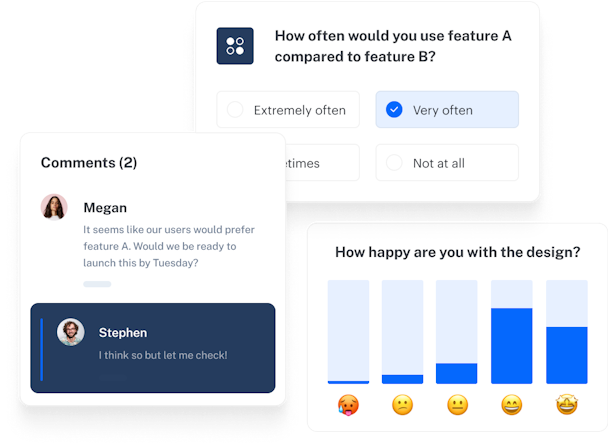
Market validation can benefit from usability testing because it allows potential users of the product to interact with it, while also giving their thoughts on the product itself and helping you to identify issues with ease of use and functionality.
Maze's usability testing features allow you to test ease of use and validate product ideas with your target audience rapidly. Learn more here .
This method is particularly useful if you’re conducting market validation for a new feature on an existing, proven product. You can include the new feature within the digital product the user is already aware of and test their responses to the new feature.
Search engine results and Google Trends
An easy way to gauge possible user interest in your product is by taking a look at online search results. This method involves seeing how many people are searching for particular phrases online each month with tools like Semrush or Ahrefs .
For example, let’s say your product idea is to create an online learning platform for people with autism. You could search for “e-learning” and “online video classes” to gauge the popularity of your industry and product, and then “online video classes for people with autism” to see how many people are already looking for your product.
The benefits of this method are that it’s a very quick and cheap method which gives you a general idea of the existing market interest in your product. You can even geolocalize results to see if there are countries with particular interest.
Another similar method is looking at Google Trends . This free tool allows you to see search patterns over time for particular keywords. While tools like Ahrefs and Semrush give numerical search volumes, Trends shows how search intent changes over a given period of time. For example, the Trends graph below shows a clear spike in interest for “online video classes,” coinciding with the start of lockdown measures imposed due to the 2020 Coronavirus pandemic. Seeing that your proposed product is steadily gaining in interest can help to validate it.
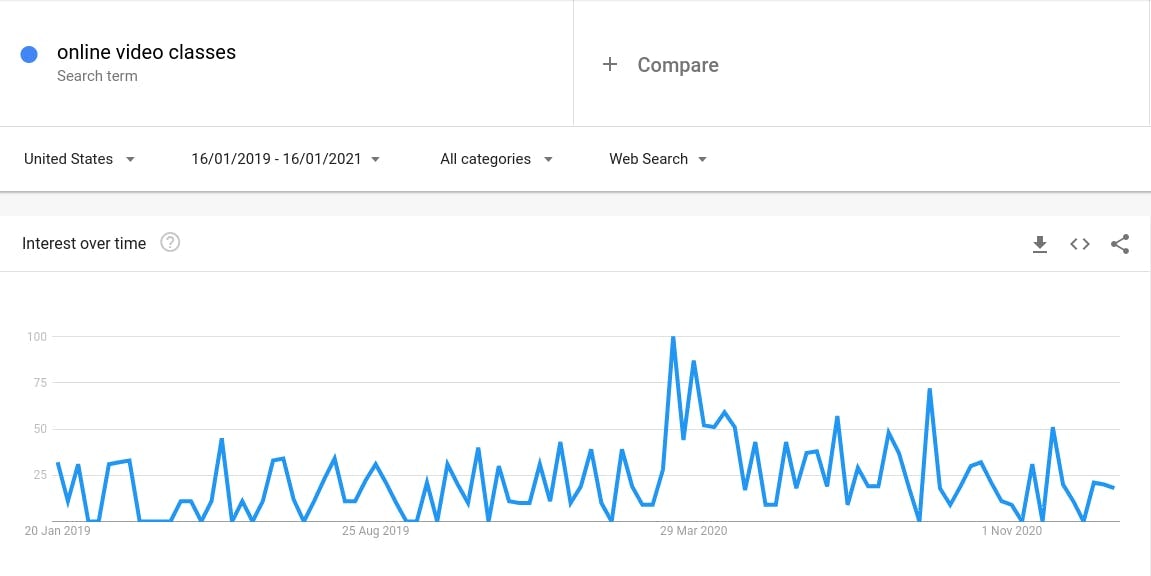
Google Trends results for "online video classes"
A/B testing paid ads
Finally, another market validation method is to A/B test online ads highlighting different aspects of your product. The point here is to see how much your users value particular product features, which can give insights on where future product development should focus.
Martín explains: "We sometimes do fake ads for Search Engine Marketing (SEM) tests. We compare a campaign that says 'The cheapest flights' and another that says 'The cheapest flights with free cancellation'. When you click, you get to the normal eDreams page, so if you see that the click-through rate is better for the second one, you see there’s value for 'free cancellation'."
This method can be used in tandem with others. For example, if you are running a Wizard of Oz test for a proposed new feature, then online ads can simultaneously be run to highlight the new feature. If there’s a clearly higher click-through rate for the ads with the new feature, then it validates the development of the feature as a digital product.
Market validation example: eDreams
For eDreams , market validation was essential while they were working on a project focused on offering flexible flight tickets. This came with several assumptions. They first tested if their target customers valued free cancellation on their tickets at all. While in theory, it seems like an obvious advantage for travelers, the assumption still needs to be tested.
After conducting market validation tests, they found that despite it being a big trend in their industry, customers didn’t initially see the value of flexible tickets. “We tested if people valued flexibility. The first reaction from people was ‘I’m paying this because I want to go to Rome, why would I want to cancel?’ So, it took us a lot of iterations and work to get people to understand the value of flexibility, like if your boss doesn’t approve your holidays, or if you get sick, or if there’s a worldwide pandemic,” said Martín.
eDreams worked to better explain the value of the flexible tickets and found that, with the correct context, explanation, and phrasing, these potential customers were indeed very receptive to the idea and did value flexible tickets.
These results are interesting and indicative of the value of market validation. Asking open-ended questions and listening to customers allowed eDreams to see that there was value in offering flexible tickets, but that it was unlikely to be successful in the way they initially planned to present it to customers.
Read on more usability testing implementation examples .
Continue reading
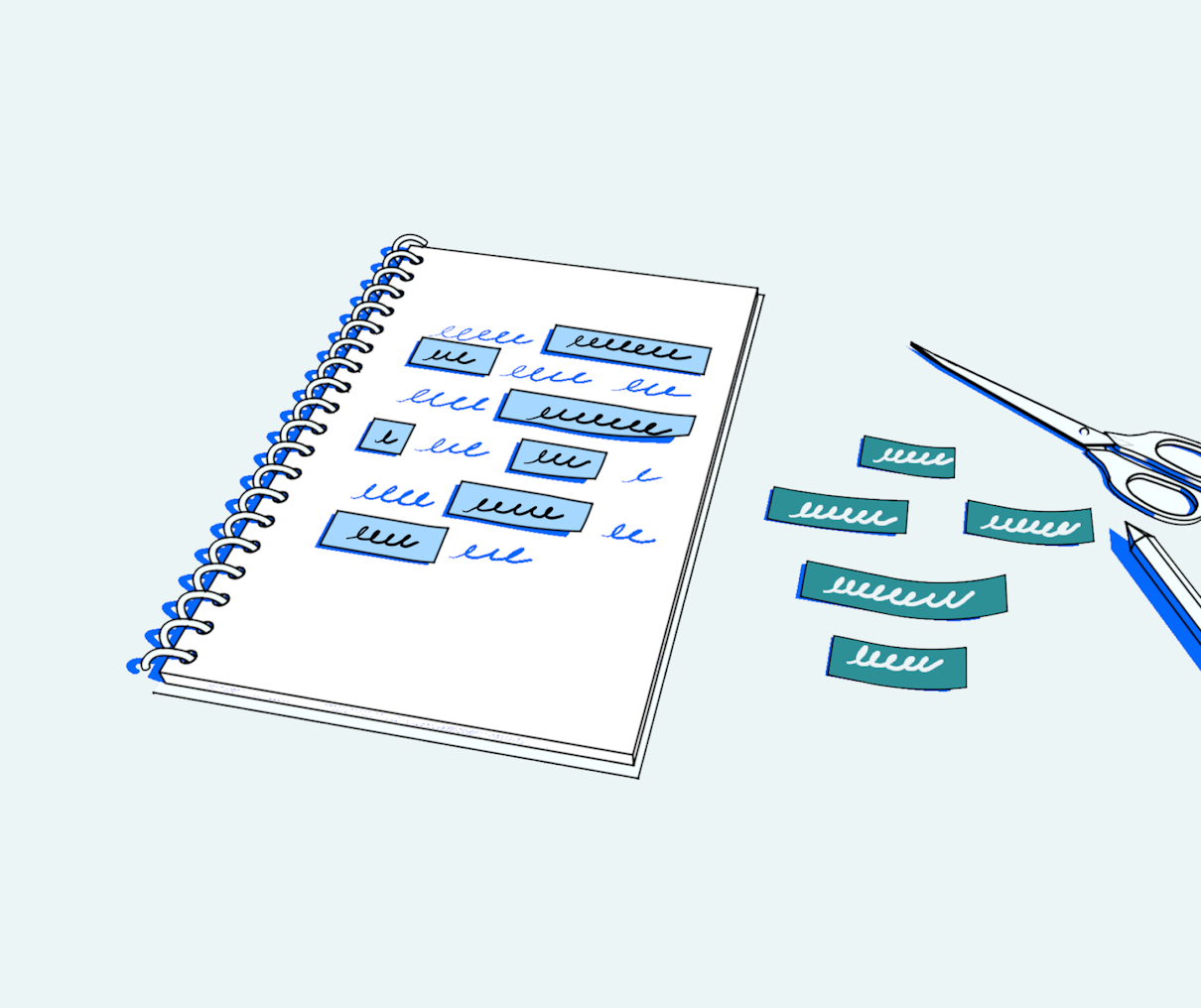
How to test marketing messaging: Validating claims with users before launch

Inside Maze
How to position your startup: A peek into our process and advice from positioning expert Hema Padhu
How to Perform Market Validation: A Step-by-Step Guide
It's essential to validate product ideas before investing time and money. Learn how to perform market validation and the user research methods that make it work.
How does that saying go, something like If wishes were business ideas, we would all have a few Fortune 500 companies under our belt ? Okay, perhaps I made that up, but maybe it should be a saying. After all, how often have you come up with an idea and thought it wasn't practicable, only to see it come to market some months later from somebody else? Or you don't know if your great idea is feasible, so you move on and forget about it? Or someone else thinks it's pie-in-the-sky, so you scuttle your idea off to the Dead Ideas folder on your computer?
Yet some ideas are clear winners. How can you tell which brilliant idea for a new product or feature is worth pursuing and which might not be as valuable or need more tweaking? Market validation research is a vital step between ideation and creation that can answer that question before you invest too much time or resources into it.
Let's take a deeper look at what exactly market validation is, why it's essential for companies before investing in ideas, when and how to conduct market validation research , and the methodologies that can help you get the market validation your idea or product needs to succeed.
What is market validation research?
Market validation is the process of testing a new product idea for viability to determine whether a product or feature is needed in your target market. Simply put, does the public have an appetite for your product? It is a crucial step to take between product concept ideation and product creation.
By testing the practicality and feasibility of a new product with the target market before investing time and resources into its development, you will have a better sense of what your users' needs are and whether and confidence in whether (or not) your product will fulfill those needs.
Market validation research can also help garner buy-in for your product or idea. Early validation will allow stakeholders—internal team members or external funders—to be confident in bringing your concept to market. Further, market validation research can allow you to tweak and hone your idea to better address any unmet needs or pain points your users may have.
Market validation is generally accomplished by identifying the buyers or users of your product in your target market and then interviewing or surveying them for direct feedback about their needs and pain points.
Why is market validation a vital early step in the development process?
Having what feels like a wholly intuitive and ingenious idea can often motivate moving fast to push it into development. However, anyone who's worked in product management has probably had the unfortunate experience of discovering that what sounded terrific in a product dev meeting doesn't stand up under real-world scrutiny. Why?
- Perhaps your target market would like your idea but not enough to pay for it
- Maybe it's not as big of a problem for your market base as your team supposes
- Maybe your target users would love your idea, but their companies don't find it to be a value add for their budgets
- Perhaps your users have already figured out an easy way to resolve the issue your product is addressing
By conducting market validation research before investing in the development of a new product, your company can help justify buy-in and funding for the product while avoiding the waste of a product failing to meet expectations.
The real-world value of market validation research is that it will help you uncover the blind spots you or your team may have when evaluating your ideas, unearth pain points for your target market that you might have glanced over, and help to finetune your thinking before an idea moves into development. After all, running market validation research and finding out your idea is a clunker is much less expensive than developing and marketing an idea that underperforms expectations.
What research methodologies are used in market validation?
Many methodologies can be employed for market validation research, each representing advantages and disadvantages. Some lean towards quantitative data to provide a high-level understanding of the market, while others are more qualitative and can give you an idea of what users in your target market feel and think about the product. When choosing which methodologies might be best for your product, the goal is to employ multiple methods to give you a richer and more complex view of the market. First, let's look at the most common methods.
Surveys, focus groups, and interviews
Depending on whether the questions you ask your subjects are open or close-ended, surveys, focus groups, and in-depth interviews can give you both qualitative and quantitative data directly from your target market of users.
Additionally, each method provides the flexibility to learn in-depth feedback directly from interview subjects and gather data that can give valuable direction to your project. Surveys offer the opportunity to collect large amounts of data at one time. Focus groups and interviews can allow you to drill down quickly when you discover specific pain points your target users experience.
Observational research
In observational research, you have your testers interact directly with your product and take note of their actions, behaviors, frustrations, holdups, habits, and pain points, often without giving them much direction. This is often helpful information for products with a less tech-savvy market base. It can also be beneficial if you've run alpha and beta testing and find disparate data from your two user groups.
Usability testing
Which leads us to usability testing . Like observational research, usability testing requires observing how users interact with your product following a determined set of steps while you watch and record their reactions and issues.
When users can directly interact with and comment on your product in an observational setting, you can assess how easy to use your product is, how useful the functionality might be, and how receptive your test market is to changes you've made.
Building out a minimum viable product (MVP)
Developing the minimum viable product (MVP) would be one of the last steps of market validation you and your team might take. That's because an MVP is your product's basic, physical version that can still offer usefulness to your users. However, producing one can represent a significant outlay of resources and costs—both in time and financial investments—so not every project or company will find building an MVP practical.
If you are working on a first product, rather than a new feature, say, it could be sensible to produce an MVP early. Not only will this allow you to have a basic version of your product to market validate with test consumers, but you can also begin making revenue from an early version while fine tuning your product.
A/B Testing
One way to evaluate how much value a new feature for an existing product might add is by running A/B testing ads designed to test how many click-throughs you get for one idea compared to another. For example, suppose we were thinking about adding a feature to our verified research participant database that offered AI to complement traditional surveys. In that case, we could set up an SEM test with a campaign that offers "Verified research participants tailored to your needs" and compare it to another campaign offering "Verified research participant recruiting powered by AI insights."
By comparing the number of click-throughs each ad garners, we could have constructive insights into whether there's a desire or value in adding AI to our product. You can also tailor the landing page the ads take a user to garner even more validation of a product's potential value based on clicks, impressions, and conversions to compare results from each.
Prototype testing
Prototype testing can be a valuable tool in your market validation toolbelt for allowing test users the means to have meaningful interactions with your product. For usability testing, having a prototype available for users to interact with can give you keen insight into how the product works in real-life settings, possible UX/UI issues, timely feedback on design issues before full development, and a better understanding of how your users interact with your product.
Utilizing SEO results and Google Trends
One of the simplest ways to begin market validation is to use free/low-cost tools your organization likely already has access to. Just like you'd check your SEO results frequently after you launch a new project, you can also utilize them before building your product to gauge what your user base's interests, needs, and pain points are by using Google Trends and SEO tools like Semrush , MOZ Pro , or Ahrefs .
By investigating how often particular keywords and terms associated with your product are being searched, you can get an easy view of what your user base needs and where your product does or doesn't meet those needs and monitor growth in interest over time and location.
The market validation step-by-step guide
Step 1 – define goals, assumptions, hypotheses, and target customer.
- Define your goals clearly
- Identify your target market
- Highlight any untested assumptions
- Identify unmet needs your customer base may have
- Define your unique value props
- Develop your hypotheses
The first step is to identify your goals for your product. Having a clear view of what you expect to accomplish, you can then clarify any plans that may still be assumptions that need to be verified.
Next, clearly define your target market for yourself. This will help you move on to the next step, which is documenting your hypotheses about the function of your product, how you will produce it, the pricing model, and so on.
Once you have a handle on your target consumers, define your unique value propositions, what makes your product useful, necessary, or unique, and how it meets your users' unmet needs. When you have a keen understanding of these things, you'll clearly understand what you will need to test with market validation research.
Step 2 - Assess the market size and share/competitive landscape
Next, get a fuller idea of your market size, the share that you think you could reasonably capture with your idea, and who your competitors in the market are.
Start broadly by researching the industry, its annual spending, and how your unique value props may disrupt that.
Utilize SEO search volume tools to better understand the demand for your product and how you can best capitalize on that demand to make your product stand out against competitors.
Step 3 - Perform customer validation research
Your next step involves getting into the nitty gritty and performing customer validation research that will give you actionable insights into what your target market segment needs–their pain points- and how your product can potentially alleviate these needs.
This will often involve conducting interviews with your target market by finding research participants to conduct interviews, holding focus groups, or gathering data via online surveys. You're looking to answer a few basic questions at this stage. That is:
- What are the pain points or unserved needs your market segment is encountering?
- What are their motivations and preferences?
- How are your competitors' products leaving these needs unmet?
- What are the workarounds they've developed to try to meet these needs themselves?
- Are they able to solve this/these problems?
- What is their level of satisfaction with the products they currently use?
- Would your product be useful as a solution?
- Are there any assumptions or hypotheses you originally created that need user feedback?
- Is there a feasible monetization of your solution for their needs?
When beginning this kind of research, you'll also need to look at what success means for your product by clearly defining your success criteria. First, understand what user responses will define success for your product or idea. Do this by looking at what percentage of respondents experience specific pain points, what percentage find your product idea to be a viable solution for their particular problem or problems, and what percentage would realistically pay for your product to solve their problems.
Next, analyze the data that you've gathered. Go back to the list of hypotheses and assumptions you created. You may need to revise your original assumptions. This could also be where you realize there isn't realistically a market for your product or idea, and that's okay, too. Ask yourself, if this isn't the solution our market base is looking for, what is? Work to improve what you have to offer, and then you can revisit test market validation again.
Step 4 – Test your product
Once you have a reasonably strong idea that your idea could be a solution, you can move forward in market validation testing and research that takes more investment, such as prototyping or creating an MVP. After that, you'll want to move on to testing your product.
First, test your product with focus groups or interviewees who can give you granular data about how the product works and what might need to be finetuned. Utilize test groups who will realistically be real-world users to get a fair and representative idea of how your product will function in the marketplace. Then, utilize these insights to tweak and adjust your product as necessary.
Next, it often makes sense to conduct alpha testing for your product with internal employees in a controlled setting that will allow you to check for issues, identify bugs or quirks, and address them before making your product public.
Finally, you can perform beta testing by releasing your product to a small, limited set of external users, with the goal being to identify problems, glitches, or UX issues before a wider release.
Ultimately, don't we all just need a little validation?
We all understand the value of having our ideas validated in our personal lives. With new products and features, validation is a meaningful way of proving market value, gaining buy-in, and providing a bridge between ideation and development.
The goal for market validation is about more than building a Fortune 500 company overnight, unfortunately. However, if that's a vision you have for your future, taking the proper steps when taking a new product, startup, or feature to market is a small step toward achieving that. Instead, market validation research is a process that can help you make the best use of your resources and determine whether your product or idea is ready to push into development so that your company continues to produce the best version of every product it offers.

Subscribe to Research Works Newsletter
Receive a monthly review of UXR industry news, researcher interviews, and innovative recruiting tips straight to your inbox.
Webinar: Why User Research Is Crucial For Validating Product Market Fit
In this webinar, we delve into why it is critical for companies to validate product market fit by conducting user research prior to investing...
8 Key Steps to help find Participants for User Testing
Participant recruitment tactics, screening advice, marketing channels and five other aspects to consider when you want to find participants for user...
Screener Survey Guide: How to Screen for Unmoderated Studies
Screener surveys are an important tool for research participant recruitment. We have a guide to help you create effective screeners for unmoderated...

Market Validation: 7 Steps to Success + 3 Things to Avoid

Market validation is key for any business that’s serious about success.
Here, we provide an in-depth look at the essential steps to validate your product’s market potential . We’ll cover the fundamentals of market validation and equip you with the know-how to guide you through the process so you can validate your business idea.
What is market validation?
Market validation (aka business validation) verifies the potential success of a product or service. It’s a process of researching target markets , understanding customer needs, and testing the product or service with potential customers.

It’s like taking a product for a test drive and seeing if it runs smoothly! Through market analysis , surveys, focus groups, interviews, and competitive analysis , market validation can help you uncover the key data points you need for smart decision-making.
Why is market validation important?
Market validation uncovers data that helps determine if it’s worth investing your resources in a new venture or not. It helps you understand the market’s potential for your product and its demand. Whether doing research for a business plan , start-up , or launching in a new market , the business validation process is used to help:
- Assess the competitive landscape
- Identify customer needs
- See if your product or service can meet those needs
- Determine if your product is viable and profitable
All in all, market validation is a must for any business that wants to succeed.
Ten market validation examples
Market Research
Use a market research tool to understand the size, demographics , and trends of the market you want to target. This type of research can help companies determine the potential demand for their product or service and identify areas of opportunity.
Online Surveys
Surveys can be used to gather feedback on products or services from potential customers. Questions may include how customers currently solve the problem you aim to address, how important the problem is to them, what features they would like to see, and how much they would be willing to pay.

Competitor Analysis
Competitive analysis frameworks help you understand how a product stacks up against similar offerings from competitors. This process helps companies identify areas of improvement and develop strategies to gain an edge over the competition.
Focus Groups
Focus groups enable further testing of a product or service by gathering groups of potential customers to discuss the offering in detail. This type of research can reveal customer needs, desires, and preferences.

Usability Testing
Usability testing allows companies to evaluate the effectiveness of their product. It involves having real customers use the product, then give feedback on their experience. Usability testing can reveal the features that work well and those in need of improvement.
A/B Testing
A/B testing compares different versions of a product or service to see which is most effective. It involves running two versions of the product or service simultaneously. Results are then compared to determine which version is most successful.
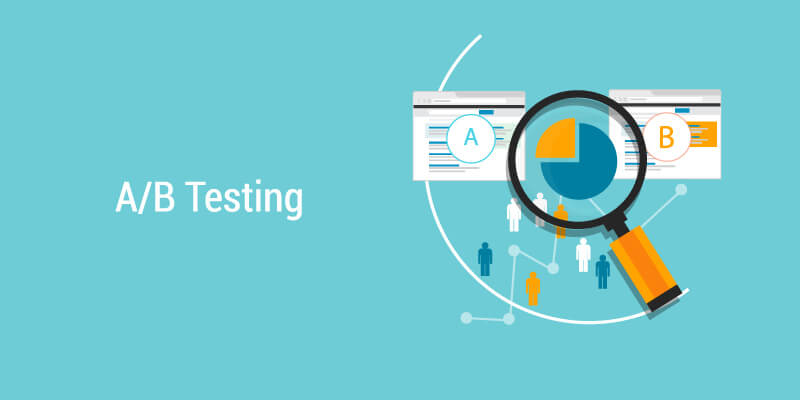
Customer Interviews
Interviews reveal insights into the customer experience by asking consumers about their needs, pain points and gathering product feedback. This helps companies understand what people truly want and need, which can, in turn, enable them to develop better products.
Social Media Monitoring
Social media monitoring can uncover customer conversations about a product or service. By monitoring what’s being said about products or brands in a market, those wishing to enter it can spot potential threats and opportunities to consider.
User Experience Research
Companies can use user experience research to evaluate how users interact with their products. This type of research can reveal areas of improvement and help companies understand how people use their products.

Beta Testing
Companies can use beta testing to test their product in a real-world environment. Beta tests involve having a group of people use the product, and providing feedback on their experience. It can help companies identify issues and make improvements before launching the product.
Three market validation mistakes to avoid
Pursuing the wrong ‘type’ of validation is something that even seasoned entrepreneurs and companies can fall victim to. Not all market validation is created equal, so I’ve outlined four key market validation mishaps to help you avoid the trap that is ‘fake validation.’
Validating your business idea with the wrong type of customers
Don’t be afraid to approach target customers for feedback by soliciting customers who are either too big or small for your market entry point. If your early customers are different from those you wish to target in the long term, it’s important to validate your idea at both ends of the market. If you fail to do this, it can impact short and long-term results; or put you on the wrong path altogether.
To this end, you must always ensure you have the right type, and variety of consumers validating your product.
Validating your idea without considering future international expansion
If you launch in the U.S and only do market validation in the U.S., you limit the potential for international success by performing limited domestic validation. International customers may have a completely different set of problems to solve; there could be regulatory nuances or rival firms that require a bigger consideration.
Always keep long-term goals in mind; if international expansion or new territories form part of your long-term plan, consider this when going through the market validation process.
Seeking feedback from peers or industry connections
Market validation shouldn’t always be comfortable. One could argue it’s most effective when feedback isn’t quite as complimentary as you’d hoped for. I’ll explain. Whether we look at the start-up scene in Tel Aviv or Silicon valley, for example, it’s easy to be sucked in by praise and positive feedback from those in your market.
Start Your Market Validation with Similarweb Today
Market validation in seven steps, 1: identify the problem.
- Research the needs of the customer base
- Identify unmet customer needs
- Identify what challenges customers face
2: Refine the idea
- Consider how to solve the problem
- Brainstorm solutions
- Evaluate potential solutions
3: Conduct surveys
- Develop survey questions to test the idea
- Send surveys to a targeted customer sample
- Analyze survey results
4: Identify potential customers
- Research customer demographics
- Identify potential customer segments
- Analyze customer profiles
Understand Your Audience with Similarweb from Similarweb on Vimeo .
5: Analyze the competition
- Research the competitive landscape
- Identify competitive advantages
- Analyze competitive pricing
6: Create a prototype
- Design a prototype that meets customer needs
- Test the prototype with potential customers
- Gather customer feedback
7: Analyze market potential
- Calculate the size of the customer base
- Estimate potential market share
- Analyze market trends and potential growth
After the initial work is done, it’s important to monitor your results and how they change over time. Similarweb Digital Research Intelligence can help you track competitors, consumers, and a market with ease.
How Similarweb helps with market validation
If you’re looking to validate a business idea, Similarweb can help with steps 4, 5, and 7 of the market validation process. Here, I’ll show you how to use it to understand the competitive landscape, learn more about a target audience , and gain valuable insights into your target market .
Market validation example: customer research
As we’ve discussed, there are lots of ways you can research customers for market validation. When you need to find and understand audience behavior fast, there’s no better way than through Similarweb’s suite of market intelligence tools.
From researching audience demographics , such as gender, age, and geographies , to seeing target audience interests and cross-browsing behaviors (the other sites or mobile apps they visit), Similarweb can help you comprehensively analyze an audience in minutes.
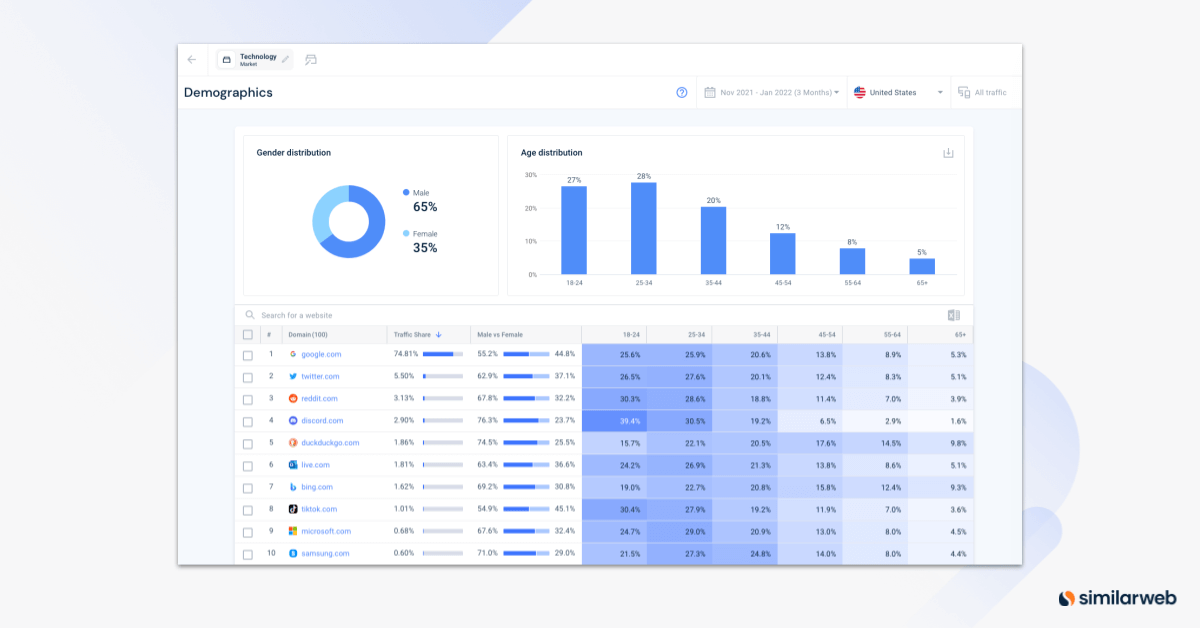
Here you can see the demographics for the Top 100 sites in the US tech sector over a 3-month period. Here, we see a split of website visitors, with 65% being male vs 35% female. The average age group is made up of 25-34-year-olds, which accounts for 28% of website visitors during this period. Further analysis can be done on any site, for any period or location.
Market validation example: competitive research
Where competitive intelligence is concerned, Similarweb is a powerhouse of a tool you need in your arsenal. Let’s say you want to enter a new market: you need to know who the key players and emerging disruptors are. This is point zero, it’s fundamental data you need to start any competitive analysis process.
First, I’m using Similarweb Industry Analysis to identify my market leaders and emerging players.
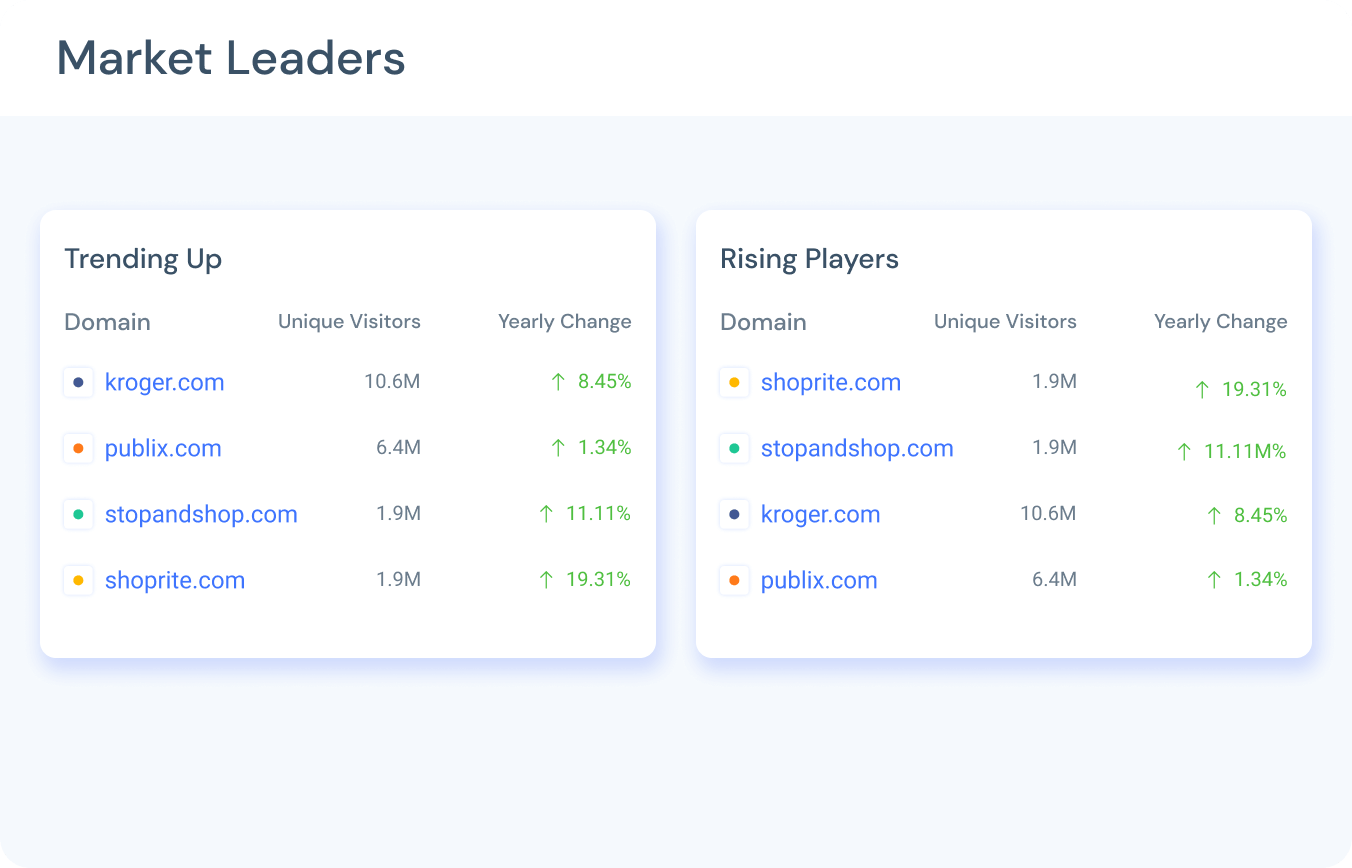
Now that I have my list of competitors to analyze, let’s take a look at the competitive analysis process.
To show you how easy it is, I’ve created a quick clip of our competitive analysis in action. In under a minute, I’ve used it to discover:
- Who the major competitors in a market are
- Which traffic channels are most effective in this market
- Generated a list of the right referral partners and advertisers in this space
- Copies of creative materials being used in competitor advertisements
- Discovered what content and pages are the most popular in this market
- The highest volume search terms in the industry
Here, we can see an overview of key traffic and engagement metrics for a chosen competitor. This includes things like total visits to its site, a link to any mobile apps it has, and a full breakdown of which channels its traffic comes from. I can quickly compare these stats against key rivals in the market, to see who is winning or losing traffic; and helping me identify which companies I’m going to analyze in more detail.
Market validation example: market research
Market validation requires you to calculate the market size, estimate your potential market share , analyze market trends . Similarweb lets you do this quickly, with dynamic data sets that represent the market as it stands today. Instead of relying on outdated market reports, you can cut to the chase and use modern digital analytics to get the most accurate picture of the market at any point in time.
With a metric known as traffic share , we can estimate the potential market size by showing the total reachable audience you have or could have with a product or service.

The best insights are dynamic in nature. They appear to show shifts, sometimes unexpectedly or can indicate growth and changing behaviors as the year progresses.
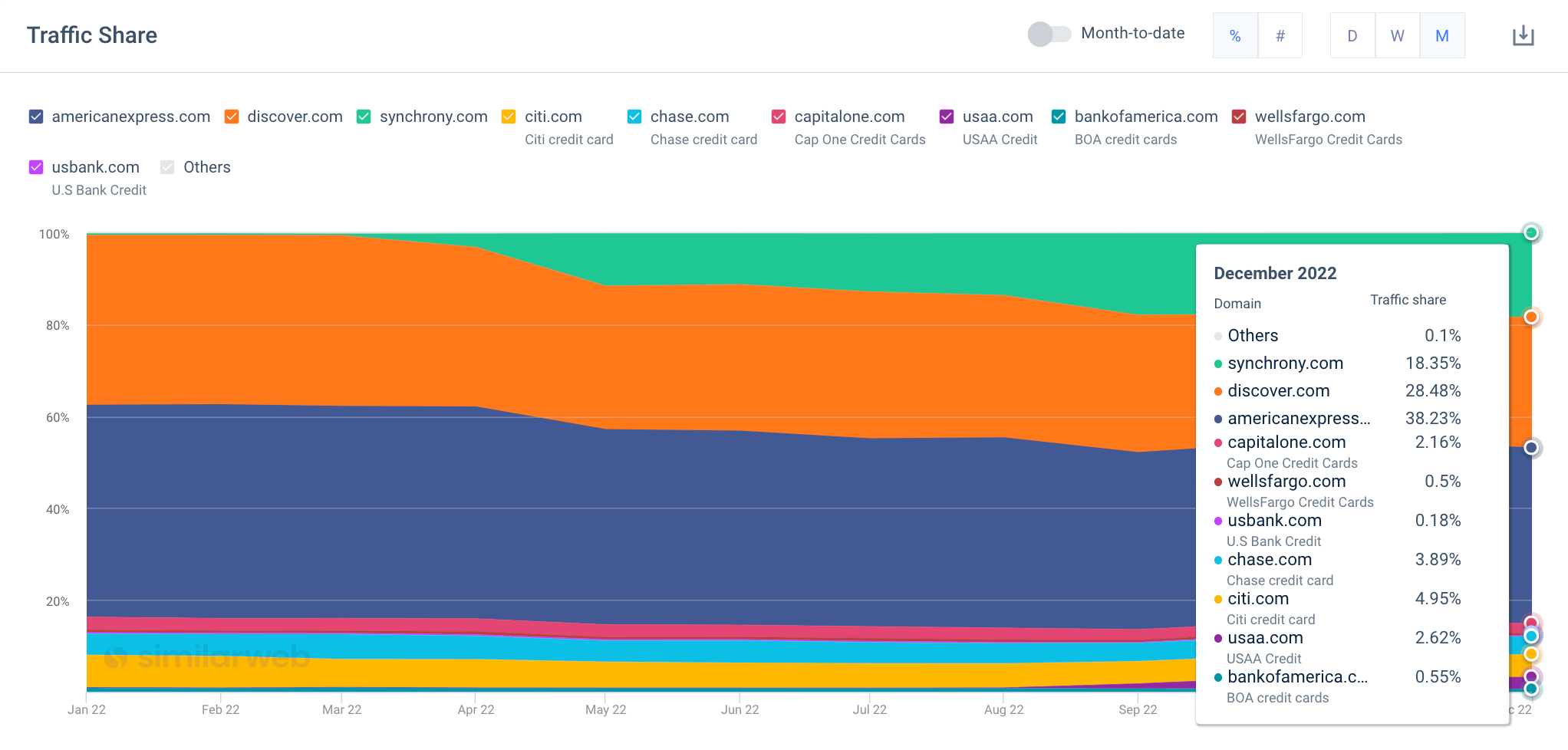
Helpful: Read more about how to size a market .
Market validation is the only way to determine whether it’s worth investing more time and resources into a new product or service. In seven steps, you’ll have the intel you need to know if your idea is worth pursuing, or not.
Similarweb makes market validation faster and easier. By helping you quickly understand the market, its key players, and consumers; get a handle on the size of the opportunity, you can get the answers you need to make data-driven decisions about launching a new product or entering a new market fast.
What is market validation? Market validation is the process of gathering consumer feedback to determine the potential success or failure of an offering in the marketplace.
What are some methods of market validation? Market validation can be done through surveys, focus groups, interviews, product testing, and analysis of customer behavior and preferences.
How can market validation help a company? Market validation can help a company assess the viability of a product or service before investing significant resources into it. It can also help a company determine if their product or service is meeting customer needs.
When should market validation be conducted? Market validation should be conducted at the beginning of the product development process and throughout the life cycle of the product or service.
What are the benefits of market validation? The benefits of market validation include gaining insight into customer needs and preferences, reducing the risk of failure, and increasing the chances of success. Market validation can also help companies better understand their target audience and fine-tune their offering to better meet their needs.
What can market validation tell us about our customers? Market validation can provide an in-depth understanding of customer needs, preferences, and behaviors. It can give businesses insight into how customers perceive their product or service, what they are looking for in a product, and what they value most. With this information, companies can better tailor their offerings to meet customer needs and maximize success.
Related Posts

From AI to Buy: The Role of Artificial Intelligence in Retail

How to Conduct a Social Media Competitor Analysis: 5 Quick Steps

Industry Research: The Data-Backed Approach
Wondering what similarweb can do for you.
Here are two ways you can get started with Similarweb today!

- Integrations
- Learning Center
Market Validation
What is market validation.
Market validation is the process of presenting a concept for a product to its target market and learn from those prospective buyers whether or not the idea is worth pursuing.
This process typically takes place early-on in the conception stage, before any significant investment has been made in developing the product.
The two most common approaches to market validation are:
- Interview people in the target market, such as the buyer and user personas.
- Send out surveys to these personas.
The key is that market validation research must include direct contact and feedback from people in the product’s intended market.
Why is Market Validation so Important?
There are many reasons why an organization conducts market validation before committing to the development of a new product or service. Here are some of the key benefits:
It helps secure funding and resources.
For an existing organization, the product management team would need to present its executive staff with evidence of market validation before execs green light the project and allow the product manager to begin assigning a budget, development time, marketing tasks, etc.
For an entrepreneur seeking funding for a new product idea, venture capitalists and other types of investors required evidence of market validation before agreeing to fund the entrepreneur’s company.
Beyond its ability to help teams secure resources to bring their product concept to reality, it’s an inexpensive way to uncover problems with your product idea.
When an organization comes up with an idea internally for a new feature or an entirely new product, the idea might at first seem viable, even ingenious.
But until that product team subjects its idea to a true test—for example, conducting customer validation interviews to learn whether or not they would be interested in the product—the team could be missing the following major flaws in the idea:
- Target users don’t need a standalone solution to solve the problem your product concept addresses and they’ve already discovered a simple and inexpensive workaround that they’re satisfied with.
- The consensus is while they like the idea, they don’t think it’s important enough to pay for.
- The companies in your target industries don’t allow enough budget for your solution.
For these reasons, even a good idea can fail to achieve the all-important objective of product-market fit . The more development work your team has done before you discover whether your product will fail in the market, the more expensive that failure will be.
The value of market validation is that your organization can uncover those problems before committing any significant time or resources to a product concept. That makes this the most inexpensive way to learn that an idea isn’t worth pursuing.

How do you Conduct One-on-One Interviews for Market Validation?
The market validation process varies by company. It’ll also vary by industry and the type of user persona the product team is seeking feedback from. Different demographics will have their own preferred methods of communication.
Here is an outline of the broad steps you will want to take:
1. Prepare a clear and simple explanation of your product concept.
Develop a straightforward and easy-to-grasp description of the product concept that you can quickly share in your customer interviews.
Part of this step will also include thinking through some key details such as:
- Who are your customers
- What specific problem you believe they have
- How the product would solve that problem.
Answering these questions will also help you with the next step, which is figuring out which people to interview.
2. Find your ideal interview subjects.
Now it’s time to build a list of people to interview. If you know people in the target market for your product concept, you can start with them. That’s a quick way to begin compiling feedback.The downside to this approach is that these interview subjects will be more subjective and biased than you need from your interview subjects.
As you broaden your search for target personas to interview, it’s important to communicate let what the target persona will gain in exchange for giving you their time.
For example, explain that if they agree to speak with you about your product concept, you’ll either invite them to be among the beta-testers of the product or they’ll receive the product for free for an extended period of time after the launch.

3. Create your interview questions.
This is an important step because the way you frame your questions can have a strong influence on how your target users perceive your product concept.
We recommend you focus your questions not on your product but on the problems facing your target users and how they currently deal with those problems today. Use open-ended questions. They let your interview subjects answer the topics in their own words.
For more guidance on interviewing, read our blog post on how to create customer interview questions .
4. Conduct the interviews.
You can generate viable market-validation findings from only a handful of in-depth interviews, assuming you have identified the right people to speak with. The more interviews, the greater the sample size, the better. That way you can see the broad patterns or even discover new problems for these personas that you hadn’t considered.
We recommend a single product manager lead these interviews because typically the product manager will have the deepest knowledge in the organization about the target persona, the market, and other important strategic details. But if you have lined up too many interviews for a single person to conduct—a high-quality problem to have—you can also share the responsibility with another product manager or even a product marketing manager.
It is very important, though, to make sure everyone running a market validation interview starts with the same questions. Then eventually each conversation will take its own path. That’s okay. But you need to make sure that each interview also yields answers to the same questions, so your team can intelligently analyze the data.
5. Make sense of the data.
After you’ve conducted all of your interviews, pull together the details of each to help you answer the key question:
Did the market validate my product concept as viable and worth investing in?
Look for patterns in the answers, such as:
- Your product solves a large enough problem that the market would pay to resolve it.
- Your target users haven’t found another solution yet to this problem.
- The industries you are targeting with this product concept do indeed have a budget to spend on addressing such issues.
If you find a trend of answers like these, congratulations, you might have a market-validated product concept! At this point, you’ll want to summarize this data in an easy-to-understand format. This can help you earn approval and enthusiasm from your executive team, your company’s other stakeholders across departments, and investors.
Market validation: no product development should begin without it
Many organizations are so enthusiastic about their revolutionary product idea that, in their rush to bring it to market before another company beats them to it, they skip the market validation process and jump straight into product development.
However, there might be a good reason that a competitor hasn’t already developed a similar concept. It might not have a large enough total addressable market. Perhaps most target users view the product as a “nice to have” but not worth paying for. Those users might already have another solution to the problem—one that doesn’t require any product. Or maybe the market has seen several failed solutions and is now unwilling to give a new product a try.
Your organization shouldn’t spend a significant amount of time or money developing a product that would fail. To ensure this doesn’t happen, you should always conduct market-validation research early-on in the concept stage of any new product. Uncover any problems before they become costly development mistakes!
Try ProductPlan Free for 14 Days
Share on mastodon.
- UX Consulting
- Industry Spotlight
- Competitor Differentiation
- Moderated Testing
- Unmoderated Testing
- Quantitative Testing
- Website Usability Testing
- Mobile App Testing
- Prototype Testing
- Accessibility Testing
- Multi-Channel Testing
- Branching Logic
- Participant Recruitment
- Private Label
- Think Aloud
- Content Testing
- Information Architecture
- Surveys & Quant Usability Testing
- Advanced Methodologies
- X-Second Test
- AI UX Analysis
- ULX Benchmarking Score
- Sentiment Analysis Tools
- Video Analysis Tools
- System Usability Scale
- BioSensor Tracking
- Whitepapers
- Case Studies
- Press Releases
- Help/FAQ Clients
- Help/FAQ Testers
- Get Paid to Test
- > Client Login
- > Tester Login
How to Do Market Validation – The Ultimate Guide
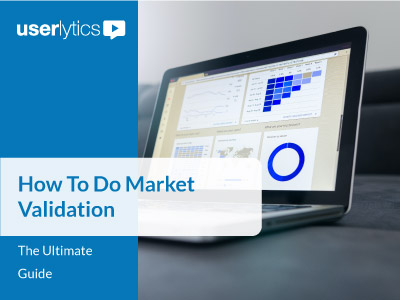
In this blog post, you will find: 1. What Is Market Validation? 2. Why Is Market Validation Important? 3. How To Do Market Validation? 4. What Is Lean Market Validation? 5. Conclusion – Key Takeaways
Launching a new product is no easy task -much can be lost between conception and reality. Companies today invest heavily in market research and intelligence, a distribution strategy, and a myriad of aspects that will ensure their new creation lands in the hands of their ideal customers.
However, there is one critical step that can save firms millions of dollars and help them gauge the feasibility of a product: Market validation. This is where dreams meet reality, and where brilliant concepts meet the verdict of the market.
In this blog post, we dive deep into what market validation is, why it matters, and most importantly, how to do it right.
What Is Market Validation?
Market validation, often referred to as product or market validation, is the process of testing and confirming the feasibility and demand for a product or service in the marketplace.
It is a critical step for entrepreneurs, startups, and businesses to determine whether their business or product idea is likely to succeed before investing significant resources.
Market validation involves collecting data and feedback from potential customers, target audiences, or relevant stakeholders to assess the viability and attractiveness of a business concept.
With market validation, you can answer the following critical questions:
- Is there a market need? Market validation aims to identify if there is a genuine problem or need that your product or service can address.
- Is there demand? It seeks to determine whether there is sufficient interest and demand for your offering within the target market.
- Is your solution viable? Market validation assesses if your proposed solution is practical, feasible, and likely to meet the identified needs.
- Can it be profitable? It evaluates the potential for profitability by examining pricing, cost structures, and market size.
Market validation typically involves a range of activities, such as conducting surveys, interviews, focus groups, and pilot tests. It may also include analyzing industry trends, competitive landscapes, and economic conditions.
The process helps entrepreneurs and businesses gather essential insights that guide decision-making, refine their business plans, and make informed choices about resource allocation, market entry, and product development.
Why Is Market Validation Important?
Market validation is a critical process for any company of any size. It helps reduce the risks associated with bringing a new product or service to prospective customers.
It provides valuable data and helps gain feedback on your product concept to make adjustments, pivot business ideas, or even decide not to proceed if the evidence suggests it’s not viable.
Conducting market validation tests can increase the likelihood of building a product that has a higher chance of success in the marketplace and turning prospects into paying customers -whether it’s a startup idea or a big company effort.
How to Do Market Validation?
Whether you’re a seasoned entrepreneur or just getting started, the principles of market validation will empower you to transform your concepts into thriving realities.
In this sense, the market validation process must be thorough and include critical variables and steps for it to be successful.
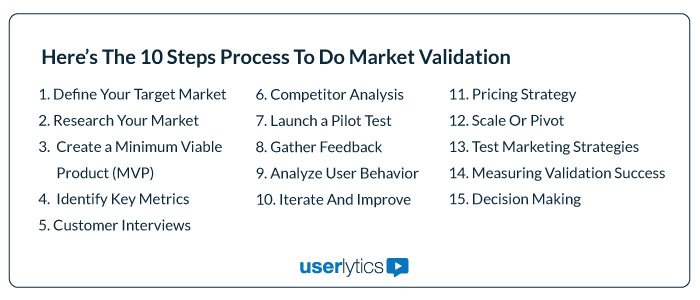
1. Define Your Target Market
Identify the specific group of people or businesses that your product or service is intended for. Understanding your target audience is crucial for effective validation.
To define your target market effectively when conducting a market validation test, start by thoroughly understanding your product or service. What problem does it solve? What are its features and benefits? What are its unique selling points (USPs)?
Then, do a segmentation. Divide the broader market into smaller, more manageable segments. Consider factors like demographics –age, gender, location– psychographics –lifestyle, values– and behavior –buying habits and brand loyalty. Segmentation helps you focus your efforts on the most promising groups.
Finally, create buyer personas for each segment. A buyer persona is a fictional representation of your ideal customer within a specific segment. It includes demographic information, pain points, goals, and preferences.
2. Research Your Market
Conduct thorough market research to gain insights into your target market. This includes analyzing market size, market demand, growth potential, competition, and current trends. You can use tools like surveys, online research, or industry reports to gather data.
Also, Clearly define the boundaries of your target market. Specify the geographic region, customer demographics, and any other relevant criteria that make up your market.
Collect data from multiple sources, including government statistics, industry reports, market research firms, and online databases. Look for data that is specific to your defined market boundaries and estimate the Total Addressable Market (TAM).
TAM represents the entire market for your product or service if there were no limitations or competition.
3. Create a Minimum Viable Product (MVP)
Develop a simplified version of your product or service, known as a Minimum Viable Product (MVP). The MVP should have enough features to test your core value proposition.
Ask yourself: What specific assumptions or hypotheses do you want to test? What are the most critical features or functionalities to include in your MVP to validate these assumptions?
Keep the design and functionality of your MVP as simple and straightforward as possible. Increasing complexity can lead to increased development time and costs. Use placeholders or wireframes to represent non-essential features.
4. Identify Key Metrics
Determine the key performance indicators (KPIs) that will help you measure the success of your product in the market. Common KPIs may include user engagement, conversion rates, and customer satisfaction.
Select KPIs that are directly related to your objectives and hypotheses. KPIs should be relevant and actionable, providing insights into what you want to validate.
Define the success and failure criteria for each KPI. What specific data or metrics will indicate that you’ve succeeded in validating your hypotheses? This ensures that your KPIs have a clear benchmark.
5. Customer Interviews
Conduct in-depth interviews with potential customers to understand their pain points, needs, and desires. These insights can help fine-tune your product. Securing qualitative data during your market validation research via e.g. usability testing is essential.
Through one-on-one interactions, you can tailor questions to individual participants, leading to personalized insights. This level of customization helps you uncover specific nuances in user behavior and preferences.
Interviews provide context that surveys and quantitative data often lack. Participants can explain their responses, offering you a richer understanding of their thought processes and decision-making criteria.
6. Competitor Analysis
Assess your competitors’ offerings and customer feedback. Identify gaps in the market that your product can address better or differently.
By studying competitors, you can identify gaps or opportunities that your product can address better or differently. This can be the basis for your unique value proposition.
Analyzing competitors allows you to benchmark your potential performance against established players in the market. It helps you set realistic expectations and goals.
7. Launch a Pilot Test
A pilot test allows you to gather feedback and data from actual users in a real-world environment. This feedback is invaluable for understanding how your product performs and how it is received by your target audience.
Further, pilot testing helps you gauge user engagement and adoption rates. This data provides insights into how well your product resonates with your target audience and whether it fulfills their needs.
Introduce your MVP to a limited audience within your target market. This can be a select group of customers, a specific geographic area, or a controlled online platform.
8. Gather Feedback
Encourage pilot users to provide feedback on their experience with your product. This feedback can help you identify what’s working well and where improvements are needed.
User feedback helps validate or challenge the assumptions and hypotheses that underlie your business concept. It provides real-world data and insights from potential customers, confirming whether your ideas align with the actual needs and preferences of your target audience.
Further, user feedback facilitates iterative improvement. By making incremental changes based on user input, you can refine your product and market strategy over time, increasing the likelihood of success.
9. Analyze User Behavior
Monitor how users interact with your MVP. Analyze data to see if users are engaging with your product as expected and if they are finding value in it.
User behavior data assists in prioritizing features and functionalities. It helps you identify which features are most frequently used and valued by users, allowing you to focus on what matters most.
Analyzing user behavior reveals where users drop off or encounter obstacles within the product. These bottlenecks can signify issues that need to be addressed, whether they are usability, performance, or content-related.
10. Iterate and Improve
Use the feedback and data to make necessary adjustments and improvements to your product. Continuously iterate to align your offering with market needs and user preferences.
Test the iterations with a subset of users or a smaller target audience. This may involve conducting A/B tests, pilot tests, or releasing a new version of the product with the proposed changes.
11. Pricing Strategy
Test different pricing models and gather feedback on pricing from your target customers. Assess their willingness to pay and determine the optimal pricing strategy.
Begin by thoroughly understanding your costs, including production, operational, and marketing expenses. This information is essential for setting a profitable price point.
Also, research and analyze the pricing strategies of competitors offering similar products or services. This provides a benchmark for your own pricing model.
It’s important to create different pricing tiers or options based on the value and features your product or service offers. Ensure that each tier corresponds to a specific user segment or need.
12. Scale or Pivot
Depending on the results of your validation, you’ll need to make a decision. If validation is positive, consider scaling your business. If not, be open to making significant changes, pivoting your idea, or even starting over with a different concept.
So, carefully analyze the feedback you’ve gathered from customers, users, and the market. Pay attention to recurring themes, pain points, and suggestions. Look for patterns that suggest either strong demand or significant challenges.
Determine if your product or business concept has achieved a solid product-market fit. Product-market fit means that your product effectively solves a real problem for a significant portion of your target market. If you have not achieved this fit, it may be time to pivot.
13. Test Marketing Strategies
Experiment with marketing tactics, such as digital advertising or content marketing, to see which approaches generate the most interest and engagement.
When doing this, clearly define your Unique Selling Proposition (USP). What sets your product or service apart from the competition? Ensure your marketing strategy highlights this unique value.
Establish specific marketing goals and objectives for your market validation phase. Are you aiming to test user acquisition, conversion rates, or customer engagement? Clear goals guide your strategy.
14. Measuring Validation Success
Regularly evaluate your product’s performance against your defined KPIs. If the results meet your expectations and validate your initial hypotheses, it’s a positive sign.
15. Decision-Making
Based on the collected data and feedback, make informed decisions about whether to move forward with your product, make adjustments, or pivot your business idea.
What Is Lean Market Validation?
Lean market validation is a startup-focused methodology for this type of company. The following are the lean market validation principles:
- Hypothesis-driven: Lean market validation begins with the formulation of clear and testable hypotheses about the target market, customer needs, and the product’s value proposition.
- Minimum Viable Product (MVP): Instead of developing a full-featured product or service, lean validation emphasizes the creation of a minimum viable product—a simplified version that addresses core customer needs. This MVP is used to gather real-world feedback.
- Continuous feedback: The process involves a feedback loop, where the MVP is released to early adopters or a small group of potential customers. Feedback is collected and analyzed, helping to validate or invalidate the initial hypotheses.
- Iterative approach: If the feedback indicates the need for changes or improvements, the development team iterates on the MVP and retests it with customers. This iterative approach continues until product-market fit is achieved.
- Data-driven decision-making: Data and metrics are central to lean market validation. Key performance indicators (KPIs) are monitored to assess the product’s success, user engagement, and other relevant factors.
- Waste reduction: Lean market validation aims to reduce waste, both in terms of time and resources. It focuses on creating value for customers while avoiding unnecessary development or marketing efforts.
- Rapid learning: The goal is to learn quickly and adapt. If the MVP doesn’t resonate with customers, the startup can pivot to explore a new direction or make incremental changes.
- Customer-centric: Lean validation places the customer at the center of the process. It’s all about understanding customer needs and preferences and refining the product to meet those needs effectively.
- Cost-efficiency: By starting with a minimal version of the product and validating its potential in the market, lean validation helps startups manage costs and reduce the risk of overinvesting in an unproven idea.
- Scalable growth: Once product-market fit is achieved, a lean startup can scale more confidently, knowing that there’s a demonstrated demand for the product.
Conclusion – Key Takeaways
Market validation is where innovation meets reality. It’s the moment when brilliant ideas are submitted to scrutiny to edge your product even closer too success.
Through rigorous testing, feedback, and adaptation, you’ve honed your vision into something the world truly wants. Listen to your customers, pivot when needed, and never stop fine-tuning your moves.
Want to Start UX Testing for Free?
Data visualizations, related posts:.
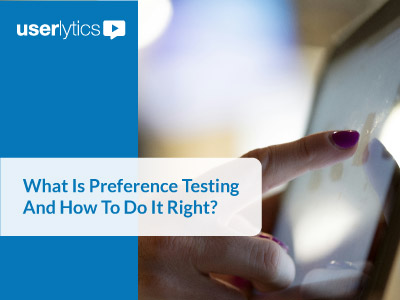
What Is Preference Testing And How to Do It Right?

9 Tips On How To Recruit Participants For A UX Study

9 UX Research Books for Designing Better Products
Didn’t find what you were searching for.
Let’s say you’re developing a new website or mobile app. The exciting part of developing a visual identity is upon you and you’re hesitating between different fonts, colors, typographies, placements of buttons, etc. You choose the one that appears the coolest to you. After all, it’s your website or app, right? This is where the… Read More » What Is Preference Testing And How to Do It Right?
The effectiveness of your UX research is deeply influenced by the relevance of your user testing participants. Imagine creating a blockbuster movie where the ensemble of actors, the narrative, and the screenplay must harmonize perfectly to craft something exceptionally good. In UX research, recruiting participants for a study who mirror your target audience is essential… Read More » 9 Tips On How To Recruit Participants For A UX Study
In making great products and keeping users happy, there’s one golden rule: never stop learning. Enter: UX research books! User expectations shift as rapidly as the technological landscape, therefore staying ahead of the curve is crucial. Keeping your UX research skills sharp is important, and equipping yourself with the knowledge of the best UX research… Read More » 9 UX Research Books for Designing Better Products

Let’s work together on your next UX study.
Create positive user experiences and keep customers loyal to your product and brand.
Analytics tells you what, Userlytics tells you WHY.
Market Validation: 7 Steps to Validate Your Business Idea
- 2 years ago
Did you know it can cost over $100,000 to develop a new product and up to $1.5 million over the next five years to bring a successful new product to market? That’s a lot of money to spend on an unproven idea. That’s why it’s important to conduct market validation before investing that kind of money.
Paul Akers has launched hundreds of new products with FastCap and he shared his wisdom with us. He shared tips on validating your idea, showing it to others, what not to do, how to perform lean market validation, and how to know whether the first reaction is just being nice or telling you that you hit the jackpot.
We’ll walk you through everything you need to know to gain a deeper understanding of market validation including the types of validation, validation strategies, the process you’ll go through, and finally judging whether or not you have a winner. Get ready to become a market validation ninja!
What is market validation?
Market validation is the process of verifying that there is a demand for a product, service, or business in your target market. The process is similar for all validating ideas, but depending on what you are trying to validate, there are slightly different steps that will need to occur before you go all-in on a product, business, or service.
What is idea validation?
Idea validation is simply confirming that potential customers agree you have a brilliant idea that will solve problems and eliminate pain points. You’ll want to t alk to people you trust and verify that they don’t think you are crazy. If they are potential users and they don’t think it makes sense, you can stop there with no money spent.
How to validate a product idea
When attempting to validate a product idea, the process will be similar to all other types of validation, but you will need to create either a minimum viable product (MVP) or a prototype. For those not familiar with the terms:
- MVP – a product that can be sold and meet the minimum expectations of the target market
- Prototype – a product meant to represent what the finished product will be like, but may not be as functional as an MVP
The difference is most noticeable in software products and other digital products. This is because pictures representing the product can be created for $500-$10,000, but the final product could cost as much as $1M. This is the most important part that conserves resources as you validate product ideas.
How to validate a business idea
Validating a business idea should be primarily focused on whether there is value to the idea, meaning does the business save others time, money, or other resources. In addition, business validation should attempt to identify the size of the target market.
For entertainment products, the validation should be whether the product entertains people and for how long. These are unique because the problem being solved is boredom and they are trying to fill the most time.
If the business involves a product, product validation should be conducted to establish the scope of the problem the product solves. This type of validation is typically going to be for smaller companies with more limited resources that are looking to create a unique value proposition.
How to validate a startup idea
If you are trying to create a product or service that will change the world, you’ll want to use a similar market validation process to other types of market validation. It will be on a much larger scale because your target market goes from 370 million to 7 billion people.
When you think of companies like Tesla and Uber, their target audience is global with far-reaching demands, and they play by different rules. You may have to validate the concept in multiple countries due to the different cultures and expectations.
If you have a startup idea, the prospective customers should be in the millions (or billions) and the payback period can be far longer because the solution has to grow globally before it can focus on profitability.
This type of company might not test a single product, but an entire local market to validate whether the idea will work in a region. Product idea testing will need to be on a much larger scale for the purpose of testing whether the expected customer base has an appetite for the solution.
What is business model validation?
The business model validation process is focused on a holistic view of the company and how it will operate. One of the best ways of planning it is Alex Osterwalder’s Business Model Canvas which consists of nine blocks:
- Key Partners – Who or what is the company teamed with and what benefits do they receive because of the partnership?
- Key Activities – What actions should the company take to deliver the value proposition?
- Key Resources – What resources are absolutely necessary to deliver the value proposition?
- Value Proposition – Products, Services, and what makes the company different. This is the center of the Canvas because everything revolves around it.
- Customer Relationships –How will the company interact with customers? Transactional, long-term relationship building, allow customers to serve themselves for a fee?
- Channels – What are the lines of communication and distribution that deliver customer value?
- Customer Segments – Which segments of the market do you serve and what is each customer segment like?
- Cost Structure – What are the financial costs that are absolutely necessary including fixed costs, variable costs, and costs associated with scaling?
- Revenue Streams – How will the company make money? One-time fee, pay as you go, subscription model?
Now that you know about the main types of market validation, let’s look at how to perform market validation research.
How to perform lean market validation research
Market validation research consists of a few main steps:
- Document the strategy.
- Identify the target market.
- Create tests.
- Get input from the target market.
- Analyze the results.
- Revise assumptions if necessary.
- Accept or reject assumptions.
Let’s discuss documenting the validation strategy
Step 1. Document the validation strategy
While doing research, I found two really phenomenal resources that I feel, when taken together, really communicate the essence of market validation and the differences in strategies that people can take.
The first is an article by Ryan Robinson and explains how he took an idea and $500 to test his product concept of a California trails guide. It explains the entire market validation process phenomenally well, but at 25,000+ words it is a long read. At UpFlip we try to pack as much value in 1/10th of the words.
The other is a PDF from Florida State University that spells out the entire market validation process in three steps:
- Document your assumptions with the business model canvas.
- Test your assumption by performing customer interviews, and keep revising your assumption until you get validation.
- Prove market traction through customer reviews.
The most important aspect of creating a strategy for market validation is providing a clear vision of the problem you are trying to solve, the product idea, the assumptions, and the market validation process.
Like other plans, a market validation plan should be in writing, but be flexible enough you can change it as you learn more about the market reception.
Keep reading to learn how to identify the target market.
Step 2. Identify the target market
You probably have a general idea of what the target market is, but you’ll need to do some online research to establish a more defined target market. At a minimum you’ll need to establish the following information:
- Is your target market people or businesses?
- What industry and/or job title are the people?
- Household income
- Special circumstances that apply to your target market. For instance, a wheelchair maker should be concerned with what people who need wheelchairs think about the product.
These should help you start creating user personas (fictional representations of your target demographic), but expect to revise each user persona throughout the process. Despite the benefits these create, Paul told us:
Revising as you go is an important part of running a business because you will never have complete data. Once you have this information, it’s time to move to the next step, creating tests.
Step 3. Create tests
There are a variety of tests that can be used for market validation. The most common are:
- Surveys – A list of unbiased questions to get opinions from the target market online or through the mail
- Interviews – Like a survey, but administered by a person via phone, video chat, or in-person
- Show a person two alternatives to see which they like better. Similar to how eye tests work.
- Have two different landing pages and send some people to one and others to the other to test which design people like more for software development or written content.
- Prototypes and MVPs – Tools to establish whether people actually like the product as designed before spending more on mass production
- Check Google Trends – A website that analyzes trending searches on Google to verify if there is demand for what you are trying to create
Paul Akers told us:
Check out our interview with him about how to come up with great ideas and validate them.
Paul also talks about market research in the video so we’ll discuss it for a minute.
Performing Market Research
You need to understand a little about market research to perform market validation, so here’s some tips.
- Open-ended questions tend to get people to talk more.
- Too many interviews increase costs, while too few increase the margin of error.
- You want to know “What problem does the product solve?”
- Those with the deepest knowledge on a subject give the best input.
We went into much more detail about surveys and interviews in our Hub article about how to perform market research , but it should be noted:
For most companies, you’ll want to use each method during different stages of validation. For instance, you might want to start with online surveys before designing a prototype, then do interviews so the participants can try the prototype. Then use a style of A/B testing to verify which type of packaging, pricing, or web design works better.
Check out our hub article about how to perform market research for more detail about surveys and interviews. Next, we’ll provide some sample questions to include during surveys.
Survey Questions
Some of the questions you might want to ask include:
- How would you expect to use this product?
- How often would you use this product? Why?
- What features do you think should be added to this product?
- What features do you think should be removed from this product?
- Where would you expect to find this product?
- How much would you pay for this product?
Once the questions and other tests are ready, it’s time to get input from your target audience.
Step 4. Get input from your target audience
The next step is to share information with your target audience. Using Facebook ads, your current mailing list, or your personal network is normally a good way to start as long as they fall within your target market.
Existing companies should consider paying customers that use a current product or service for input. Customer input is crucial for a new product concept or feature because they are part of your target market. Real users will already be familiar with your pricing model and can give better information about the product-market fit.
If you are using Facebook ads, make sure you are collecting their name, email, and phone number so that you can follow up with them. This is especially important if you are using a longitudinal study that tracks people’s perceptions over time.
Why is customer feedback valuable during market validation?
When users provide feedback about the solution through multiple phases of the market validation you:
- Reduce costs
- increase users’ knowledge
- Provide the team with in-depth interviews and insights
You might find this very valuable because the users will already be more familiar with the feature set than getting new users after the first few interviews. After you have gathered data, the next step is to analyze the results.
Step 5. Analyze the results
After you have gathered data from interviewing people, it’s time for the product team to analyze the data from interviewing customers and other prospective users. Most information will be qualitative data, such as what new feature would be best for a good product-market fit.
There may be some difficult math involved when testing how features and pricing will impact customers’ perceptions, product success, and revenue. Those calculations are the topic for another blog though. (If you want a blog about mathematical modeling let us know!)
Once you’ve analyzed the results of the interview questions, it’s time to determine if the testing validated whether your concept has value, doesn’t have value, or needs more feedback.
Step 6. Revise Assumptions (If Necessary)
After analyzing the results of your market validation, you may find that you don’t have a solid yes or no answer. In that case, you need to look at your assumptions and see if you can narrow them down. This may include:
- Following up on interviews
- Looking for patterns you may have missed
- Considering if there is a target market that you should add or subtract
- Using a different form of market validation
If you need to do this, make sure to do it. While the additional cost may seem too expensive, it is far less expensive than manufacturing and marketing a product that will flop.
Step 7. Did you get market validation?
You now have feedback on your solution and are ready to decide if users validated your idea or not. While you may have a sense that the test should be either a yes or no answer, this is not the case. There are actually three possibilities that should signal success during the testing:
- The test is a success if the feedback shows there is no market fit during early-stage research.
- The market validation is a success if the product-market fit shows that the product solves users’ pain points. This means the project can continue to the next phase in the strategy.
- Testing shows more questions need to be asked before the product manager passes the project on to manufacturing.
Paul gave the following example:
“When you ask someone what they think, they are likely to give you three answers:
- ‘It doesn’t make sense,’
- ‘That’s cool,’
- ‘How much can I buy it for?’
Only one is a real winner because when people say ‘that’s cool’ they might be trying not to hurt your feelings.”
What to do after you get market validation
We hope this information helps you test to see if your business is market-ready. If you decide to move forward with your business idea, you should read our blog on how to write a business plan . Alternatively, check out our blog on how to start a business or return to the business hub .
We love readers’ feedback. What market validation techniques have you found the most success using?
Brandon Boushy
Brandon Boushy lives to improve people’s lives by helping them become successful entrepreneurs. His journey started nearly 30 years ago. He consistently excelled at everything he did, but preferred to make the rules rather than follow him. His exploration of self and knowledge has helped him to get an engineering degree, MBA, and countless certifications. When freelancing and rideshare came onto the scene, he recognized the opportunity to play by his own rules. Since 2017, he has helped businesses across all industries achieve more with his research, writing, and marketing strategies. Since 2021, he has been the Lead Writer for UpFlip where he has published over 170 articles on small business success.
Related posts
- September 27, 2023
How to Start a Business: The Ultimate Guide (2024)
- August 3, 2022
Free Business Plan Template (With Examples)
- May 3, 2022
How to Get a Business License (In 3 Steps)
Join the discussion cancel reply.
Save my name, email, and website in this browser for the next time I comment.
This site uses Akismet to reduce spam. Learn how your comment data is processed .
Compare listings
Reset Password
Please enter your username or email address. You will receive a link to create a new password via email.
Market Validation
Want to get help with market validation from a mentor.
Are you a business owner or an entrepreneur with a great product idea?
That’s fantastic!
But hold on, have you given any attention to the market viability of your product?
Knowing whether there is a market for it is just as important as having a fantastic idea. Market validation has a role in this.
How can you determine whether a market exists for your product? Who could be your future clients? What are their preferences and needs?
We’ll address these and other issues, as well as demonstrate how market validation can improve your chances of success.
Why market validation matters

Market validation enables businesses to stay on the right path, optimize resources, and avoid costly mistakes.
Let’s explore the key reasons why a market validation plan is a must for startups and businesses alike:
Identifying genuine demand
Market validation is crucial for startups and businesses because it helps figure out if there’s actual demand for a product or service. It’s a way to see if you’re on track before investing tons of resources.
Informed decision-making
By examining customer needs, market validation enables businesses to make smarter choices. This process uncovers market gaps and areas for improvement, leading to higher customer satisfaction and loyalty.
Effective resource allocation
Market validation supports prioritizing development and marketing efforts. Understanding the market’s needs helps maximize ROI and can even lead to strategic partnerships with other market players for mutual benefits.
Avoiding risks
Skipping market validation can be risky. You might launch a product that doesn’t resonate with your audience, wasting resources, causing financial losses, and damaging your reputation. Plus, you risk missing out on growth opportunities and overlooking competitors.
When should market validation be done?
Market validation means presenting a product concept to the target market that teaches the potential purchasers whether it is worth trying out.
This typically happens during a development period early on and does not involve substantial investment to develop the prototype version or product itself.
Market validation process
The time has come! Let’s delve into the core aspects of this valuable process.
Follow the step-by-step process to start finding your product market fit and validating your new or startup idea:

- Target market research and analysis: First, it’s essential to conduct thorough research on your target market. This involves gathering data on customer needs, preferences, and pain points. By examining existing market trends, industry reports, and competitor activities, you’ll gain a comprehensive understanding of the market landscape.
- Define your target audience: Next, pinpoint your target audience by identifying their demographics, psychographics, and behaviors. This will allow you to create customer personas crucial for tailoring your product or service to meet the specific needs and wants of prospective customers.
- Hypothesis testing: Formulate hypotheses about your product or service’s unique value proposition, pricing, and target audience. Then, test these assumptions through surveys, customer interviews, or focus groups. This step helps validate your offering’s relevance and appeal to potential customers.
- Prototype and Minimum Viable Product (MVP) development: Develop a prototype or MVP that reflects your product’s core features. This early version enables you to gather real-world user feedback, allowing you to refine and improve your offering.
- Iterate and adapt: Based on qualitative data and on the feedback and insights gained from earlier steps, make necessary adjustments to your product or service. Keep iterating and refining your offering to ensure it continually meets your target audience’s evolving needs and preferences.
Market validation methodologies
Market validation methods are diverse and can be tailored to your specific product or service.
Here are some common market validation methods to consider when validating your market:
- Surveys: Create online or in-person surveys to gather quantitative data from a large sample of your target audience.
- Interviews: Conduct one-on-one interviews to obtain in-depth qualitative insights and understand the pain points and preferences of potential customers.
- Focus Groups: Organize small group discussions to encourage conversation and obtain diverse opinions on your product or service concept.
- Observational Research: Monitor user behavior and interactions with your product or service in real-world settings to identify potential improvements.
- Prototyping: Develop a prototype or mock-up of your product to collect hands-on feedback from potential users, allowing you to make necessary adjustments.
- Minimum Viable Product (MVP): Launch a simplified version of your product or service to a limited audience, gather real-world feedback, and iterate based on the findings.
Market validation research common mistakes

We understand that founders and entrepreneurs can be quite eager when delving into research for their companies and products.
However, it’s important to remain vigilant, as this enthusiasm can sometimes lead to a few common mistakes that could throw a wrench in your plans.
We prepared a list of some pitfalls you should steer clear of:
- Skimping on research: Don’t cut corners on market research! Make sure you truly understand your customers and competitors. Dig deep into industry trends and data to get the full picture.
- The friends-and-family trap: While your loved ones might have opinions, they may not be the most objective or representative of your target customers or market. Reach out to a diverse range of potential customers to get the most accurate insights.
- Brushing off negative feedback: No one likes criticism, but don’t ignore it! Embrace negative feedback as a chance to improve your product or service. It’s like a free cheat sheet for success!
- Underestimating competitors: Keep an eye on your competition and stay in the know about what they’re up to. Knowing their moves helps you innovate and stand out in the crowd.
- Sticking to the script: Be ready to roll with the punches! Adapt and make changes based on the feedback you receive. Flexibility is your friend when it comes to your market validation processes. A product manager should be careful when it comes to updating prioritization. Make sure to focus on the changes potential “super user” will mention.
- Racing through the process: Slow and steady wins the race. Market validation isn’t a sprint, so don’t rush through it. Take the time to test and refine your offering for the best possible results.
Best practices for market validation
So, you’re ready to tackle market validation like a pro.
To help you on your journey, here are some best practices that’ll keep you on track:
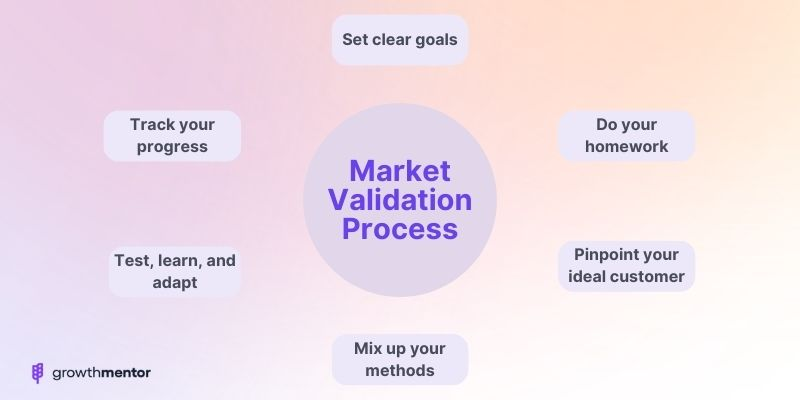
Set clear goals
Before you dive in, outline your market validation objectives. Knowing your goals helps you stay focused and ensures that your research remains relevant and targeted.
Do your homework
Dig into your target market, competitors, and industry trends. Don’t be afraid to get your hands dirty with data, as this knowledge will empower you to make informed decisions.
Pinpoint your ideal customer
Create detailed customer personas by identifying their demographics, psychographics, and behaviors. This info will help you tailor your product or service to meet their specific needs and wants.
Mix up your methods
Don’t just rely on one research method. Combine surveys, customer interviews , focus groups, and other approaches to gather diverse insights that’ll give you a well-rounded and deeper understanding of your market.
Test, learn, and adapt
Embrace an iterative mindset. Use your findings to refine your own product concept or service, and don’t be afraid to pivot based on feedback. Remember, the market validation process is all about learning and adapting.
Track your progress
Monitor your progress and keep track of how well you’re meeting your market validation objectives. This way, you’ll stay accountable and motivated to keep pushing forward.
Market validation stakeholders
In the market validation process, involving the right people can make a significant difference in obtaining valuable insights and driving success.
Here’s a list of key stakeholders you should consider involving:
- Product/Service Development Team: Designers, engineers, or developers who can provide input on product features and functionality, and make necessary adjustments based on feedback.
- Marketing Team: Marketers who can help identify target audiences, craft effective messaging, and strategize on marketing channels to reach potential customers.
- Sales Team: Sales professionals who understand customer pain points and can contribute insights on pricing, packaging, and potential objections.
- Customer Support Team: Support staff who can offer insights into common customer issues, helping you address potential problems before they arise.
- Company Leadership: Founders, executives, or managers who can guide the overall direction of the product or service and make critical decisions during the validation process.
- External Participants: Potential customers, industry experts, or consultants who can provide objective feedback on your product or service, ensuring you gather diverse perspectives.
By involving a mix of internal and external stakeholders, you’ll be better equipped to navigate the market validation process and optimize your product or service for success.
Market validation examples
Let’s take a quick look at some market validation examples that’ll give you a feel for how it all comes together.
Ride-sharing apps
Before Uber and Lyft became household names, they needed to validate the demand for affordable, on-demand transportation. They gathered feedback from potential users, identified pain points in traditional taxi services, and tested their apps in select cities to ensure success.
Subscription boxes
Companies like Birchbox and Blue Apron tapped into the subscription-based business model by first validating product ideas in the market. They assessed customers’ interest in curated products or meal kits delivered to their doorstep, tested different pricing strategies, and iterated on their offerings based on user feedback.
Smart home devices
Before companies like Google and Amazon made smart home devices like Google Home and Amazon Echo popular, they first needed to validate the demand for voice-activated assistants and smart home integration. They researched consumer interest in home automation, identified pain points in managing multiple devices, and tested prototypes with select user groups. By gathering feedback and iterating on their designs, they successfully launched products that have now become a staple in many households.
Market validation and startup pitch deck
Market validation not only supports your company’s product and marketing efforts but can be an ally when it comes to pitching to investors.
Investors love seeing evidence that your product or service has a real shot at success.
A market validation plan shows them that you’ve done your homework, assessed demand, and learned from your target audience.

- Share the idea validation process: Briefly explain the steps you took for market validation—research, interviews, surveys, etc.
- Highlight key findings: Showcase the most important insights that prove there’s a market for your offering.
- Demonstrate traction: If you’ve already gained some users or some paying customers, flaunt those numbers to reinforce your validation efforts.
- Show adaptability: Mention any pivots or iterations you’ve made based on feedback, proving you’re responsive to the market’s needs.
Final thoughts
Market validation is the key to unlocking your product’s potential.
It helps you understand your target audience, fine-tune your offering, and avoid costly missteps.
So, why not give it a go?
Take the leap and incorporate these market validation methods into the early stage of your product development process.
Trust us, your future self (and your business) will thank you for it.
Go ahead and embark on this journey toward a thriving, customer-approved product.
You’ve got this!
Frequently Asked Questions
Market validation is the process of testing a product or service’s viability by assessing its potential customers and market demand, ensuring it meets their needs and preferences.
It helps identify genuine demand, optimize resources, and inform decision-making, ultimately reducing risks and increasing the likelihood of success for your product or service.
Begin by researching your target market, analyzing industry trends, and examining competitor activities. Then, define your target audience and create customer personas.
Popular methods include surveys, interviews, focus groups, prototyping, and launching a minimum viable product (MVP) to gather real-world feedback.
Ensure thorough research, gather diverse feedback, pay attention to negative feedback, stay informed about competitors, be adaptable, and don’t rush the process.
Briefly explain the validation process, highlight key findings, demonstrate traction, and showcase any pivots or iterations made based on feedback.
Suggested mentors to help you make sense of Market Validation

Umit Eroglu
B2B Growth Executive / Entrepreneur
I am the co-founder of an early-stage IoT startup and former growth executive at an AI startup in automotive. Before, I was responsible for growth & profitability for a product with MRR and >600k customers. If you are a B2B STARTUP, I can help you to find the best ways to GROW on any STAGE.
Also an expert in:
- Bootstrapping
- Customer Success
- Design / UX
- Go to market strategy
- Idea validation
- Pricing strategy

Lena Sesardic
Product Manager, Content Creator & Speaker
Relentlessly focused on helping you with product management challenges (strategic, tactical, organizational), building an authentic personal brand on LinkedIn, and writing captivating content that stands out AND sounds like you. Reach out! I’m happy to help. 🙂
- Social Media Marketing
- Product Management

Neil Cocker
Startup founder, advisor, and mentor
Experienced startup founder/CEO, startup community builder, accelerator director, coach and mentor. Worked in 5 countries with 100s of startups.

Tina Louise
International digital marketer | Startup Growth Mentor | ex MyFitnessPal
After 19 years working in startups, small and large organizations, I came to the conclusion that I want to help them grow, by using marketing and communications, by learning what users need and want and understanding the gap with what the company offers. Love mentoring and seeing me tees and compans
- Conversion Rate Optimization
- Content Marketing

Gunter Richter
Founder of The Agile Career Podcast | Coach | Strategy and Business Consultant
I help organisations and individuals improve their performance through business and technology change. I have delivered business transformation across many organisations, spanning multiple industries such as telecommunications, financial services, manufacturing, and retail.
- Idea Validation
- Growth Mindset Coaching
- Buyer Journey
- Brand Positioning
- Buyer Persona
- Ideal Customer Persona (ICP)
Join the community
Enjoy the peace of mind that advice is always only one Zoom call away.
Market Validation: The Ultimate Guide to Turning Feedback into Action
- by Lili Avetyan
- July 24, 2023

In the current fast-paced business landscape, having a brilliant concept alone is insufficient for success. Business owners and entrepreneurs must also ensure that their product or service is needed by the market. This is where market validation plays a crucial role.
Market validation involves obtaining feedback from potential customers to confirm that a need for your product exists in the market.
Today we’ll delve into the significance of market validation, the best ways to conduct it and how to convert gathered feedback into actionable insights. Why? Because whether you are a first-time product creator or are expanding your business with new offerings, if you don’t get the product right, you’ll fail. And to get the product right, you need to be equipped with the right resources and tools. And that’s what we’re here to offer.
What Is Market Validation?
We’ve touched bases briefly on what market validation is, but to put it in a more unified way, market validation is a series of processes aimed at collecting feedback and information from potential customers to verify that there is indeed a demand for your product in the market .
Market validation enables businesses to ensure that what they’re creating is something people truly need and want. It’s a critical stage in developing successful products and by far the most deciding factor in becoming a hit or miss.
The Importance of Market Validation
Creating a product comes with huge expenses – financial and not only. So the risks of not validating the market and confirming your product’s need are simply too big to ignore.
There are a host of reasons why market validation is more than a nice-to-have attribute:
- It mitigates the risk of failure
- Confirms market demand
- Helps identify gaps in the product
- Saves time and money
- Boosts investor confidence
Let’s briefly cover each.
Mitigating the risk of failure
Not only does market validation ensure your product’s need in the market, it also enables you to recognize the potential issues or areas of improvement you might have missed initially. All creators sooner or later become too attached to their product idea to see its flaws. And if there is no data to guide you in the right direction, you’re running the risk of launching a product no one wants or a product that lacks a solution to a core customer need.
Confirming market demand
If enough people confirm that they need what you’re offering and are willing to buy it, you essentially eliminate the risk of launching a total flop of a product. And with this confirmation in hand, you now have all the resources to create a successful market hit.
Saving time and money
Spending time and resources on gathering feedback from your target consumers can be time-consuming and expensive. However, launching a product your target market doesn’t need is ultimately going to be much more expensive for you.
Market validation gives you the green light to launch and, in case the findings are unsuccessful, it gives you the necessary insights on which direction to move in for improvement.
Securing funding and investor confidence
Assuming you’ve watched Shark Tank, you know that investors always need evidence that the product is needed and people are willing to pay for it. Market validation is essentially your key to securing investment and boosting investor confidence.
All in all, market validation accomplishes several goals essential to any product creator – it helps you make data-driven decisions, reduce potential risks, and increase your chances at success.
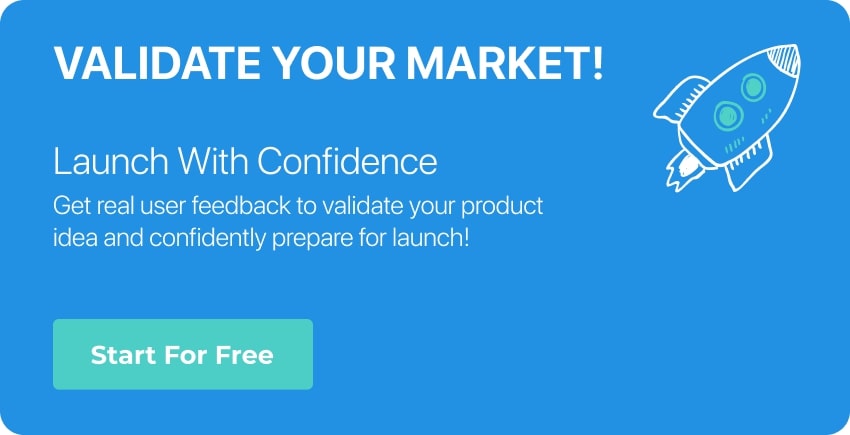
The Power of Prelaunch Market Validation: Outshining Traditional Market Research
Traditionally, research and market validation has been fairly straightforward given the options at hand – surveys, focus groups, user tests, etc.
But what differentiates an interested interviewee from someone who will actually make a purchase come launch day? Their commitment to the product. And since commitment can’t be measured through surveys and focus group work, a solution that is far more complex, relevant, and inclusive has to be at play.
Thankfully, that’s where Prelaunch.com as a platform steps in. And in this section we’ll discuss step by step why traditional methods are no longer enough for the modern-day creator and how Prelaunch.com can replace them, making market validation, concept validation and product-market fit testing easier than ever.
And finally, just because it’s crucial to back everything up with real-life examples, we’ll dive into a market validation case study done with Prelaunch so you can better understand how everything works.
The Limitations of Traditional Market Research: Why Focus Groups and Surveys Aren’t Enough
Traditions are good. But innovations are better. Methods like focus groups and surveys have been widely used across all industries for market research and validation. The primary purpose was, of course, to obtain customer insights and understand people’s needs and preferences.
However, not only do these methods come with limitations, but they also don’t actually provide product creators with 100% accurate data simply because of their nature. Asking someone if they’d be willing to buy your product is extremely different from them showing their financial commitment to the product.
This brings us to the next point, someone who’s merely interested is going to give you a different type of feedback than someone who commits to buying. So the motive matters here.
These aspects of old market validation methods can hinder success for lots of entrepreneurs, especially first-time creators since they don’t already have an existing audience that is at least partially loyal to the brand.
That being said, let’s break down why exactly focus groups and surveys are no longer enough to conduct proper market validation:
- Limited sample size
Focus groups and surveys usually have a limited number of participants, which might not represent all of your target market. While market validation doesn’t include questioning every single one of your huge or niche target audience, it’s still considerably less reliable than what you could get with wider access using Prelaunch, for example.
- Geographic and creative limitations
If your product has global goals, you won’t be able to reach enough people from enough locations and backgrounds to provide you with reliable information by using traditional market validation methods. Your best chance of ensuring you get the diverse insights you need is through a more streamlined and managed process that has a wider reach, like Prelaunch.com’s advertising and dozens of tracked data points.
- Response bias
Respondents may provide answers they believe are socially acceptable or what they think you want to hear. This results in inaccurate insights and won’t be of much value to you. Response bias is also one of the reasons you can’t simply create and launch a product based only on the praise and encouragement of your friends and family.
- Incomplete insights
Focus groups and surveys may not provide a complete picture of a customer’s actual behavior, attitude and preferences. Right off the bat, respondents may not be able to fully grasp the product (which is another issue you, as the product creator, should address), express their feelings or understand their own motives while being surveyed or in a focus group.
- Limited context
Focus groups and surveys are usually done in isolated environments that might not reflect real-life use cases and circumstances. Not having the relevant context at the time of asking them your questions can result in less helpful feedback and insights.
- Time-consuming nature
Typically, organizing and conducting mass surveys and focus group work can be time-consuming and costly. Small businesses especially will struggle with this, resulting in smaller sample sizes, and thus defeating the whole purpose of the market validation process.
Market Validation with Prelaunch.com: The Key to Launching Successful Products
According to numerous sources and stats, while it’s difficult to establish the precise number, the percentage of failed products a year is a staggering 75%. To Prelaunch.com (and pretty much everyone else), it’s a huge gamble. So instead of launching without validating your concept, market demand, pricing, and other metrics, Prelaunch gives you the opportunity to significantly decrease your failure potential with an easy test.
But don’t get us wrong, while Prelaunch validation is easy to perform for the product creator, in the background it’s extremely advanced and multi-layer.
Let me explain.
Prelaunch.com is a product-market fit validation platform that allows you, the business owner, to test every single metric and aspect of your product and its target market to determine whether or not you’re ready to launch, if what you’re offering is needed in the market, whether or not you’ve determined the right pricing strategy, and if your product lacks any feature you overlooked.
But how does Prelaunch accomplish all of this and how reliable is the data you gather?
The problem
With the traditional research methods we’ve covered, you are only able to get a glimpse at initial market interest. You have no actual way of knowing if a user’s intent stretches beyond that interest – meaning that you can’t realistically know if they will give you their money in return for your product or service based only on survey responses.
This is a huge problem because it means surveys and focus groups don’t give you feedback as a highly-committed lead. They only give you information coming from a place of mere curiosity.
The solution
Prelaunch.com, unlike surveys and focus groups, solves this problem with a unique system – we call it the reservation model. Here’s how it works:
- You create a highly-converting product page with enough information about the product and visuals (it’s easy because AI does the work for you)
- You then drive traffic to your landing page (again, the Prelaunch team does this for you by running targeted ads on your page)
- You place your product on the Prelaunch marketplace for additional traffic from the platform’s community of early adopters
- Visitors are asked to leave their email addresses if they want the product
- This is where it gets interesting, now they are asked to place a small deposit to secure a discount for the product when it launches. It dramatically increases the purchase intent with financial commitment and ensures that the feedback you receive is actionable and highly reliable.
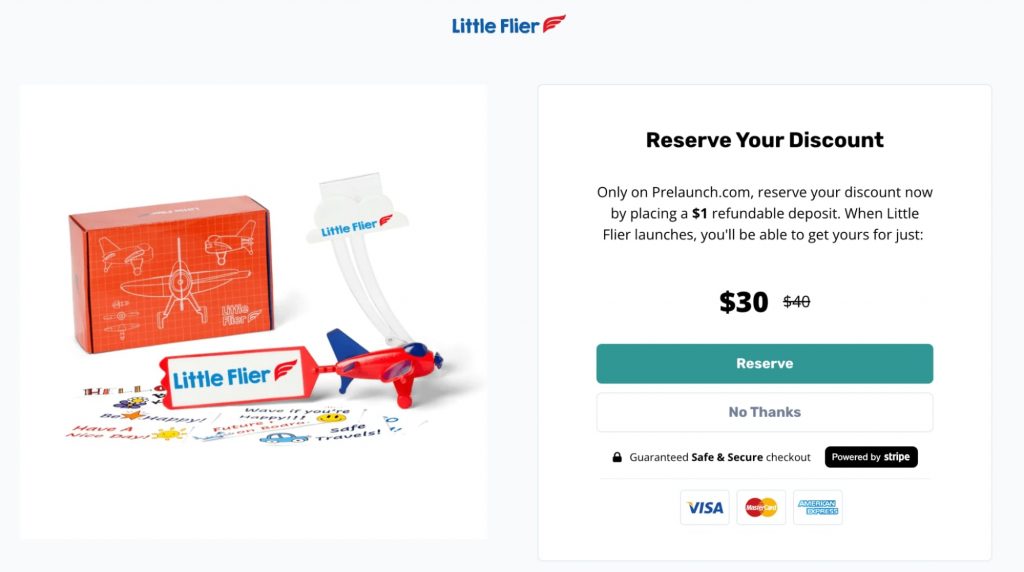
- And lastly, people with the highest purchase intent get your very specific survey about the product – giving you a goldmine of data from people who intend to buy the product and have demonstrated their commitment.
- Subscribers who opted out of making a reservation get a different survey that aims to determine what exactly held them back from committing to the product financially, helping you better understand both your “interested” and “committed” visitors.
What are the benefits of using Prelaunch.com?
Now you know that you obtain information from people most likely to buy your product. But what else ensures your success and how is this data analyzed and tracked?
Prelaunch allows you to validate your products using an iterative approach – this means that everything about your product – from content to visuals, pricing and positioning is subject to change. And you’ll be able to monitor how a single deliverable, such as a $5 difference in the price, affects visitors.
All this information is gathered in your dashboard where you can see the performance of each iteration and track and compare metrics like:
- Concept validation
- Price validation
- Subscription rate
- Reservation rate
- Subscription to reservation ration
- Prelaunch score (a unique metric calculated by Prelaunch based on 30+ data points to determine if your product is ready for launch or not)
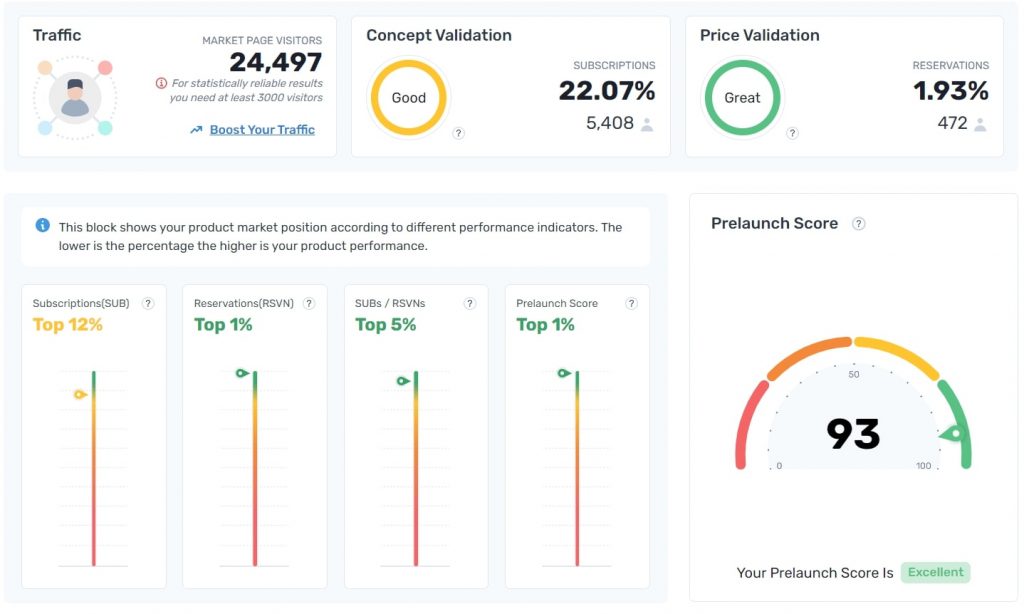
See the full dashboard
The results
To sum up, with Prelaunch.com you can understand if your product is a good fit for the market, whether or not people are ready to pay the price you’re asking from them, what the strengths and weaknesses of your proposition are and how you can improve it. It’s a cycle of trying and testing until you reach a version of your product that works well enough to launch with confidence.
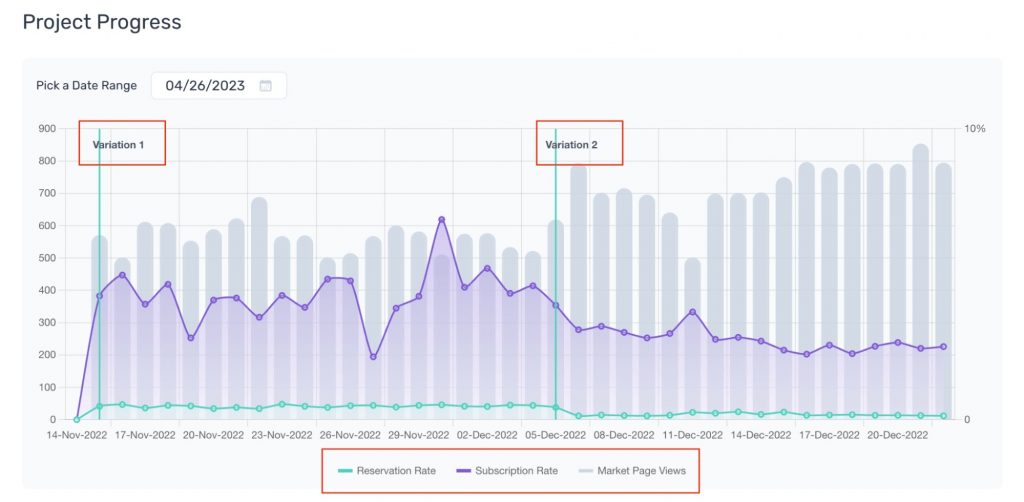
To provide you with empirical data on how market validation looks like when done with Prelaunch.com, we’ll discuss a recent example for a dog training and relaxation device, MyFelo . The product testing was done to validate the product before launching a crowdfunding campaign for it.

The Prelaunch test was conducted to test the following:
- Market interest
- Pricing strategy
- Purchase readiness
- Best target audience for advertising
- Best geographic locations for the product
- Feedback and customer insights on the product
There were 3 price points the Prelaunch team tested to determine which one works best for MyFelo (a price point the product creator aimed at, and 2 variations that were slightly higher and lower). After weeks of testing, the finding was that the lowest tested price point got the most amount of traction from visitors. A testament to this was the number of people who made reservations immediately so they could get the product as soon as it launched.
Prelaunch.com measures the purchase readiness of the visitors with the product’s current benefits and pricing and is calculated by dividing the cost per reservation by the product price. All these metrics help determine whether visitors are interested in MyFelo and if the marketing efforts will see a positive ROI when the product launches.
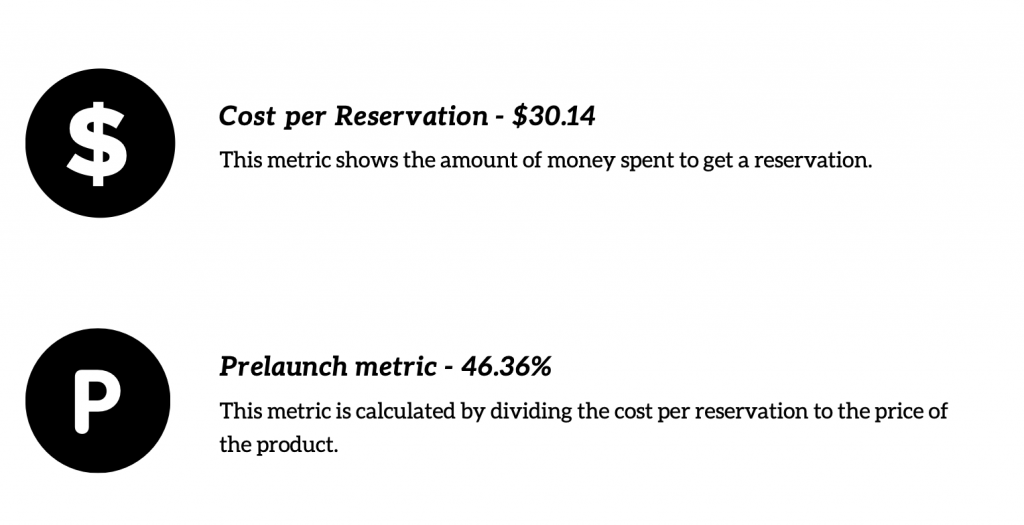
Throughout the testing, Prelaunch.com gathers and analyzes the results of each tested variation and provides a comprehensive report so the product creator can see exactly what worked, what didn’t, and what needs to be changed for a stronger value proposition.
The target market is presented with 2 different surveys at different stages of their interaction with the product. First, they are asked about the issues they found with the product after they subscribe to be notified of the launch. This helps determine what stopped them from committing to it right away, but since they showed interest, it means this data comes from warm leads and is highly reliable.
Next, once they place a small deposit to secure their discount, they are asked specific questions about their interest in the product and how to improve it. For MyFelo, it offered enormous insights as to what needed more attention going forward regarding the features, messaging, and pitfalls to avoid.
This is where customers can express their needs more elaborately, ranging from the release date, use cases of the product, modes of operation, and battery to the technology and science behind MyFelo.
MyFelo struggled to understand which usage purpose would be most appealing to consumers – dog training mode or relaxation mode . Based on the numerous survey results provided by the users most excited about the product, the training mode was what people were most interested in. So the positioning of the product, along with the main USP became the training mode, and relaxation mode was just an added benefit.
This type of data helps creators see what the visitors need and currently lack in the product. It also guides the product team in the right direction for future product versions, expansion areas, and so on.
And last but not least, this information helps both the creator and the Prelaunch team tailor the advertising and other promotional strategies to suit the audience’s preferences and “speak their language” better.
At the end of the Prelaunch testing, MyFelo has gathered a community of people who have shown much interest and care in the product. And any product that has a strong community, has a stronger chance at success.
Market validation is an imperative step for any entrepreneur who wants to launch a successful, profitable product or service. The cornerstone of a successful product is testing and gathering feedback from potential customers to understand whether there is a demand for what you’re offering.
With traditional research methods like surveys and focus groups, market validation will take more time and resources and provide insufficient data. But with a more comprehensive platform like Prelaunch.com, this process is more streamlined and backed by data from users that are committing to be your customer as soon as you launch, and therefore, is more reliable.
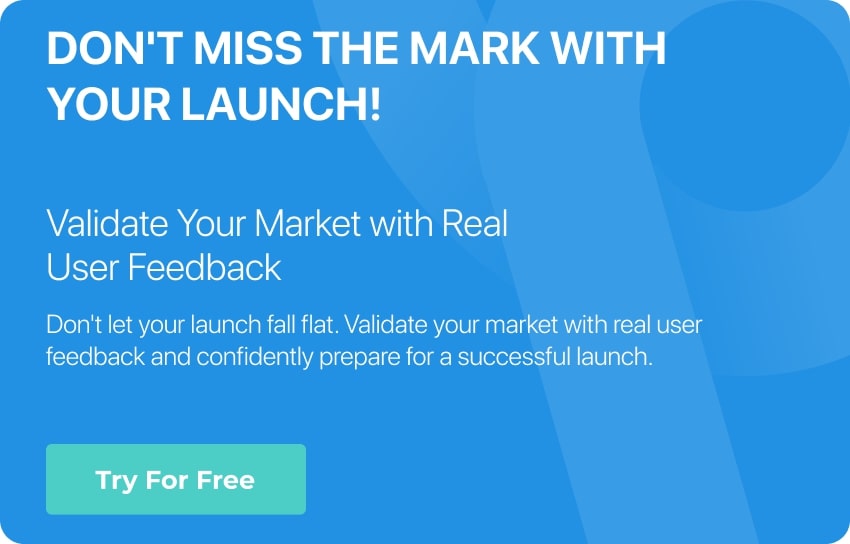
Lili Avetyan
Lili is an experienced marketing professional skilled in content marketing, messaging, product launch, email marketing, crowdfunding, and strategic partnerships.
Related Articles

Product Validation Process: Why Is It So Important?
- by Angel Poghosyan
- October 12, 2023

User-Centric Mastery of Product Design
- December 19, 2023
Market Validation: All You Need to Know to Validate Your Target Market and Launch with Confidence
Not sure if there's a demand for your product in the market? Learn how to validate your target market and launch with confidence in our in-depth guide. We'll take you through the entire process and provide you with expert tips and tools to succeed.
Table of contents

Taking that step to launch your new venture is exciting, but it can also be nerve-wrecking. After all, you want to make sure you have considered every possible factor and bulletproofed your strategy from unforeseen circumstances.
For that, it’s important to validate the market before you launch your product. But how do you do that?
In this article, we’ll cover:
- What Is Market Validation
- Important Things To Keep Ready Before Validating The Market
- What Happens When You Skip Market Validation And Attempt To Launch Your Product
- How To Conduct Market Validation Exercise For Your Product
Message Testing Methods
- Best Tools And Resources for Market Validation

A Quick Guide For Designing Your Market Validation Surveys
So, stick to the end and be assured of your product’s demand before investing a lot of your resources.
What is Market Validation?
Market validation is the process of determining whether there’s a demand for a product or service in your target market. It involves getting feedback from your potential customers. By validating a business idea in your early entrepreneurial stage, you can learn more about how your product meets or fails to meet the needs of your target market. This helps ensure you don’t waste your resources creating a product that doesn’t fit your intended market.
Market validation comes between ideation and development and is a crucial stage in the creation of new products.
Why Is Market Validation Important?
Market validation helps anticipate the demand for your product in the market, enabling you to understand whether your business will be profitable.
Below are the reasons why market validation is important:
1. Avoiding big product failures
It takes a lot of effort and resources to develop products. If those products are developed and launched – but do not succeed in drawing customers from the market, the sunk cost can be substantial.
Market validation helps you avoid these undesirable situations by ensuring you understand your customers and that you are not developing a product that doesn’t have a demand in the market. Similarly, product validation helps evaluate whether or not a product addresses the needs and pain points of its current and potential customers.
2. Creating a better product
Market validation gives you the ability to assess whether there are any flaws in your product. These insights will help you build a product that brings the best value to the users or addresses their pain points.
3. Minimizing costs
Validating your business idea cannot ensure your startup's success. However, during the validation process, you can evaluate whether your product will be a success by spending minimum costs. And if you predict less demand for it, you can avoid wasting your resources. By using a landing page for idea validation , you can evaluate if you should move forward with the idea.
4. Checking if the demand for the product is real
Conducting market research can help forecast whether there is demand for your product in the market. This will enable you to develop products that your potential customers actually want, by providing you ideas for new features or suggestions based on the pricing, packaging, etc. Customer validation helps you avoid building products that no one wants.
5. Securing funding
Market validation is performed to accurately determine the possibility of the success of your product. The process makes it easier to justify the development in the eyes of the stakeholders and potential investors.
Why Should You (Always) Validate The Market Before Even Starting To Build Your Product?
Validating the market can be hugely beneficial for an entrepreneur. Below are the reasons why you should do it before building a product.
- Market validation helps you understand your market better. For example, Spotify analyzed how Asia’s market is different from the rest of the world and figured out that serving India was like serving 28 different countries because of differences in cultures and languages.
- You can avoid huge failures by not building products nobody wants.
- It helps you understand what and how your potential customers react to your product and enable you to serve better. For example, eDreams got to learn that their customers did not find “flexible ticket cancellation” as an important feature initially because they did not understand the concept. So it was unlikely going to be successful – the way they planned it.
- It allows you to determine your business model by learning more about your potential customers’ willingness to pay.
- You can justify and secure product funding because a well-researched market is always attractive to stakeholders.
Market Validation Prerequisites: A Few Very Important Things to Keep Ready Before Validating the Market
Before you perform market validation, there are some things you must keep in your mind to ensure its effectiveness. So, here are a few of them:
1. Define your target customer segments
Organizing your target audience into groups based on various categories like demographics and psychographics is an important step. It entails dividing your target audience into different segments based on some common traits like age, income, hobbies, and location, etc., to understand their specific requirements & serve them better.
While doing it, it is important to keep the following in mind:
- Don’t go too narrow: Obviously, you want to have a distinct and clear idea of the audience you're speaking to. But be careful not to take it too far and make a segment with just one or two people. Consider removing a few of the filters if you notice that some of your segments are capturing no one or very few people.
- Set goals and measure your success: Audience segmentation only works if you know what you're utilizing it for. Set your exact goal & periodically evaluate your progress.
Market segmentation is important for the following reasons:
- Market segmentation allows you to understand your customers on a deeper level. You can use this information to tailor your content to every segment’s unique challenges and requirements. With that, you can also create ad campaigns and convert more customers.
- It also helps you improve your customer service efforts.
- Market segmentation allows you to prepare for different challenges that are likely to occur.
- Dividing the market also helps find new opportunities to build and serve products, services and support efficiently.
- Communicating with different segments through their preferred channels or platforms also becomes easier. This also makes them feel more personal and included, thereby building long-term relationships.
It is similar to creating buyer personas or semi-fictional representations of your ideal customers based on market research and a few practical assumptions.
It helps you understand and relate to the target audience for your products and services.
Here are a few buyer persona canvas templates that you can edit & use directly for your market segmentation.
2. Ensure your market is big enough to achieve your sales and profitability goals
While validating the market, an important factor that you need to consider is the size of the market. Accessing the potential market size helps estimate your sales and profitability goals. Moreover, it is also important to calculate the Total Available Market (TAM), Serviceable Available Market (SAM), and Serviceable Obtainable Market (SOM) to help investors get an idea of the potential returns.
Here’s what these terms mean:
The whole market demand for a good or service is referred to as the total available market. E.g., The worldwide market for milk. However, it is not feasible for any company to capture the entire global milk demand due to its limitations and competition.
The portion of the TAM that your products and services are targeting that is geographically accessible is known as the Serviceable Available Market. E.g., milk market in your city.
The segment of the Serviceable Obtainable Market that you can capture is called SAM. E.g., 20-30% of SAM or those residing locally and a small percentage of people from nearby localities. This is the most practical and important consideration for investors.
3. Make sure your TAM isn’t shrinking
Even though your current, most important consideration should be SOM, ideally, you would need to ensure your TAM is huge and isn’t shrinking. This is because the investor can begin considering how you can extend and enhance the company's penetration inside the TAM once you have shown your ability to enter a local market and de-risk the investment.
Below are some resources to guesstimate your TAM:
- Google Trends
- Local data websites like Eurostat
What Happens When You Skip Market Validation And Attempt To Launch Your Product?
When businesses fail to validate their markets, they risk wasting resources on products that may not be well received by the public or provide a return on investment
Skipping such an important step might be tempting because of deadlines or pressure from the boss, but often leads to dissatisfied customers and loss of profits. Without proper validation of the market, companies tend to enter a competitive environment without enough information and knowledge about how their product fits into it.
Below are some of the startups that have failed because they missed market validation and the valuable lessons we can learn from them.
- Juicero : This company was founded in 2013 with the goal of revolutionizing the way people make juice at home. The product was an expensive, Wi-Fi-connected machine that would press pre-packaged bags of fruits and vegetables into juice. Unfortunately for Juicero, their product failed to take off due to its high price tag and the fact that customers could easily squeeze the bags themselves. Had they conducted price testing , the scenario could have been different.
- Fab.com : This company was founded in 2011 with the goal of becoming an online marketplace for designer goods. Despite having a large user base, Fab.com failed to take off due to its inability to differentiate itself from other e-commerce sites such as Amazon and eBay.
- Color : This company was founded in 2011 with the goal of creating a social network based on photos. Despite having a large user base, Color failed to take off due to its inability to differentiate itself from other photo-sharing sites such as Instagram and Snapchat.
How To Conduct Market Validation Exercise For Your Product?
Learning how competitive the market is, who your competitors are, which features customers want in your product, and more is important to carry out your product in the market and ensure its success. So, here’s how you can conduct the market validation exercise for your product.
1. Identify Your Target Audience
The first step in conducting a market validation exercise is to identify your target audience. This involves researching the demographics, interests, and needs of potential customers who would be interested in your product or service. You can use surveys, focus groups, interviews, and other methods to gain insights into the needs of your target audience.
2. Analyze Your Competitors
Once you have identified your target audience, the next step is to analyze your competitors. This involves researching their products, pricing, marketing strategies, customer service, and other aspects of their business. You can also use tools such as Google Trends to compare the popularity of different products in the market.
3. Conduct Market Research
After analyzing your competitors, it's time to conduct market research. This involves gathering data on the size of the market, customer preferences, and other factors that can affect your product's success. You can use surveys, interviews, focus groups, and other methods to gain insights into the market.
4. Test Your Product
Once you have gathered enough data from your market research, it's time to test your product. This involves creating prototypes or MVPs ( minimum viable products) and testing them with potential customers. This will help you identify any issues with your product and make necessary changes before launching it in the market.
5. Analyze the Results
After testing your product, it's time to analyze the results. This involves looking at customer feedback, sales figures, and other data points to determine whether or not your product is ready for launch. If the results are positive, then you can move forward with launching your product.
6. Adjust Your Strategy
Finally, you should adjust your strategy based on the results of your market validation exercise. This involves making changes to your product or service, pricing, marketing strategies, and other aspects of your business in order to ensure its success. You can also use this data to make improvements and ensure that your product remains competitive in the market.
Conducting a market validation exercise for your product is essential to ensure its success. By following the steps outlined above, you can efficiently conduct a market validation exercise and make sure that your product is ready for launch.
It is also important to find out how the product's target market is responding to its marketing messages. For that, message testing is an important step.
Message Testing For An Effective Messaging Strategy
Many businesses rely on guesswork when determining whether their message is hitting the mark or not, which can often lead to inaccurate results. Thankfully, there are several reliable techniques that can help marketers test their messaging and get accurate feedback.
Here we'll explore some of the various message testing methods available and how they can help you craft a more effective messaging strategy.
1. A/B Testing

A/B testing is one of the most popular message testing methods. It involves creating two versions of a message and then sending them out to different groups of people. The results are then compared to determine which version was more successful.
Surveys are another great way to test messaging. They allow marketers to get direct feedback from customers, which can be invaluable in crafting an effective message. Surveys can also provide insight into customer preferences and help marketers tailor their messages accordingly.
3. Focus Groups
Focus groups are a great way to get feedback on messaging from a larger group of people. This method allows marketers to get a better understanding of how their message is being received by their target audience.
Minimum Viable Product (MVP) is the most basic version of your intended product that still provides value to the user. Watch the following video to learn how can you validate with an MVP:
MVPs are frequently used for market validation to gauge user interest in the product and how they interact with it. Additionally, it enables you to gather feedback from your intended market and spot any significant problems with their usage.
Whether to create an MVP or not often depends on what it takes to create one. If it is going to take a year or so to develop an MVP version, it might be better to test the interest of the users through other ways first. Similarly, if developing the final product won’t take a lot of your time & resources, it’s better to skip this step and directly move towards the development of the end product.
If you want to develop your MVP quickly & within the budget, this guide on minimum viable product examples is a must-read.
But, how to put these methods into practice? Below are some of the best tools for message testing that will assist you in judging the performance of your message copy:
- Wynter: This popular user testing software called Wynter targets copywriting and messaging in particular. With Wynter, you can design efficient message-testing queries. The panelists will then just need to browse the website, respond to these queries, and provide feedback on various elements of the marketing message.
- FiveSecondTest: FiveSecondTest , as is clear from the name, gathers a group of testers and gives them five seconds to browse the website. Although it does a similar job to Wynter, its findings are less specific and more generic. They are then required to explain what they believe the website is about.
- Google Analytics 4: GA4 can be used to measure the success of messaging campaigns. By tracking metrics such as open rates, click-through rates, and conversion rates, marketers can get a better understanding of how their messages are performing and make adjustments accordingly.
- Adobe Target: Adobe Target , an enterprise-level solution called offers A/B testing services. It can be easily integrated with Analytics to generate reports for user experience testing, shifting market offerings, etc... You may quickly develop different website versions with Adobe Target and target audience segments based on the outcome.
- HotJar: HotJar helps create heatmaps, session recordings, and surveys for your website. It reveals how users move across your page, where they scroll, and where they spend the most time.
Even though it might not demonstrate how effective your copy is, it does make uninteresting copy more obvious. If your sales copy is lengthy, you can tell when the readership dwindles and they stop reading. You can revise portions with noticeable drop-offs.
Overall, message testing is an essential part of any successful marketing strategy. By using one or more of these methods and tools, marketers can ensure that their messages are hitting the mark and reaching the right people.
Best Tools and Resources for Market Validation
To make your market validation process easier, you can use some digital tools. Below are a few of them.
1. Google Trends
Google Trends is free-to-use and excellent for identifying and evaluating market trends. Google Trends carefully examines the search terms that people enter into the search engine. You can assess company ideas based on the popularity of products and search terms. This will enable you to determine whether a certain product is being purchased.
Quora is an ideal social network for information sharing. You can freely enquire about a subject connected to your business concept and promptly get responses. Each month, 300 million people use Quora.
3. MindMeister
MindMeister is used to develop ideas, create mind maps, and communicate them to other users. Additionally, MindMeister enables you to organize projects and take notes. The tool itself has a very user-friendly UI.
Brand24 is a robust and all-inclusive internet monitoring tool. Users are looking for and asking for product reviews online. This suggests major issues that people are facing at a point in time. With the help of this tool, you can track mentions of a certain product. It is also possible to determine how frequently a topic is discussed or an issue appears. Additionally, Brand24 makes it simple to spy on rivals' activity.
5. Typeform
Using surveys and forms is a very efficient approach to testing a startup idea. And, to make their preparation less arduous and time-consuming, it’s worth giving Typeform a try! You may quickly personalize any survey with Typeform's tools. Numerous Fortune 500 firms, like Apple, Uber, and Nike, employ this software.
Using these tools can expedite the business idea validation process. However, you might also need a few resources for making this process easier and more effective. So, here are a few of them:
- How To Select A Test To Get Market Validation For A Business Idea : For a list of tests to choose from for your market validation exercise.
- Validate Your Product: 19 Market Testing And Market Validation Tactics (Plus 7 Tools For Validation) : To learn about different validation techniques in detail.
- 6 Market Validation Methods In Australia : To understand the six market validation methods commonly used in Australia: customer interviews, wireframes, and prototypes, concierge service, halving the market, minimum viable product, and test marketing, in detail.
- Product-Market Validation: A Step-by-Step Guide : To learn how to use Facebook advertising to determine who is most likely to purchase your product and to demonstrate the popularity of your offering.
- Practical Guide on Validating Idea In 2 Days : To learn how voXup’s +PeterLewis tapped into the offline forum his app was trying to address - community residents - and simulated flows for his app’s most common use case.
Designing market validation surveys is an important step in understanding the potential success of a new product or service. A well-designed survey can provide valuable insights into customer needs and preferences, as well as identify potential challenges and opportunities.
Best Practices
- Define the goals of the survey and the specific information you are looking to gather. This will help to ensure that the questions you ask are relevant and aligned with your overall research objectives.
- Consider the target audience for the survey and tailor the survey to their specific needs. Who will be taking the survey and what information do they have that is relevant to your research?
- Use clear and concise language that is easy for respondents to understand, and avoid using jargon or technical terms that may be unfamiliar to your target audience.
- Keep the survey as short as possible to increase the likelihood of response.
- Consider the method of survey administration and choose the method that best fits your research objectives and target audience. Surveys can be conducted online, by phone, or in person. Each method has its own advantages and disadvantages.
- Test the survey with a small group before launching it to a larger audience to identify any issues or problems. This will help to identify any issues or problems with the survey, such as confusing questions or unclear instructions.
- Encourage honest feedback and make sure that survey takers know how their answers will be used.
Sample Market Validation Survey Questions
Below are some of the questions you can include in your market validation survey. You can tweak these based on your requirements.
- How familiar are you with our company/brand?
- On a scale of 1-10, how likely are you to purchase our product/use our service?
- What do you like most about our product/service?
- What do you dislike most about our product/service?
- Where would you expect to find this product?
- How does our product/service compare to similar products/services you have used in the past?
- What features would you like to see added/removed to our product/service?
- How much are you willing to pay for our product/service?
- How often do you currently use products/services like ours?
- Are there any specific issues or pain points our product/service could help solve for you?
- Would you recommend our product/service to a friend or colleague?
- Would you be interested in subscribing to our service?
- Are there any other comments or feedback you would like to provide about our product/service?
In summary, designing market validation surveys involves setting clear research objectives, identifying the target audience, creating questions that are easy to understand, considering the survey method, and testing the survey before launch. This will help to ensure that the survey provides valuable insights and is well-received by the target audience.
In Conclusion
Many businesses are so excited to launch their ground-breaking product idea that, in their haste to do so before a rival company does, they skip the market validation stage and go straight to product development.
Your company shouldn't invest a lot of time or money in creating a product that will fail. Conducting market validation research early on in the concept validation stage of any new product will help to prevent this from happening. Find any issues before they cause expensive development errors!
We hope this article turned out to be THE ULTIMATE GUIDE on market validation for you. However, if you still need more resources, these may be helpful:
- Failed but Validated? The Effect of Market Validation on Persistence and Performance after a Crowdfunding Failure
- 42 Failed Startups with No Market Need
- Market Validation In The Context Of New High-Tech Ventures
- The Definitive Guide To Message Testing
- How to Select a Test To Get Market Validation For a Business Idea
In order to raise funds from investors, you need to present a pitch deck to them that includes a brief but informative overview of your business.
Here are a few guides and templates that will help you nail your pitch deck.
- Tell A Compelling Story
- 11 Slides to Include In Your Pitch Deck
- 12 Must-Have Slides to Win Investors
Sample slides/Templates:
- PowerPoint Market Validation Templates
- 30+ Pitch Deck Examples, Templates & Tips
- 35+ Successful Pitch Deck Examples
Now, time to answer some of your most common questions on market validation:
When should market validation be done?
Market validation is often done early in the product development process before any large investments have been made.
What are the differences between market validation, proof of concept, and product-market fit?
Market validation is a method of confirming that your idea is a solution to a real-world problem. It is usually done after problem validation. Proof of concept is used to demonstrate that your concept is operationally viable. It is not visible to potential customers as in the case of proof of concept. Product-market fit refers to how well a brand's product can meet the needs of the existing market through its product.
What is the best way to get market validation for a new product?
Identify a market, write your assumptions, hypothesis, and more about it, test your product with real customers, get their feedback by conducting surveys and interviews, do more field research, re-iterate your product, and make it more suitable.
What is the best way to perform a market validation survey?
Understand who your target audience is, make a solid strategy to get in touch with them, and take actionable data by asking open-ended questions about their current solution, its problems, and expectations.
What are the best books for market validation?
Below are the top 5 books for market validation:
- The Four Steps to the Epiphany by Steve Blank
- The Lean Startup by Eric Ries
- The Lean Product Playbook: How to Innovate with Minimum Viable Products and Rapid Customer Feedback by Dan Olsen
- The Entrepreneur's Guide to Customer Development: A cheat sheet to The Four Steps to the Epiphany by Brant Cooper & Patrick Vlaskovits
- Crossing the Chasm: Marketing and Selling Technology Projects to Mainstream Customers by Geoffrey A. Moore
Written by Aastha Kochar , a freelance writer at Shnoco .
You may also like

Leveraging No-Code Tools for Impactful Nonprofit Fundraising

Revolutionizing Your Online Venture: The No-Code Way to Success

How to Create an E-commerce App without Coding
A free course to
Master the No-Code Fundamentals in Just 7 Days

Subscribe to our newsletter
Occasionally, we send you a really good curation of profitable niche ideas, marketing advice, no-code, growth tactics, strategy tear-dows & some of the most interesting internet-hustle stories.
Stop the War. Support Ukraine. Make a donation to United24 program. Support Ukraine
- Pitch Deck Consulting Services
- Business Plan
- Investment Teaser & One pager
- Startup Financial Model
- Investor Targeting and Outreach
- Due Diligence Consulting
- Post-Investment Reporting and Communication
- Pre-seed funding services
- Seed funding for startups
- Series A funding advisory
- Industry Analysis Services
- Executive Summary Consulting
- Company Overview
- Financial Performance Analysis
- Growth Opportunities and Projections
- Management and Organizational Structure
- Business Valuation Services
- Market Research Services
- Market Entry Strategy Analysis
- Pitch Deck Design Services
- Product Demo Presentation
- Event Deck Design Services
- Digital Health
- Pharmaceuticals
- Cannabis Wellness
- Cannabis Biotech
- Cannabis Products
- Psychedelics
- Social Commerce
- Mobile Commerce
- E-commerce Marketplaces
- P2P Marketplaces
- Smart Watches
- Digital Banking
- Financial Exchanges
- Personal Finance
- Flexible Workspace
- Green Building
- Clean Energy
- Solar Energy
- Wind Energy
- Animal Health
- Vertical Farming
- Mobility Tech
- Travel and Tourism
- Renewable Energy Tech
- Energy Efficiency Tech
- ClimateTech
- Car Sharing
- Ride Sharing
- Gig Economy
- P2P Finance
- Smart Government & GovTech
- Smart Building
- Smart Mobility
- Edutainment
- Video Games
- Console Games
- Online Gaming
- Mobile Gaming
- Fantasy Sports
- Online Gambling
- Event Management
- Creator Economy
- Meeting Software
- Social Networks
- Business Intelligence
- Machine Learning
- Predictive Analytics
- Generative AI
- Nanotechnology
- 3D Printing
- Augmented Reality
- Virtual Reality
- Internet of Things
- Cybersecurity
- Remote Work
- Digital Marketing
- Sales Automation
- Crypto Exchange
- Crypto Wallets
- Metaverse Economy
- Success stories
5-minute test to check your chances of raising funding in 2024
Home / Blog / Top-11 market validation methods, mistakes & slide examples
Top-11 market validation methods, mistakes & slide examples
- Core knowledge
Want to learn more?
More growth and fundraising hacks at your fingertips
Thank you, your sign-up request was successful!
If you’ve brushed off market validation as a minor step, it’s time for a reality check.
Market validation isn’t rocket science, but it’s far from a walk in the park, either. It’s a blend of meticulous analysis, creative strategies, and iterative actions designed to turn raw data into actionable market insights. Every detail counts when convincing investors that a market is ready and willing to spend on your innovation.
We’ve witnessed too many founders stutter at the pivotal moment when investors ask, “What’s the traction from your market validation?” and jeopardize their fundraiser.
Having helped hundreds of startups with market intelligence , growth hacking , and fundraising , we’ll walk you through the key validation methods, uncover common pitfalls many founders trip over, and show slide examples to help you prove your market to investors.
But first, a quick 101.
What is market validation?

Market validation, which also goes under terms like customer validation or demand validation , is a process of indicating the demand your product or service generates among your potential customers and scouting for ideas to adjust and refine the offering to enhance this demand.
Simply put, validating the market allows you to understand whether a market is interested in your offering and whether (and how) you need to change it to increase this demand or broaden the appeal.
Market validation helps you answer the following questions:
- Do people need my product?
- Is there enough real and sustainable demand for my product?
- How large is the market?
- Who is my ideal customer persona?
- How much are people willing to pay for my product?
- Are there ways to improve the product to deliver more value?
Raise money with the free pitch deck template from Waveup

Why startups love our template:
- Investor-proof narrative & design
- Best practices from $3B+ raised
- Powerpoint + Keynote
Success. We just sent the Pitch Deck Template from Waveup to your inbox.
What does market validation help you achieve?
- Reduced the risk of a product flop. The better job you do at validating market demand for your offering, the lower your chances of wasting money and time on building a ship that’s going to sink.
- Shortened time-to-value. In the process of validating your market, you gain an intimate understanding of your potential customers’ needs and expectations. This helps deliver products they feel value from right away.
- Faster arrive at product-market fit . The better you validate the market, the faster you can spot and address the mismatch between the users and the offering early on, thereby increasing customer retention and achieving product-market fit.
- Enhanced business model and pricing strategy . Preliminary testing of various pricing strategies and revenue models with your potential customers is a part of market validation. This, in turn, helps align them with market expectations and maximize profitability.
- Increased investor engagement and chance to secure money . To generate any semblance of investor interest, you must present ironclad evidence that the market needs your product, is willing to pay for it, and has substantial growth potential.
Here’s an illustration of how vital market validation can be for your fundraising outcome.
WAVEUP STORY:
We worked with a startup that crafted a solution for building contractors and was in the middle of pitching it to investors. One VC, after listening to the pitch, decided to take it a step forward and validate the concept in real time. He reached out to four or five building contractors he knew and relayed the startup’s idea, asking if it were something they would use. The response was “Absolutely.”
This positive feedback became a pivotal factor in the VC’s decision to invest. But this success wasn’t just luck. The startup had previously invested a considerable amount of time working directly with contractors. They meticulously refined their product, iterating its features and pricing, and identifying core use cases to ensure it met the specific needs of their target audience. This groundwork ensured that when the opportunity arose, the product would resonate strongly with its intended users, paving the way for investment.
Top-11 market validation methods + instructions for them
There is no cookie-cutter approach to how to do market validation; each case calls for a tailored approach consisting of a combination of quantitative and qualitative validation methods that complement each other.
Here are the different types of validation to choose from
Google trends and keyword research
Analyzing Google trends and a search volume for keywords related to your products is the first stage of market validation. It helps you identify the level of public interest in your niche or offering and how it has changed over time, find geographic areas of high demand, and more.
Method :
1. Identify popular keywords/queries related to your product or service using SEO tools like Ahrefs , Semrush , or any free keyword tool.
2. Enter these keywords in Google Trends .
3. Analyze how these queries perform in different geographies and over different periods or seasons.
Pros:
- Broad-strokes insights
Landing page tests
Publishing a landing page with your offering before it’s been materialized is a super popular litmus test for market demand. Both giants like Google or Hubspot and early founders we worked with use it as a go-to strategy to see how much traffic and clicks the idea will generate before committing to it. You can also use this method to test potential features or collect feedback.
- Define the goal of the campaign: gauging interest, testing potential features, gathering feedback, etc.
- Identify and segment your target audience.
- Create a landing page with a clear value proposition using landing page software or an agency.
- Integrate data collection tools like embed forms, Google Analytics, heatmaps, etc.
- Use PPC and social media to quickly drive traffic to the page.
- Analyze the user’s feedback and reaction.
- Evaluate the results.
- Relatively cost-effective
- Quick feedback
- Potential for lead generation
- Customizable for different audiences
- A/B testing
- Limited depth of information
- The need to drive traffic to the page
- Result’s dependency on the quality of the traffic
Online surveys and questionnaires
Well-constructed surveys and questionnaires can provide a deep insight into your customers’ preferences, challenges, and opinions about the problem you’re solving and the way you’re solving it.
- Create a list of questions about the importance of the problem you’re trying to solve, the ways people are solving it now, hypothetical product features, benefits, and pricing.
- Identify and segment the target audience to ensure the survey reaches potential customers representative of the market.
- Distribute the survey/questionnaire via email, social media, website, or specialized survey platforms like SurveyMonkey and the like.
- Analyze the responses to identify patterns, trends, and insights about the market and customer preferences.
- Excellent source of quantitative data
- Cost-efficient
- Quick results
- Customizable
- Subject to response bias
Crowdfunding campaigns
Launching a crowdfunding campaign is a perfect way to test market interest in your offering and its willingness to pay for it while having an opportunity to raise early funding for the development.
- Research the market and the problem you’re solving.
- Develop a prototype or a detailed concept of your offering.
- Create compelling crowdfunding and marketing campaigns.
- Launch the campaigns and monitor their performance.
- Proof of concept
- Access to market insights
- Feedback from potential customers
- Heavy upfront investment in the prototype and the campaign
- Platform fees
- The outcome depends on the quality of your campaign and messaging
Competitor analysis
Examining your competitors can provide insights into the market’s response to similar products or services. It helps you identify gaps, potential opportunities, and user expectations in the existing market landscape.
- Identify the primary competitors in your niche.
- Analyze their offerings, pricing, marketing strategies, and customer reviews.
- Examine their strengths, weaknesses, opportunities, and threats (SWOT).
- Identify gaps or unmet needs in the market.
- Evaluate how your offering could fill those gaps or improve upon existing solutions.
- Cost-effective
- Quick insights
- Helps identify industry benchmarks and standards
- Offers an understanding of market trends and customer preferences
- Data can be outdated or not specific to your exact business idea
- Limited to existing solutions; might not uncover novel opportunities
- Doesn’t provide direct feedback from your potential customers
Focus groups
Gathering a diverse group of potential customers to discuss and provide feedback on your idea offers direct insights into the market’s perception and expectations.
- Define the objectives of the focus group, like exploring reactions to a concept or assessing specific features.
- Recruit participants representing your target audience.
- Prepare discussion guides and topics to ensure productive sessions.
- Conduct the sessions, ensuring open and honest feedback.
- Analyze the discussions to gather insights and feedback.
- Direct feedback
- In-depth exploration of customer perceptions and expectations
- Can uncover nuanced insights and reactions
- Resource-intensive
- Risk of getting biased responses
- Risk to interpret the data subjectively
Usability testing
Testing the user experience and functionality of your product with real users to gather direct feedback on its usability and areas for improvement.
- Develop a prototype or beta version of your product.
- Recruit participants who represent your target users.
- Define specific tasks for users to perform during the test.
- Observe and record their interactions and feedback.
- Analyze the results to identify usability issues and areas for improvement.
- Direct feedback on product usability
- Identifies user experience issues early
- Can be conducted remotely or in person
- Can be time-consuming
- Requires a functional prototype or beta product
- May require skilled interpretation
Minimum viable product (MVP)
Launching a simplified version of your product to the market will help you probe interest, collect user data, and iterate based on real feedback. This is a form of methodology validation.
- Identify core features that represent your product’s value proposition.
- Develop a functional MVP with those core features.
- Launch the MVP to a segment of the target market.
- Collect data and feedback on usage, preferences, and issues.
- Iterate and improve based on the collected insights.
- Real-world data on market response
- Opportunity for early revenue
- Allows for iterative development based on feedback
- Requires investment in development
- Risk of negative reception if not well-executed
- May need to manage user expectations
User interviews
Conducting one-on-one interviews with potential users is one of the effective validation techniques to dig deeper and unearth insights into their needs, preferences, and feedback on your offering.
- Identify and recruit potential users representing various segments.
- Prepare open-ended questions to explore user perspectives on specific issues.
- Conduct interviews, focusing on listening and probing for deeper insights.
- Analyze the collected data to identify patterns, insights, and feedback.
- Use the insights to refine your offering and strategy.
- More nuanced insights
- Targeted exploration of specific issues or topics
- Customization for each participant or group
- Time-consuming
- Requires skills in conducting and analyzing interviews
- May not be statistically representative
Pre-sales and pre-orders
Offering your product for sale before it’s fully developed helps validate market interest, create a pipeline of potential customers, and generate early revenue. This is especially important in market validation for startups.
- Create a compelling offer and description of your upcoming product.
- Set up an online store or platform to accept pre-orders.
- Promote the pre-sale to your target audience.
- Analyze the volume and pattern of pre-orders to gauge market interest.
- Use the insights to inform production and launch strategies.
- Generates early revenue
- Directly tests market willingness to pay
- Validates market demand with minimal risk
- Requires a clear and compelling offer
- Needs a plan for fulfilling the orders
- Can impact reputation if not well-managed
Beta testing
Releasing a near-final product to a select group of users for feedback and final adjustments.
- Develop a beta version of your product with core features.
- Recruit beta testers from your target market.
- Release the beta version and collect feedback on usage, bugs, and features.
- Analyze the feedback and make necessary adjustments.
- Use the insights for final refinements before the full launch.
- Real-world testing environment
- Direct feedback
3 biggest market validation mistakes
#1 asking the wrong people.
Don’t start validating your market before you thoroughly understand who your market is, aka devise your ICP.
An ICP is an ultra-targeted market segment that needs your product in its current form, will draw the most value from it, and is willing to pay for it.
For example, asking your uncle Joe or coworker Suzie about their preferences with, say, online education platforms is useless unless they are avid users.
One founder we worked with came to us believing he had validated his idea after receiving positive feedback from ex-coworkers and acquaintances. However, our market validation research showed the opposite – the market was overcrowded to the point where the idea wasn’t viable. Diving deeper into his ICP showed that he didn’t really have it, and his “market validation” was based on asking his ex-coworkers, who were just being polite.
This lack of targeted market segmentation led to the unfortunate demise of his idea since his actual ICP didn’t need it.
#2 Asking the wrong questions
Many early founders ask questions that seem reasonable on paper but cannot elicit a helpful or unbiased response. Questions that are poorly phrased, hypothetical, leading, or too broad / too specific will bury any chance of getting any valuable data out of your users.
Consider a tech startup asking its users, “Would you want to use this product?” This is a hypothetical question, the answer to which doesn’t tell you much.
Instead, ask them what problems they’re facing, how they’re solving them, what features they wish they had that their current solution doesn’t deliver, and if they would be willing to pay for this.
We once worked with a guy who developed an AI prospecting tool and was on a mission to raise $4 million. The slide that tipped the scales for him was the one that presented the feedback from 100 customers, with 90% of them loving the idea and over 50% expressing willingness to pay for this solution more than for their current CRM.
This piece of data wasn’t just an expression of interest saying, “Yeah, we would use that”; it was ironclad proof of the users’ willingness to part with their money. Such research and the feedback it elicited are worth a lot in the VC world—especially in SaaS— ultimately securing the round for our client.
#3 Asking too early or too late
Timing is one of the keys to a resultative market validation. Start too late, and you risk blowing away time and money on planning and developing a solution no one needs or needs with significant alterations.
Start too early (or ask questions that fit for later development stages), and you’ll drown in a sea of contradictory information that will overwhelm you and cloud your thinking.
Move iteratively, step-by-step, asking questions that reflect your stage and pace.
Killer market validation slide examples to win investors over
If you’re preparing for a fundraiser, there are many ways to demonstrate that you’ve done your homework and validated the market interest in your offering in your pitch deck.
Here are our two favorites.
Example #1. Market validation slide for a prospecting automation platform
This market validation slide example is from a pitch deck we created for our client that raised $4M in a Seed round . Here, we used data we obtained during user interviews and research to demonstrate demand validation.

Why it works:
- Positive customer quotes accompanied by real photos and occupations skyrocket the impact and persuasiveness of the words
- Using statistics reinforces and substantiates the demand
- Clean design that highlights the important bits without overwhelming investors
Example #2. Airbnb market validation slide
The following market validation slide example is from an almost-legendary Airbnb pitch deck that raised $ 600,000k during its angel round in 2008.

- Uses data about competition to demonstrate market volume
- The design is neat and simple, which strengthens the message
The problems:
- Lacks any traction, which might be unconvincing to VCs in 2023
Market validation is a stepping stone in your startup’s success
By now, you probably see that market validation isn’t an easy feat—at least if you plan to draw quality insights from it. Hopefully, we covered this topic thoroughly enough for you to understand where to start and how to roll.

Need a deeper dive into topics like pitch deck tips , financial modeling , or growth hacking for startups? Follow those links to get to the hub pages.
What is the difference between market validation and market research?
Market research is like the groundwork. It’s where you dive into understanding your potential customers, the market size, trends, and the competition to orient in the landscape you’re stepping into. On the flip side, market validation is more like a reality check where you put your business idea or product into the wild to see if there’s a real demand for what you’re offering and if customers are willing to open their wallets for it.
How important is market validation for fundraising?
A market validation slide is as important as a market size, competition, or team slide. Investors need proof that your idea or product has value for potential customers and that this value is enough to make investors rich.
How do you make a market validation slide?
There are many ways to create a compelling market validation slide. Here is what you can put there: 1. Include the most exciting quotes from your first users. 2. Show a pipeline of leads, pre-orders, or pre-sales. 3. Use numbers from your competitors to prove a voluminous market. 4. Show traction, e.g., traffic.
Do you help with market validation?
Yes, we do. It comes as a part of our market intelligence services .
Want to explore more posts on the topics of startup growth, fundraising, and financial modeling? Check out Waveup’s blog to get lost in some crème de la crème content.
Content Writer
Hi there! I’m Anya, a Content Writer at Waveup. I’ve been working with startups in various industries for over 4 years, soaking up the knowledge and learning from their business strategies. Now, I collaborate with the best minds here at Waveup to pick up their expertise and share it with the readers.
Related Posts
- Fundraising
Startup funding stages guide: From pre-seed to IPO [2024]
- Financial model
6 pro tips for building superior startup KPI dashboard
How to value your startup: pre-seed to series a guidebook, how to calculate the cost of revenue: startup cheat-sheet, how to prove to investors you have product-market fit, a complete rundown of pitch deck mistakes and how to avoid them, startup operating expenses: what should they include, startup math: the key performance indicators you need to track, what is safe note [2024 guide], top 9 venture capital firms investing in healthcare, top 15 venture capital firms in miami.
Leave your information below and one of our experts will be in touch to schedule a call.
We use cookies from third party services to offer you a better experience. Read about how we use cookies and how to control them by clicking "Privacy Preferences".
Privacy Preference Center
Consent management.
- Cookie Settings
When you visit any website, it may store or retrieve information through your browser, usually in the form of cookies. Since we respect your right to privacy, you can choose not to permit data collection from certain types of services. However, not allowing these services may impact your experience.
Advertising
- Product development Get a product-market fit
- Custom software development Deliver a fully-featured application
- Software re-engineering & support Improve your product performance
- IT consulting Become a digital enterprise
- Team augmentation Scale your team when needed
- SaaS development
- Web development
- Mobile app development
- UI/UX design
- Test automation
- All industries
- HR & Recruitment
- Mobile apps
- Web applications
- Guides on shaping great products
- Software development best practices
- How technology is changing business
- Building high-performance teams
Market validation or how to validate the project idea before going ‘All in’
Most business ideas sound good and look fresh in our heads, while a good many of them die after falling into customer hands. Since entering the market with a new product is almost walking the edge, market validation under real-life conditions is crucial before launching.
Although risk has become a synonym to entrepreneurship, accepting the risk to spend time, money and energy creating a product that people don’t need is a path to failure.
In this article, we will overview the best practices for validating business ideas without spending a fortune and as a result, building a better solution.
Let’s quickly sort out what validation actually is and why you should not ignore it.
Market validation: an approach that makes sense
The reality is that the success of each business idea depends on the value provided to stakeholders. This value relies upon market validation (customer interest) and growth opportunities (business interest). In fact, if the product fails on the market, nobody, including customers, founders, co-founders or investors, benefit from the gamble.
instead of investing in development right from the first day, hoping it will pay its way thereafter, start with validating the solution viability.
Market validation is testing your idea within real market conditions before releasing the product or service.
What differentiates the idea validation process from market research is this:
Validation is aimed to provide you with first, paying customers, and lay the foundation for potential growth.
A result of successful idea testing may be a number of pre-orders or subscribers ready to pay for the upcoming minimum viable product (MVP).
Let’s take an example.
Dropbox had more than 75 thousand subscribers for their beta version before product launch by means of an explanatory video.
So, the main reasons why you should not underestimate the business validation phase are:
- Going beyond a guess. Assumptions may turn out to be wrong. Idea validation allows checking the essential hypotheses and assumptions ASAP.
- Getting in touch with end users. Keep in mind that the users are the nerve center of your business. Reach out to them and they’ll tell you what they actually need and whether they are ready to pay for your solution.
- Improving your idea. When you validate business ideas and gather customer feedback, you are able to pivot and polish up your business strategy before investing resources.
Now, it’s time when the question “ how to test a business idea ” may appear in your mind.
Read on to decide which validation approach is best for your particular case.
Magic of Wizard of Oz Testing
This market validation approach simulates the behavior of a new product, service or device.
It gives the customer an impression of using a fully-functional application when it’s still under development and most of the operations are done manually.
Wizard of Oz testing allows companies to find out how customers interact with a product or service which doesn’t exist yet.
The brilliant example of a Wizard of Oz is Zappos .
Nick Swinmurn created an online shop proposing a variety of shoes. In reality, he had no warehouse and no shoes. He took pictures of shoes at nearby stores and posted them on the Internet. When a customer made an order, Nick bought them from a local shoe shop and sent them himself.
All this was aimed to understand whether customers were ready to buy shoes without trying them on.
Groupon , by the way, initially used a WordPress blog and Excel spreadsheet to list down the companies who were interested in selling coupons and then manually matched them with buyers.
All this worked without any application and no advanced technology whatsoever.
And this is what the magic of Wizard of OZ testing all about 😉
The advantages of Wizard of Oz approach to market validation are:
- It is a cheap option to simulate a fully-functioning system. Especially useful if your business is young and lacks investment.
- It allows identification, to draw on tested customer journeys and get a clear vision of the way the future solution should behave.
- It enables receipt of real feedback from actual customers using your product or service as if it was finished.
The main disadvantage of this type of market validation is the need to have and organize a bunch of people behind the curtain to do all the routine tasks manually.
Value of Prototyping
A prototype is a so-called product simulation which is aimed to bring the customers through a set of main product features.
It may involve either numerous pen and paper mockups or a version allowing stakeholders to click through and comment on the UX. It is a great deal more straightforward to attract an audience by presenting something people can see or even interact with.
Here is an example of the prototype created by MindK for Juvo , a mobile app for safe communications in local groups:

The launched Juvo application looks like the following:
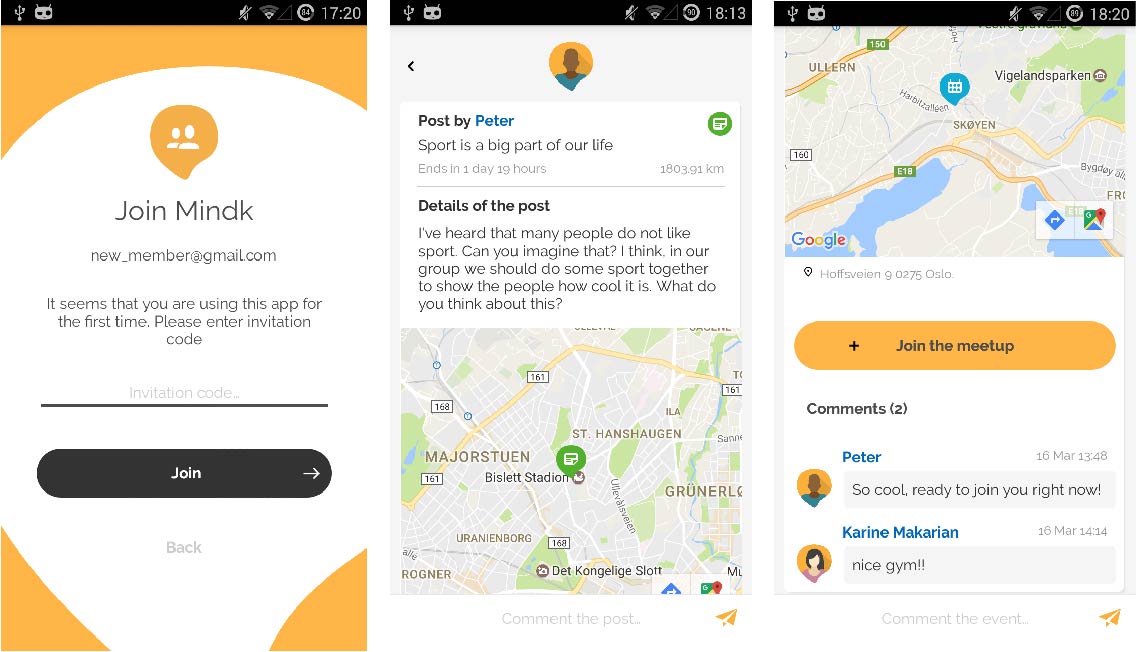
As you can see, a prototype has no need to look drop-dead gorgeous, as it is intended to validate whether the solution provides a clear user journey in an attractive manner.
It does not represent a functional app and does not work with real data.
A prototype has nothing to do with an MVP, as MVP needs to be both minimal and viable, when a prototype only requires to be minimal.
The most significant benefit of the prototype relates to risk reduction. You can make quick decisions by means of customer-centered lesson learned.
The sooner you “fail” the faster you learn, the higher the chance for success.

Source: Steveforbes.com.au
While the Wizard of OZ and landing page approaches focus on market validation, creating a prototype is a more complex approach.
A quality prototype can kill three(!) birds with one stone:
- Validation of market need: by asking 5-10 people to be test subjects and give you feedback about the prototype. Ideally, look for the people from your target audience – they should have a problem your product solves (or need a service it provides).
- Validation of a business need or visualizing the concept to build stakeholder approval and engagement. Instead of thousand words, prototype would be a great tool to show investors and stakeholders how your product will actually work and how its core features will solve user problems. It will help all decision makers to be on the same page.
- Helping the product development team . Dammed up inside developers, designer and product owners’ heads are creative waterfalls of ideas, technologies and animations. Prototypes take team communication to the next level, by ‘showing’ instead of ‘telling’.
Effect of explanatory video
Another method of market validation is an explanatory video. To test whether your idea is valuable to your target audience, information about what your solution does and how it works to solve problems should be explained in a crystal-clear way.
Sometimes it is impossible to demonstrate the working solution in the form of a prototype or ‘Wizard of Oz’.
This was precisely what happened with Dropbox .
Drew Houston, the founder of Dropbox, created a three-minute video explaining the main idea of the product that did not yet exist and showed how it was supposed to work.
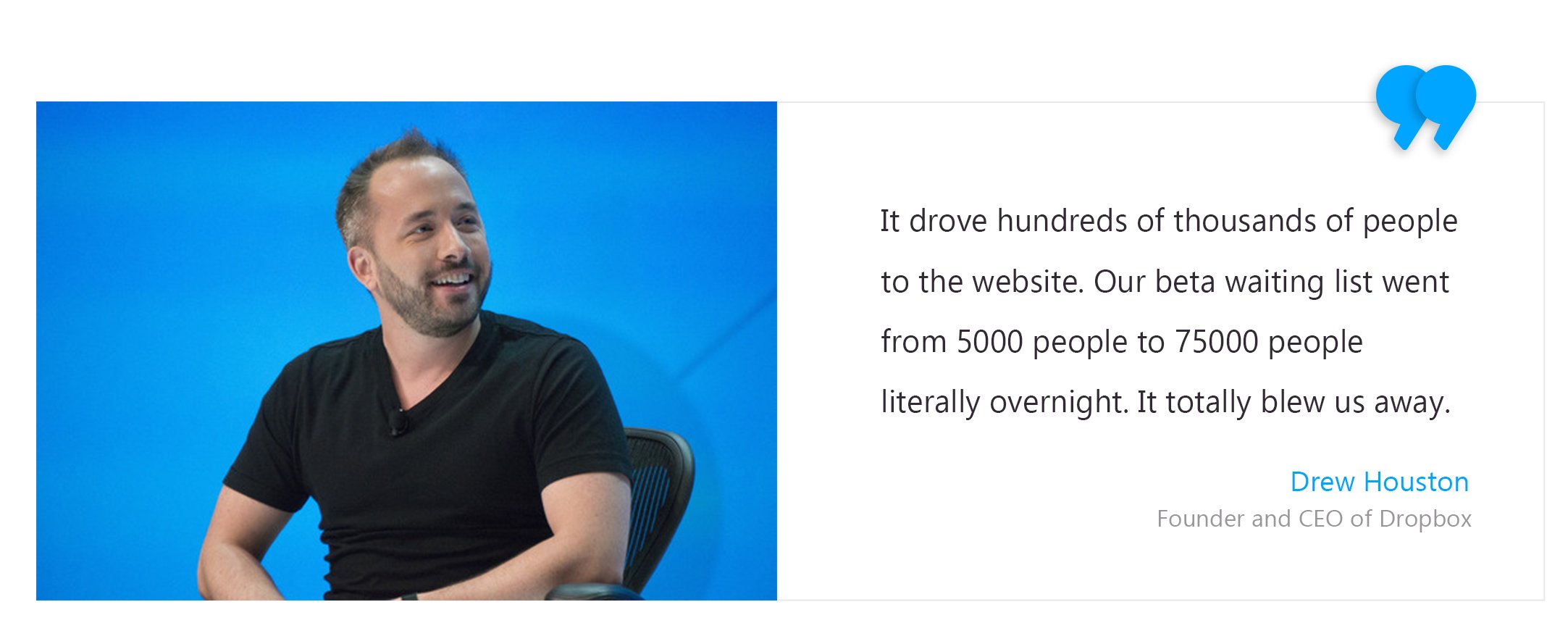
The core advantage is the ability to demonstrate all the capabilities of a product clearly in just a few minutes, which is MUCH cheaper than starting the development process.
All these examples demonstrate that before turning your product idea to life you should test out your market and ensure they need and like the product you’re about to bring.
Wrapping Up
When you come up with an inspiring business idea, do not ignore the market validation phase. In the case that customers are ready to pay for your solution, you can consider your idea valid.
Keep in mind that idea validation should not turn into procrastination. It helps you understand the market better and study up on overcoming challenges, avoid costly mistakes and save your time and money.
So choose the method that suits your business best, get priceless insights about your clients and be ready to build a successful MVP first and an award-winning product at long last.
MindK has already helped a number of businesses to validate their ideas in the market and build them into demanded products. Contact us and we will be happy to help with validating concept at an early stage and analyze possible risks before you spend months building the wrong product.
Have you used another method for market validation that worked well for you? Share it in the comments!

Subscribe to MindK Blog

How to save 75% on Bug Fixing and Other Benefits of Automation Testing
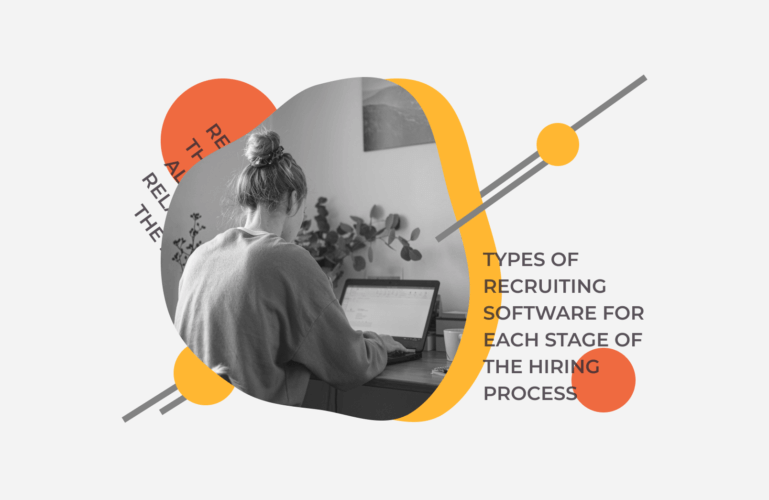
Types of Recruiting Software for Each Stage of the Hiring Process

What Is MVP? All You Need to Know About the Concept
This website uses cookies to improve your user experience. Check our privacy policy here .
- Business Essentials
- Leadership & Management
- Credential of Leadership, Impact, and Management in Business (CLIMB)
- Entrepreneurship & Innovation
- *New* Digital Transformation
- Finance & Accounting
- Business in Society
- For Organizations
- Support Portal
- Media Coverage
- Founding Donors
- Leadership Team

- Harvard Business School →
- HBS Online →
- Business Insights →
Business Insights
Harvard Business School Online's Business Insights Blog provides the career insights you need to achieve your goals and gain confidence in your business skills.
- Career Development
- Communication
- Decision-Making
- Earning Your MBA
- Negotiation
- News & Events
- Productivity
- Staff Spotlight
- Student Profiles
- Work-Life Balance
- Alternative Investments
- Business Analytics
- Business Strategy
- Business and Climate Change
- Design Thinking and Innovation
- Digital Marketing Strategy
- Disruptive Strategy
- Economics for Managers
- Entrepreneurship Essentials
- Financial Accounting
- Global Business
- Launching Tech Ventures
- Leadership Principles
- Leadership, Ethics, and Corporate Accountability
- Leading with Finance
- Management Essentials
- Negotiation Mastery
- Organizational Leadership
- Power and Influence for Positive Impact
- Strategy Execution
- Sustainable Business Strategy
- Sustainable Investing
- Winning with Digital Platforms
5 Steps to Validate Your Business Idea

- 18 Aug 2020
You’ve come up with an innovative business idea, raised initial funding , and believe you have what it takes to be an entrepreneur . What’s next?
It’s time to validate your offering’s market potential.
What Is Market Validation?
Market validation is the process of determining if there’s a need for your product in your target market. Validating your business idea can enable you to reasonably predict whether people will buy your product or service, and whether your business will be profitable.
It’s important to validate your idea early in the entrepreneurial process to ensure you don’t waste time and resources creating a product that isn’t a good fit. Securing market validation can also instill confidence among investors, crowdfunders, and banks that are considering funding your startup.
By going through the process of validating your business idea, you can gain a deeper understanding of how your product does or doesn’t meet your target customers’ pain points. The insights you gain can help you create an offering that not only addresses your market segment’s needs, but earns you your first paying customers.
Here are five steps to determine the market validity of your venture.
Access your free e-book today.
5 Steps to Determine Market Validation
1. write down goals, assumptions, and hypotheses.
Writing down the goals of your business is the first step in market validation. The process of articulating your vision can illuminate any assumptions you have and provide an end goal.
Ask yourself:
- What’s the value of my product ?
- Who’s the target audience, and what assumptions have I made about them?
- What differentiates my product from existing ones?
- What hypotheses do I have about my product, pricing, and business model?
Answering these questions can help you communicate the value and differentiating factors of your product, and illuminate assumptions and hypotheses you’ve made that are yet to be tested and verified.
Related: How to Come Up With an Innovative Business Idea
2. Assess Market Size and Share
Before moving forward with your venture, estimate the size of your target market and the share of it you could potentially capture. By doing so, you can gauge your business’s potential and justify its launch.
In the online course Entrepreneurship Essentials , Harvard Business School Professor William Sahlman uses mattress retailer Casper to illustrate this idea. In 2014, Casper’s founders assessed the market size for their product by comparing its differentiating factors against the larger market. For Casper, these differentiating factors included its online business model, 100-day return window, and the viscoelastic foam material used in its mattresses.
Based on statistics for the mattress market at the time—including units sold per year, the percentage of the market owned by foam mattresses, and the number of mattress retailers that were e-commerce brands—Casper’s founders narrowed down which segments they should target, and determined they could own a few percentage points of the total mattress market share.
Do this exercise for your target market. For products similar to yours, research sales data, the number and share of current manufacturers, and what percentage of the total market your segment holds. Determine where your product fits into the market and assess how much of it your business could own.
3. Research Search Volume of Related Terms
Another way to gauge the market validity of your business idea is to research the monthly search volume of terms related to your product or mission. When consumers need a product or service, they often use a search engine to see what the market has to offer.
You can use a host of resources to look up monthly search volumes, such as Moz . In the case of Casper, a related search term might be “foam mattress.” According to Moz, the term garners more than 11,500 monthly searches, indicating a demand for the product.
If there’s not a lot of search volume surrounding your product, use terms that express customer intent. For instance, if you design a mattress made from a new, extra supportive material, you could look up how many people search for “best mattress for lower back pain sufferers.” Moz data indicates that the query yields 240 monthly searches.
This type of search volume for a longer, specific query isn’t negligible. In fact, it can be used to bolster your hypothesis that there’s a need for your product.
4. Conduct Customer Validation Interviews
Conducting interviews with your target market segment can be an effective way to learn about your product’s potential. This initiative might include hiring a market research company to conduct focus groups, sending out an online survey, or simply requesting a conversation with someone.
Ask potential customers about their motivations, preferences, needs, and the products they currently use. Circle back to the list you created in the first step of the market validation process, and frame any assumptions or hypotheses you made as questions to your interviewees. Be open to the feedback you receive and record it for future use.
The feedback may reflect that your product doesn’t have strong market validity, in which case, you can use it to improve your offering and repeat the market validation process.
Related: 7 Questions to Ask for an Insightful User Interview
5. Test Your Product or Service
Once you’ve determined there’s space for your product in the market, ensure you’re putting the most useful, intuitive version of it into the world. You can achieve this through alpha and beta testing.
- Alpha testing is when internal employees test a product in a staged setting. The purpose of alpha testing is to eliminate any bugs, issues, or idiosyncrasies in the product before it’s available to outside users.
- Beta testing is when a product is tested by a limited group of real, external users who are specifically told to identify problems. In the case of a software or app, beta testing might be open to the public with a notice letting users know the version they’re testing is unfinished.
Testing your product with real users can prove invaluable when assessing market validity. If there’s a need in the market, but your product is faulty, complex, or difficult to use, customers may opt for a competitor’s offering. The feedback you get from beta testers can help you better leverage and meet customer needs .

Turning Feedback Into Action
In Entrepreneurship Essentials , entrepreneurship is described as a “process of discovery.” To determine whether your product is a market fit, you must seek feedback to validate the beliefs you hold about your product offering.
Entrepreneurship requires flexibility and hard work. If you put in the time to outline your goals and assumptions, assess the market, interview potential customers, and conduct tests, you can gather the information you need to build the best version of your product.
Are you looking to turn your idea into a viable venture? Explore our four-week online course Entrepreneurship Essentials and our other entrepreneurship and innovation courses to learn to speak the language of the startup world. If you aren't sure which course is the right fit, download our free course flowchart to determine which best aligns with your goals.

About the Author
- Construction
- E-commerce features
- Product Features
- Customer Segmentation
- Business Model
- Market Research
- Marketing Campaigns

- Market Validation
How to Do Market Validation: A Step-by-Step Guide

You’ve got a great idea for a new product line. You know exactly how to make it, and you have the team on standby. Sure, you’re a lot further forward than many businesses, but before you dive headfirst into product development, you need to validate your market.
You have to determine whether or not people will buy your product, at what price, and at what scale.
In this article, we’ll look at:
- How to define market validation
- Why do you need to do market validation
- A step-by-step process for market validation research
- Market validation methods
Table of Contents
What Is a Market Validation?
Market validation is essential. Once you’ve had the idea for the product, and before you launch it into the market, market validation is critical to determine if there is a demand for your product and whether it will be viable based on the demand, willingness to pay, and so on.
Market validation is the process of asking and testing the answers to the following questions:
- Is there a demand for your product?
- What price will your target audience pay?
- How much competition is there?
- What is your SAM segment size?
Market validation is important for startups to test their business ideas, but it’s also crucial for established businesses to validate new product lines or features before investing. When done correctly, it will save you time and money in the long run.
Benefits of Market Validation
The benefits of market validation are clear.
First, by determining whether there is a viable need for your product, you can reduce the risk of your product failing. By understanding your target market, the competition, and the price people are willing to pay for your product, you avoid creating a product that does not meet the needs of your customers.
Second, if you can prove that your product has demand and is profitable based on assumptions about the market size and the price that it will sell for, you can use this to secure funding for the product. It will also reassure you when investing heavily in the startup phase.
A Step-by-Step Process for Market Validation
Step one: validate demand.
First things first, you need to determine that there is demand for your product. You need to find out your total market potential and how much of that market you can capture.
You need to decide whether the market is large enough to do a viable business and if your product solves the problem well enough to take enough of the available market share.
To find out the demand for your product, you can use the following techniques:
- Competitive research: Are there other companies selling similar products? How many sales do they make, what’s their revenue, how much website traffic do they get? What is their sale price?
- Search volume: Use Google Keyword Planner, Ahref, or other keyword research tools to find out how many people search for your applicable keywords per month.
- Google Trends: Look at Google Trends to see if the demand is stable, increasing, or decreasing over time.

Step Two: Understand the Competitive Landscape
To validate your new product, it’s important to understand the competitive landscape. Your competitor’s data is a goldmine of information when it comes to validating your product.
Consider the following key metrics:
- Average Cost Per Click (CPC): Use a keyword research tool (like Ahrefs) to find out the average cost per click your competitors are paying for search terms related to your business. Expensive clicks mean there’s a lot of competition and that other businesses see the value in spending on those keywords.
- Keyword Difficulty (KD): Find out the keyword difficulty for search terms related to your business. How difficult is it to rank for high-intent terms? Are there any longer tail keywords that you can capitalize on?
- Estimated visits to your competitor’s website per month: How many people visit your competitor’s website per month? If they get 100,000 visitors, you can use that as a starting point for an assumption — 100,000 people are interested in similar products to yours.
Many tools can be used to find out these metrics. The best tool is the one that matches your budget and is intuitive to use. Here are some ideas to help you get started:
- Google Search Console
- SERPChecker
Step Three: Validate the Market Size
We’ve covered TAM, SAM, and SOM in detail here. We won’t cover old ground again. That said, when you validate your product, take time to estimate your market size and, more specifically, your SAM.
To calculate your SAM (serviceable addressable market), first, estimate the total number of potential customers that would be a good fit for your product. Next, multiply that number by the average annual income from each of these customers.
The key metrics you need to know are:
- The number of customers in your segment (consumers or companies)
- The products sales revenue that is similar to our product (annually)
By calculating the SAM, you can determine whether or not the available market is big enough to make your new product viable and profitable.
Market Validation Methods
Let’s take a look at some popular methods to validate your market:
Interviews and Surveys
Interviews and surveys are a common method to run market validation. You can gain a ton of qualitative data from asking existing and prospective customers for their opinions on your offering.
Keyword Research
As we’ve mentioned above, there are lots of tools that enable you to understand the demand for a product or service like yours. You can find out the search volume, ranking difficulty, and the cost of paying for clicks on specific search terms.
Cold Emails and Calling
Use cold emails and cold calling to contact people that have been identified as your potential customers. You can ask them feedback on your products, ask them for how much they would be willing to pay and ask them if your solution is the best available answer to their pain.
Fake Adverts
One of the best ways to get information about the demand for your product is to set up a fake advert and website. It’s a little time-consuming, but the value of getting real-world data as to people’s purchasing behavior is hugely valuable. It may just save you a ton of wasted time and money downstream.
Conduct Your Test and Analyze the Results
You may not be happy with the results of your validation experiment. You could discover that your assumptions about your product and its target market were wrong. Perhaps there’s little to no interest out there. Maybe you need to refine your concept to align more closely with buyer needs.
It’s a learning process, so don’t see a disappointing outcome as a failure. You even may spot opportunities to create different products that solve a problem you were unaware of or realize your heart wasn’t in the original concept after all.
In any case, get back to the drawing board and try new ideas.
How to Do Your Experiment with EpiProdux
EpiProdux makes market validation experiments quicker and simpler than ever. Here’s how to get started:
- Click on a Product in Your Portfolio

- Click on the Add icon on the upper right.

- Click on one of the listed Markets.

- Click along to section 3: Validation.

Now that you’re in the market validation section:
- Click the Start An Experiment button
- Select Demand, Competition, Market Size SAM, or Blank
- Fill in each section: Title, Type of Experiment, Metric, Result, and Conclusion
Your metrics may include Competitor Price, Average Monthly Keyword Search Volume, or anything else that helps you determine the product’s value.
Once you perform your market validation experiment, you’ll be able to understand whether significant demand for your product exists, the amount of revenue you can expect to achieve, and more. This will help you decide whether to build the product or try another.
Conclusion
Conducting market validation helps you create relevant products that resolve one or more pain points, satisfy users, and generate ROI. Follow the above steps to build an effective plan and collect the right insights to make intelligent decisions.
EpiProdux simplifies and streamlines all aspects of market research, including market validation. Try it today !
LEAVE A REPLY Cancel reply
Save my name, email, and website in this browser for the next time I comment.
Get our product management articles in your inbox, one click away
You have successfully subscribed to the newsletter
There was an error while trying to send your request. Please try again.

- Agile & Development
- Prioritization
- Product Management
- Product Marketing & Growth
- Product Metrics
- Product Strategy
Home » What Is Market Validation & How To Do It?
What Is Market Validation & How To Do It?
May 26, 2022 max 8min read.

This article covers:
What Is Market Validation?
What is the importance of market validation, what is your market validation plan, what are the market validation methods, how to do market validation, what are the examples of market validation, market validation definition : .
Market validation refers to the process of studying potential customers of a new product or feature to evaluate whether the product is viable in the target market.
Hundreds of start-up ideas see their birth and death in the same year. While there are many reasons some products fail, the most prominent one is the lack of market validation.
Market validation is the process of validating your product or service by your target audience before putting it on the market.
By conducting market validation , you can better understand if there is a place for your idea or if you need to alter it.
Let’s understand what market validation is and how you can do it.
Market validation is, at its core, the process of determining whether the market has room for your idea before investing money and time into it.
Market validation entails researching potential users of a new product to determine whether the product or business idea is viable in the target market .
Between ideation and development, market validation is a critical step in the product development process.
With market validation, you aim to learn two things-
- Does your target market like your product?
- Is your target market willing to buy or pay for your product?
Businesses run market validations for new or existing products.
Product teams , R&D teams, and marketing teams are usually involved in market validation. With market validation, you can test and validate products, services, and initial rough start-up ideas .
Validation is the process of getting feedback from potential customers to determine if there is a demand for your product or service. Without market validation, you’re just guessing whether people will actually pay for what you’re selling.
Companies that take market validation seriously also have a competitive advantage .
Market validation is essential because it helps you to-
- Understand your market better.
- Avoid huge failures.
- Determine your business model .
- Secure and justify product funding,
Understand Your Market Better
When you conduct market validation research, you may not get a clear yes or no for your product. However, you may get to know your customers better in the process.
Developing customer empathy in the pre-development stage itself is crucial. It helps provide value through your product.
You may learn the size of your potential market and the reception your idea is getting. Moreover, you can also understand what your product is missing with user research methods .
Carrying out market validation and connecting the dots early can help your product idea in the long run.
Avoid Huge Failure
Product development takes a lot of time and money. As a result, the sunk cost can be high if you develop and launch those products but fail to attract market users.
Market validation can help you avoid these problems by ensuring that you understand your users and aren’t creating a product that no one wants or needs.
Market validation is the difference between failed start-ups and ground-breaking start-ups.
Determine Your Business Model
When you do market validation, you get insights about your target market. But you will learn about more than just your customer .
Market validation provides insights into business decisions through user feedback .
For example, suppose your test audience likes your product idea but is hesitant to buy it. Perhaps they are willing to buy your product after a free trial.
This suggests that a freemium model might be suitable for your product initially.
Secure and Justify Product Funding
You’re going to need funding for any product to begin development. And investors like to put their money where it grows.
A well-researched and tested product-market fit is always attractive to stakeholders .
So, conducting market validation and gauging the reception of your product along with its predicted success will help you pitch better .
Look around. There’s tons of competition . Having an ‘idea’ is not enough. It has to be viable.
Most groups understand the importance and need for market validation. However, not everyone has a solid market validation plan.
You can not just dive into the process and wing it. It has to be fool-proof. So, what’s your market validation plan?
Here are some things you should consider while designing your market validation plan:
- Do you have a target audience yet, or do you have to find one?
- Which team will handle market validation for you? (Tip- Cross-functional teams work best.)
- At which stage of development are you going to conduct market validation?
- What market validation methods are you going to use?
- What is your desired result?
- What metrics would indicate the viability of your product or service?
- How will you proceed with development?
You can chalk out your market validation plan once you know more about the methods.
Here are some of the most common market validation methods you can use-
- Search Engine Research.
- Interviews and Surveys.
- Minimum Viable Product (MVP) .
- Prototype Test.
Search Engine Research
Initial quick market validation is right at your fingertips. You may conduct a simple Google search about your idea and see if people are talking about it.
You may search for your market size as well. Perhaps you may learn more about the problem you are trying to solve.
For example, if you want to build a mobile feature for blind people, you can check the search volume of that keyword on sites like Semrush .
Interviews and Surveys
Interviews and surveys are the most effective and popular methods of market validation tests. This allows for more qualitative data at hand.
These market validation research methods are incredibly adaptable, allowing you to learn about your customers from various perspectives.
A survey or questionnaire provides you with many responses. In contrast, interviews allow you to delve deeper into people’s feedback and uncover their real issues.
Minimum Viable Product
A minimum viable product (MVP) is the simplest version of your intended product that is capable of providing value to customers.
Market validation tests frequently use MVPs to gauge the users’ interest level and how they may interact with the product itself.
If users continue to use the MVP, it justifies investing in developing a full-fledged version of the product. It also enables you to obtain feedback from your target audience and identify any significant issues with their usage.
Prototype Test
Having test users interact with a prototype version of your product can reveal more information about what works and what doesn’t.
It implies that people don’t have to imagine an idea or product anymore. They get to use the product for real and relate to it outside of the test.
Do we have two versions of the same idea? Let’s test them both.
A/B testing is one of the most popular market validation methods. It is a popularly used product management tool for prioritization and user research .
With A/B testing, you put out both versions of your idea to your users and gauge which gets better reception.
For example, suppose you get more subscribers through the freemium model than the pay-per-use model. You can use this to develop your product marketing strategy .
Market validation is a step-by-step process. We recommend you don’t wing it.
Irrespective of your industry or product, a market validation plan has the following basic steps-
Build Your Hypothesis
You can only begin the market validation process with a goal and a hypothesis. After all, this process aims to validate market viability assumptions with actual customers.
Some examples of critical assumptions are-
- “This product has market demand.”
- “The product will solve the needs of its users.”
- “Our pricing strategy is appropriate for our target market.”
With that, you can then create your test.
Design Your Test
Here’s where you design the primary test itself. You will have to pick one or more of the market validation methods covered earlier.
You should ensure to ask the right questions. Use the SMART goal-setting technique for your test.
It’s best to conduct a dry-run and reiterate your test before exposing it to your representative sample.
Fetch Research Participants
Recruiting research participants is an essential aspect of any type of study.
First and foremost, these participants must represent the user persona for your product.
Secondly, be prepared to offer incentives or other compensation for the effort involved.
Thirdly, diversify your recruitment efforts. You can also use your social circle, the social media network, professional network, university students, and online portals.
Run and Review the Test
Now, you can conduct your test. The results may not always be favorable. But you must assess them from every pre-defined criteria and make your product decision .
Being incorrect does not imply failure. Product teams should never assume they know exactly what users require.
Always listen to the customer while maintaining a humble mindset and assuming you never know the answer.
And that should set you up for success!
Here’s a simple example of market validation-
You’re a travel agency named TravelCo.
Consider running ads for your new product. You’re not sure if a particular product feature is viable. You want to know if providing a free cancellation option on bookings will help gain and retain customers.
Now, your first step would be to build your hypothesis. Say, “Free cancellations result in higher customer conversion rates .”
Next, you design two ads to run. One that mentions free cancellation and another that doesn’t.
Try this on a specific target audience network.
You can use Google and Facebook analytics to see which ad had a greater click-through rate . This will help you decide on adding the new feature.
More Like This
- What is Product-Market Fit?
- What Is Market Positioning? Definition and Examples
- What is an A/B Test? Advantages, relevance, and FAQs.
- What is an acceptance test?
Some great tools for quick market validation are Google Suite, Unbounce, FiveSecondTest, Zintro, and AskYourTargetMarket for various functions of market validation.
Ideally, customers should market validate your product before you begin developing it. Whether you want to validate it at the ideation, MVP, or prototyping stage depends on your product vision and goals .
Crafting great product requires great tools. Try Chisel today, it's free forever.

Cracking the Code: The Power of Market Research and Validation for SaaS Companies
May 24, 2023

In the competitive world of Software-as-a-Service (SaaS) companies, success hinges on understanding the market and validating product ideas. Market research and validation are essential steps in the journey towards building a successful SaaS business. By cracking the code of market research and validation, SaaS companies can gain invaluable insights into customer needs, identify untapped opportunities, and ensure that their products align with market demands. In this article, we will explore the power of market research and validation for SaaS companies, highlighting key strategies and best practices to unlock growth and profitability.
The Importance of Market Research
Market research serves as the foundation for informed decision-making in the SaaS industry. It involves gathering and analyzing data about target markets, competitors, and customers. By conducting thorough market research, SaaS companies can gain insights into the needs, preferences, and pain points of their target audience. This information helps them develop products that solve real problems and provide value to customers.
To conduct effective market research, SaaS companies can employ various techniques such as surveys, focus groups, and interviews. These methods allow them to collect direct feedback and understand customer perceptions. Additionally, analyzing market trends, competitor strategies, and industry reports can provide a broader perspective on the market landscape.
Market research also helps SaaS companies identify untapped market opportunities. By identifying gaps in the market, companies can position themselves as innovative leaders, offering unique solutions to unmet needs. Furthermore, market research helps in defining buyer personas, segmenting the target market, and developing targeted marketing strategies for better customer acquisition and retention.
The Power of Validation
Market validation is the process of testing and validating product ideas before investing significant resources into development. It helps SaaS companies assess the viability and potential success of their product in the market. Validation reduces the risk of building products that fail to gain traction or address customer needs.
One of the key techniques for product validation is the Minimum Viable Product (MVP) approach. By creating a simplified version of the product, SaaS companies can gather early feedback from users and make iterative improvements based on real-world usage. This iterative process enables them to refine their product and align it with market demands, ultimately increasing its chances of success.
Another validation technique is conducting pilot programs or beta tests with a select group of customers. This allows companies to observe user behavior, gather feedback, and fine-tune their product based on actual user experiences. The insights gained from these tests can inform critical decisions, including feature prioritization, pricing strategies, and go-to-market plans.
The Synergy of Market Research and Validation
Market research and validation are two interdependent processes that work in synergy to maximize the success of SaaS companies. Market research provides the foundation for validation by uncovering customer needs and preferences, while validation confirms the market viability of the product.
By combining market research with validation, SaaS companies can make data-driven decisions throughout the product development lifecycle. The insights gathered from market research inform the creation of the MVP, ensuring that it addresses the most critical pain points and resonates with the target audience. As the MVP undergoes validation, companies can collect real-world feedback, enabling them to refine their product and tailor it to market demands.
More great articles from ClearInsights:
- Essential Steps : How to Start Your Own SaaS Company and Succeed
- Unlocking Success: Developing a Minimum Viable Product for SaaS Companies
- Building the Dream Team : Key Strategies for Assembling a Strong SaaS Company
- Scaling to New Heights: Creating a Robust and Scalable Infrastructure for SaaS Companies
- Fueling Growth: Mastering Effective Marketing and Customer Acquisition for SaaS Companies
- Unveiling Untapped Opportunities : How to Identify a Profitable Niche for Your SaaS Company
Moreover, market research and validation help SaaS companies understand their competitive landscape. By analyzing competitors and their offerings, companies can identify unique value propositions and differentiate themselves in the market. This knowledge can guide pricing strategies, positioning, and marketing campaigns, giving companies a competitive edge.
Furthermore, the combination of market research and validation minimizes the risk of product failure. By validating product ideas early on, SaaS companies can avoid investing time and resources in products that do not meet market needs. The iterative feedback loop provided by validation allows companies to make necessary adjustments and improvements, increasing the chances of creating a successful and profitable SaaS product.
Market research and validation are essential ingredients for cracking the code of success in the SaaS industry. By conducting comprehensive market research, SaaS companies can gain insights into customer needs, identify opportunities, and develop targeted strategies. Validation helps in assessing the viability of product ideas, reducing the risk of failure and enabling iterative improvements. The synergy between market research and validation empowers SaaS companies to create products that truly resonate with customers and achieve long-term success in a highly competitive market. By harnessing the power of market research and validation, SaaS companies can unlock growth, profitability, and a sustainable competitive advantage.

Leave a Reply Cancel reply
Privacy overview, discover more from clearinsights.
Subscribe now to keep reading and get access to the full archive.
Type your email…
Continue reading

Daniella Varga
The market research process to help you validate your idea.
In my previous article, I shared the customer validation process we use to map out user needs. Now let’s move on to the next step of the idea validation process : market research. During market research, your main focus will be to examine the competitive landscape and find the communication channels which you can use to reach your target audience.
Why is market research important during validation?
Market research is essential when you try to validate an idea. It gives you feedback and insight on the market you are trying to enter.
Keep in mind that this is not a typical market research which you do as part of developing your business strategy. Your goal here is to check competitors and look for trends in the messages, keywords, channels, and marketing tactics that they use.
When I do market research for a new idea, I usually focus on three areas:
Competitor analysis
- Communication channel mix
Keyword research
Now let’s dive into each category.
I often hear idea owners say that they don’t have competitors, because no one else is doing the same thing as them. However, that’s rarely true. In a broad sense, every company that serves the needs of your potential target group is your competitor. To be a bit more precise, you should consider your competition to be whatever solution your target audience currently uses to solve the problem you are trying to solve.
Another way to define is to separate direct and indirect competitors. Direct competitors serve the same target group as you with a product or service similar to yours.
Indirect competitors serve the same target group as you with a different service or product. Or they serve another target group with a product or service similar to yours.
Why is competitor analysis important?
Simply knowing who your competitors are and what they offer is not enough. Knowing as much as you can will help you to choose your future goals, channels, and marketing tactics.
Running a competitor analysis will:
- Indicate the intensity of your competition
- Help identify areas where you can stand out
How do you identify your competitors?
Now let’s see what methods you can use to identify your competitors.
Use the customer validation data
In my experience, the best place to identify competitors is by asking your target audience. Since the first step of the idea validation process is customer validation, you should already have this data.
Go through your interview material and survey results and look for the solutions, brands, and tools your target audience mentioned. Whatever they currently use to solve their problems or reach their goals will be your competition.
Conduct a Google search
This method will help us identify competitors who are strong in SEO. This is mainly manual, but usually worth the time. Let’s walk through the steps:
- Define keywords that are related to your idea and industry.
- Research keywords in Google and collect the competitors it shows. (It’s usually enough to go through the first 2-3 pages.)
- Check if these are really competitors.
Use online tools
If you identified one or two competitors with the previous methods, you can use online tools to find other similar sites. However, these tools only work with high-traffic websites, so if your competitors’ website traffic is low, they won’t give you further options.
The product I usually use is SimilarWeb . Just add the website of your competitor in the upper left corner then go to the ‘Competitors & Similar Sites’ section. If your competitor’s traffic is high enough, you will find a list of similar sites.
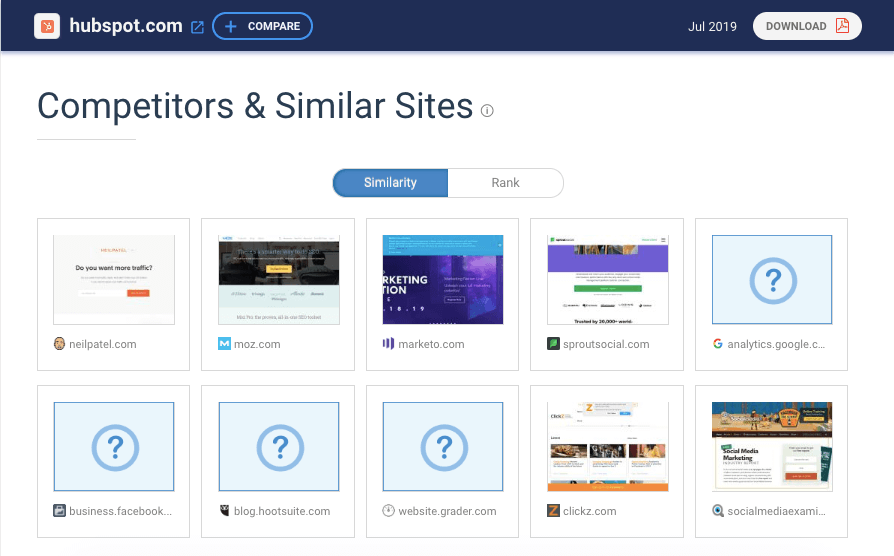
There are other tools like SimilarWeb that are worth a try to identify competitors:
- Alexa – Find Similar Sites
- Google Similar Pages
- Product Hunt
- AlternativeTo
If the competitor’s traffic is low, you most likely won’t get suggestions from these tools. In this case, you have to rely even more on user data and Google search results.
It’s also important to note that these tools provide estimated data. Without access to your competitors’ analytics (which you probably don’t have), you won’t know the real numbers. This is perfectly okay. To understand a competitor and their strategy you only need approximate numbers. Knowing if and how much they rely on search, paid, or social channels is already valuable without knowing the exact traffic they are getting through them.
What data should you compare?
The answer to this is quite simple: whatever is important to you. With today’s software and technology, you have the ability to know more about your competition than ever before.
Usually when I analyze competitors I go by the following categories:
- Background information : Company name, Website, Country, Services/Products/Features, Team size, Mobile Apps
- Marketing strategy and communication : Unique Value Proposition, marketing messages, benefits, communication channels, active social media channels, blog, etc.
- Traffic overview : Website traffic, traffic by country, traffic by source, traffic from social media channels
- Organic traffic : Monthly organic traffic, number of Referring domains, TOP10 referring domains, most popular pages, TOP10 keywords, backlink mix, domain rating, URL rating
You can check out the competitor analysis template I usually use here: Competitor Analysis Template
These competitor metrics can be used as benchmarks for your own business. They can help you set data-driven business goals.
To collect this data you need to use a mix of desktop research and online tools. For each category, I use the following tools or methods:
- Background information : Desktop research, LinkedIn , Owler , Capterra
- Marketing strategy and communication : Desktop research
- Traffic overview : SimilarWeb
- Organic traffic : Ahrefs , SemRush , Spyflu , MozBar
Out of these, only Ahrefs doesn’t have a free version; with the other tools, you’ll be just fine.
How many competitors should you compare?
This also comes down to how much time you have for it. The general answer is as many as possible to help you map out the competition and the market. The more practical answer is to analyze a minimum of 3 to 5 of your competitors. That should give you enough insight to move forward.
How to use the results?
After you’re done with the analysis, don’t just pat yourself on the back and close the file. Take a close look at your findings. Look for similarities in communication channels, patterns in messaging, and room for improvement.
For example: If you see that all of your competitors use LinkedIn but nobody uses Twitter, that can indicate that Twitter is not an efficient channel for reaching customers. Or if all of your competitors are strong in search traffic, that can mean that SEO can be a good marketing tactic although the competition will probably be high.
Write down these findings and insights as the summary of your competitor analysis, and you can use it in the future when developing your marketing strategy.
Channel mix research
Channel mix refers to the set of marketing channels you use to promote your business to your target audience. Your goal at this step is to identify the marketing channels that will be the most effective in reaching your target audience.
How do you define marketing channels?
Now let’s see how you can detect the potential marketing channels. I usually use a combination of these methods:
Use customer validation data
The result of your user research is the best way to go. No other channel will work better than the ones that your potential users say they’re using. So make sure to include questions about where your users consume content, what websites they regularly visit, what social media channels they’re using, etc.
Similarweb can be your sidekick with scouting marketing channels too. Choose a competitor and add its website to SimilarWeb. You can learn information about various channels this way.
- Direct: Visitors that type in the URL or a use bookmark to visit the page
- Referral: Visitors coming from referral pages due to off-page SEO activity
- Search: Visitors coming from organic search
- Social: Visitors coming from social channels
- Mail: Visitors coming from email marketing
- Display: Visitors from paid and display ads
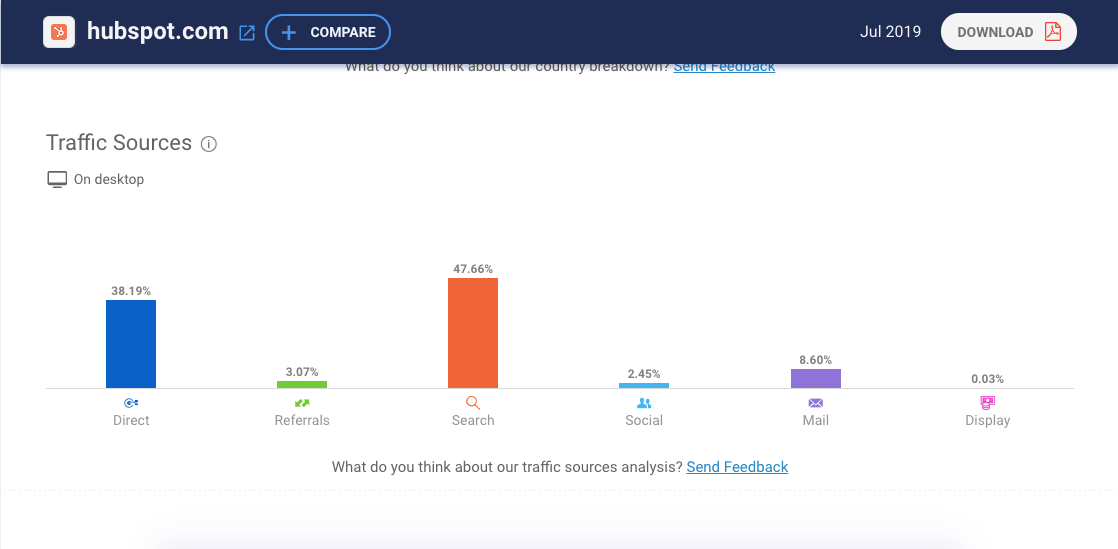
- Scroll to “Social” . Here you will see which social networks are sending traffic to the website. This will help you identify the social channels that work best for your competitors.
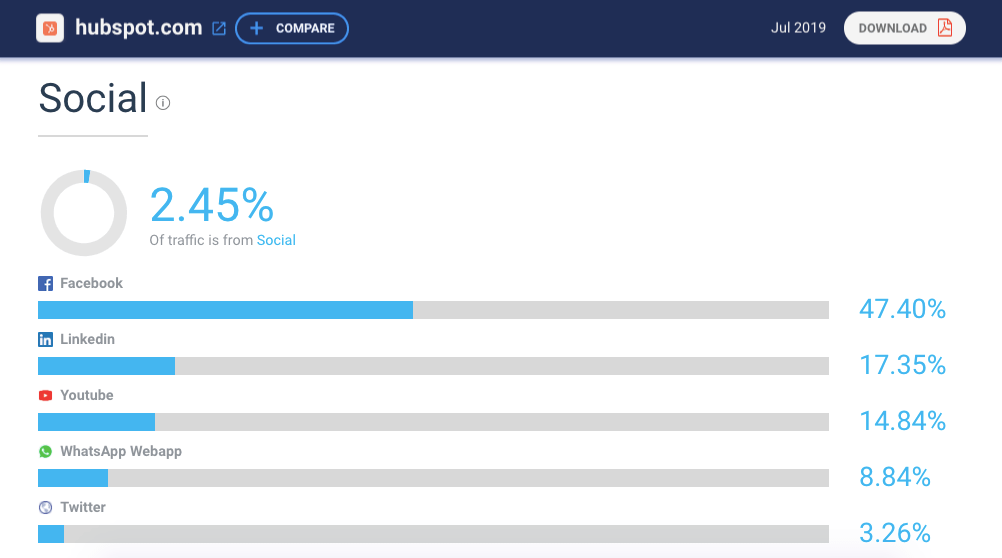
- Scroll to “Display Advertising” . Here you will see where your competitor is advertising itself, which can give you a good idea of what ad platform you should use.
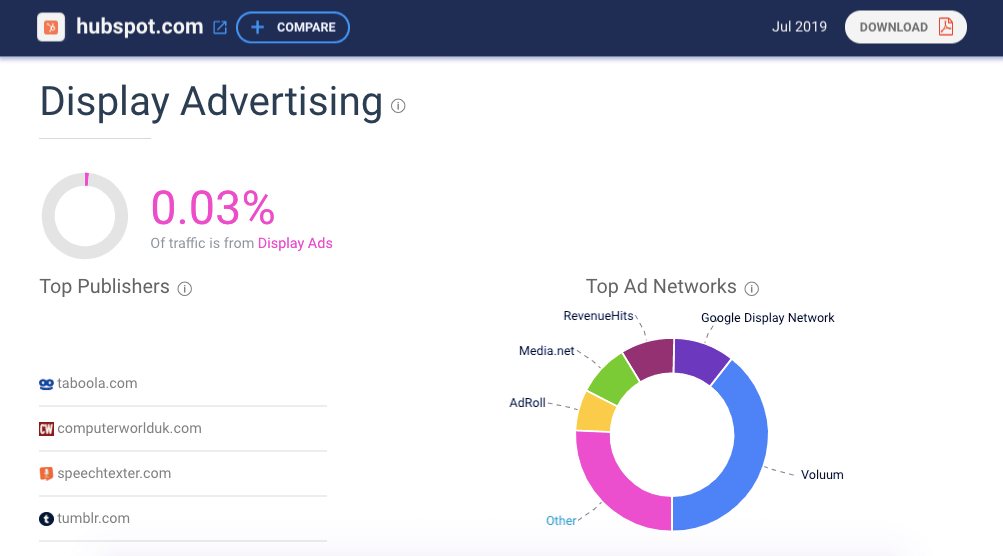
Desktop research
If your competitors’ website traffic is low, SimilarWeb won’t help you with identifying channels. In this case, you can use good, old-fashioned desktop research:
- Research forums related to your idea
- See where people ask questions about topics related to your idea
- Research social media channels and groups, and look for discussions related to your business
Marketing channel mix vs. idea validation channel mix
During these steps, you’ll most likely identify various types of channels. But we need to make a distinction between marketing channels and channels for validation.
Channels for validation won’t necessarily be the same ones that you’ll use for marketing reasons, but they can indicate what will work in the future. To be able to use a marketing channel for idea validation, it should meet two requirements :
- It has to provide fast response , meaning you need the feedback from the users within a few days or weeks.
- It has to include a high number from your target audience so that your sample user group is large enough.
Based on my previous experience, the channels that comply with these terms are:
- Paid Ads: Facebook, Instagram, LinkedIn, Snapchat, Quora, Adwords, Bing Ads
- Forums : Reddit, Quora, domain-specific forums
- Social Groups : Facebook, LinkedIn, Slack groups
We’ve arrived at the last step of market research: the keyword analysis. When I say keyword research, it’s not the usual SEO-purposed research. The goal of this step is to get a grasp of the wording the target audience uses when they talk about your solution.
Apart from that, keyword research at the idea stage helps with :
- Indicating the presence and rate of market need : the higher the search volume, the bigger the market need is
- Drafting copies : the right word usage can directly affect the success of your emails, ads, and landing page conversion
- Forecasting the intensity of your competition : the higher the CPC, the fiercer the competition
How to define your keywords?
If you couldn’t tell by now, your customer validation data is a goldmine. If you do it right, you basically have the answer to all of the above-mentioned steps. So once again, dig into your research and search frequent wordings and phrases that are connected to your idea. Collect these phrases in a doc to have a list of keywords you can use later in your copies.
Research forums and social media
Forums, Q&A sites, and social media groups can be a great source for finding the typical words that your target audience uses. Head to a platform, insert keywords related to your idea, and check the questions and discussion about them. Then collect the phrases in your keywords doc.
Such platforms can be Reddit , Quora , Hackernews , ProductHunt , or domain-specific forums. With social media, try to find related groups on LinkedIn and Facebook, and check how people talk about the topic. This way is quite time-consuming, but you can find hidden gems if you dig deep.
Analyze your competitors
You can also check what keywords and phrases your competitors are using. If you see words pop up often then it’s a good chance that if you use those users will understand your offer.
Conduct Google research
If none of the above worked or you just feel you need more keywords, you can still do Google research. Go to Google and research the keywords that you think are related to your idea. Then scan through the content on the first few pages:
- Check the first 10-20 hits: is the content related to your idea? Is the search intent related to your idea?
- Rate the keywords based on relevance, and focus on the ones that are the most relevant
How to use the collected keywords?
Now that you have a list of keywords, what should you do with them? You can go in several directions:
- Use keywords when crafting your marketing messages : Include the keywords in your value proposition, your landing page copy, and your ads and emails. This way your users will see familiar phrases and will understand your offer easier.
- Analyze the keywords from an SEO point of view: check search volume, competition, and other metrics. I usually use the Keyword Planner (you need a free Adwords account to use that) or any other SEO tool like SemRush .
This concludes the market research phase of the idea validation process. This step helps you understand your competition better, gives you guidance on the channels you should use, and helps you clarify the language your target audience is using to describe your idea. In the next and final part of this blog series, I will show you how to put your research in practice and test your value proposition on the market with real users. If you have any questions or thoughts to share, leave a comment or drop us a line .
DID YOU LOVE IT?
Join our mailing list and receive handy tricks and tips on product development right to your inbox.
Thanks! You successfully subscribed.
I have read and accepted the Privacy Policy.
Get exclusive content
Related posts

Check out how a hybrid BMW looks in your own garage
case study , product development
“D³: DeepDiveDev” is Dina’s series of development project related articles — our teach team’s mind poured out on paper with all creativity.
Get ready: the next article will be a big story the story of BMW virtual reality project – as originally narrated by Tamás Harkai.
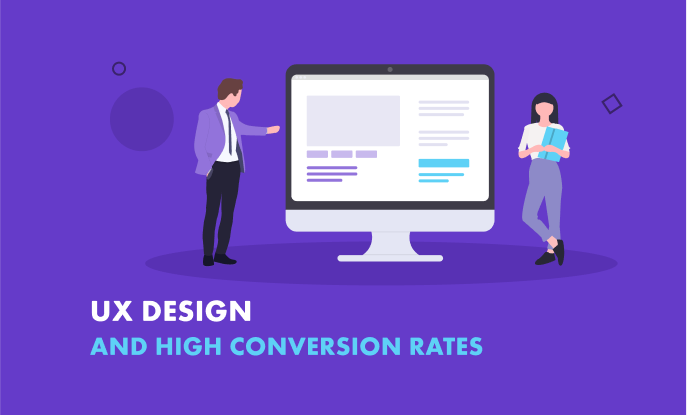
The Relationship Between UX Design and High Conversion Rates
Let’s take a look at UX design and how it walks hand-in-hand with high conversion rates and learn what it takes to increase the sales on your site through design.

A nice recommendation from Cisco’s new acquisition on Clutch
It feels great to receive a nice review, but it feels even greater when it comes from someone special. That’s why we were so pleased when we were notified about our latest review on Clutch, a B2B ratings and reviews platform. It’s worth knowing about Clutch that they...

- Privacy Overview
- Strictly Necessary Cookies
This website uses cookies so that we can provide you with the best user experience possible. Cookie information is stored in your browser and performs functions such as recognising you when you return to our website and helping our team to understand which sections of the website you find most interesting and useful.
Strictly Necessary Cookie should be enabled at all times so that we can save your preferences for cookie settings.
If you disable this cookie, we will not be able to save your preferences. This means that every time you visit this website you will need to enable or disable cookies again.
- SUGGESTED TOPICS
- The Magazine
- Newsletters
- Managing Yourself
- Managing Teams
- Work-life Balance
- The Big Idea
- Data & Visuals
- Reading Lists
- Case Selections
- HBR Learning
- Topic Feeds
- Account Settings
- Email Preferences
Validating Product-Market Fit in the Real World
- Heather Myers
- Zasima Razack

Online ad platforms make it easy to obtain data-backed insights.
To test new products, most companies rely on creating “minimum viable products” and testing customer feedback, or conducting focus groups or marketing surveys. There’s another method companies should try: “heat-testing,” or testing consumer reaction to online advertisements. Heat-testing is revolutionary because it takes place in the real world. Unlike focus groups or surveys, which rely on what consumers say, people who click or like an ad are demonstrating actual behavior and interest, which can be a more powerful form of feedback.
Since the invention of surveys in the 1930s, companies have used market research to size up consumer needs. Focus groups generate inputs about behavior and attitudes. Tools like conjoint analysis explore trade-offs consumers make when considering a product purchase. Large panels estimate the market opportunity for a particular product.
- HM Heather Myers is the founder and CEO of Spark No. 9, a growth strategy consultancy.
- ZR Zasima Razack , a former beauty executive at Bath & Body Works and L’Oreal, is vice president of strategy & innovation at Spark No. 9, a growth strategy consultancy.
Partner Center
- Privacy Policy
Buy Me a Coffee

Home » Validity – Types, Examples and Guide
Validity – Types, Examples and Guide
Table of Contents

Definition:
Validity refers to the extent to which a concept, measure, or study accurately represents the intended meaning or reality it is intended to capture. It is a fundamental concept in research and assessment that assesses the soundness and appropriateness of the conclusions, inferences, or interpretations made based on the data or evidence collected.
Research Validity
Research validity refers to the degree to which a study accurately measures or reflects what it claims to measure. In other words, research validity concerns whether the conclusions drawn from a study are based on accurate, reliable and relevant data.
Validity is a concept used in logic and research methodology to assess the strength of an argument or the quality of a research study. It refers to the extent to which a conclusion or result is supported by evidence and reasoning.
How to Ensure Validity in Research
Ensuring validity in research involves several steps and considerations throughout the research process. Here are some key strategies to help maintain research validity:
Clearly Define Research Objectives and Questions
Start by clearly defining your research objectives and formulating specific research questions. This helps focus your study and ensures that you are addressing relevant and meaningful research topics.
Use appropriate research design
Select a research design that aligns with your research objectives and questions. Different types of studies, such as experimental, observational, qualitative, or quantitative, have specific strengths and limitations. Choose the design that best suits your research goals.
Use reliable and valid measurement instruments
If you are measuring variables or constructs, ensure that the measurement instruments you use are reliable and valid. This involves using established and well-tested tools or developing your own instruments through rigorous validation processes.
Ensure a representative sample
When selecting participants or subjects for your study, aim for a sample that is representative of the population you want to generalize to. Consider factors such as age, gender, socioeconomic status, and other relevant demographics to ensure your findings can be generalized appropriately.
Address potential confounding factors
Identify potential confounding variables or biases that could impact your results. Implement strategies such as randomization, matching, or statistical control to minimize the influence of confounding factors and increase internal validity.
Minimize measurement and response biases
Be aware of measurement biases and response biases that can occur during data collection. Use standardized protocols, clear instructions, and trained data collectors to minimize these biases. Employ techniques like blinding or double-blinding in experimental studies to reduce bias.
Conduct appropriate statistical analyses
Ensure that the statistical analyses you employ are appropriate for your research design and data type. Select statistical tests that are relevant to your research questions and use robust analytical techniques to draw accurate conclusions from your data.
Consider external validity
While it may not always be possible to achieve high external validity, be mindful of the generalizability of your findings. Clearly describe your sample and study context to help readers understand the scope and limitations of your research.
Peer review and replication
Submit your research for peer review by experts in your field. Peer review helps identify potential flaws, biases, or methodological issues that can impact validity. Additionally, encourage replication studies by other researchers to validate your findings and enhance the overall reliability of the research.
Transparent reporting
Clearly and transparently report your research methods, procedures, data collection, and analysis techniques. Provide sufficient details for others to evaluate the validity of your study and replicate your work if needed.
Types of Validity
There are several types of validity that researchers consider when designing and evaluating studies. Here are some common types of validity:
Internal Validity
Internal validity relates to the degree to which a study accurately identifies causal relationships between variables. It addresses whether the observed effects can be attributed to the manipulated independent variable rather than confounding factors. Threats to internal validity include selection bias, history effects, maturation of participants, and instrumentation issues.
External Validity
External validity concerns the generalizability of research findings to the broader population or real-world settings. It assesses the extent to which the results can be applied to other individuals, contexts, or timeframes. Factors that can limit external validity include sample characteristics, research settings, and the specific conditions under which the study was conducted.
Construct Validity
Construct validity examines whether a study adequately measures the intended theoretical constructs or concepts. It focuses on the alignment between the operational definitions used in the study and the underlying theoretical constructs. Construct validity can be threatened by issues such as poor measurement tools, inadequate operational definitions, or a lack of clarity in the conceptual framework.
Content Validity
Content validity refers to the degree to which a measurement instrument or test adequately covers the entire range of the construct being measured. It assesses whether the items or questions included in the measurement tool represent the full scope of the construct. Content validity is often evaluated through expert judgment, reviewing the relevance and representativeness of the items.
Criterion Validity
Criterion validity determines the extent to which a measure or test is related to an external criterion or standard. It assesses whether the results obtained from a measurement instrument align with other established measures or outcomes. Criterion validity can be divided into two subtypes: concurrent validity, which examines the relationship between the measure and the criterion at the same time, and predictive validity, which investigates the measure’s ability to predict future outcomes.
Face Validity
Face validity refers to the degree to which a measurement or test appears, on the surface, to measure what it intends to measure. It is a subjective assessment based on whether the items seem relevant and appropriate to the construct being measured. Face validity is often used as an initial evaluation before conducting more rigorous validity assessments.
Importance of Validity
Validity is crucial in research for several reasons:
- Accurate Measurement: Validity ensures that the measurements or observations in a study accurately represent the intended constructs or variables. Without validity, researchers cannot be confident that their results truly reflect the phenomena they are studying. Validity allows researchers to draw accurate conclusions and make meaningful inferences based on their findings.
- Credibility and Trustworthiness: Validity enhances the credibility and trustworthiness of research. When a study demonstrates high validity, it indicates that the researchers have taken appropriate measures to ensure the accuracy and integrity of their work. This strengthens the confidence of other researchers, peers, and the wider scientific community in the study’s results and conclusions.
- Generalizability: Validity helps determine the extent to which research findings can be generalized beyond the specific sample and context of the study. By addressing external validity, researchers can assess whether their results can be applied to other populations, settings, or situations. This information is valuable for making informed decisions, implementing interventions, or developing policies based on research findings.
- Sound Decision-Making: Validity supports informed decision-making in various fields, such as medicine, psychology, education, and social sciences. When validity is established, policymakers, practitioners, and professionals can rely on research findings to guide their actions and interventions. Validity ensures that decisions are based on accurate and trustworthy information, which can lead to better outcomes and more effective practices.
- Avoiding Errors and Bias: Validity helps researchers identify and mitigate potential errors and biases in their studies. By addressing internal validity, researchers can minimize confounding factors and alternative explanations, ensuring that the observed effects are genuinely attributable to the manipulated variables. Validity assessments also highlight measurement errors or shortcomings, enabling researchers to improve their measurement tools and procedures.
- Progress of Scientific Knowledge: Validity is essential for the advancement of scientific knowledge. Valid research contributes to the accumulation of reliable and valid evidence, which forms the foundation for building theories, developing models, and refining existing knowledge. Validity allows researchers to build upon previous findings, replicate studies, and establish a cumulative body of knowledge in various disciplines. Without validity, the scientific community would struggle to make meaningful progress and establish a solid understanding of the phenomena under investigation.
- Ethical Considerations: Validity is closely linked to ethical considerations in research. Conducting valid research ensures that participants’ time, effort, and data are not wasted on flawed or invalid studies. It upholds the principle of respect for participants’ autonomy and promotes responsible research practices. Validity is also important when making claims or drawing conclusions that may have real-world implications, as misleading or invalid findings can have adverse effects on individuals, organizations, or society as a whole.
Examples of Validity
Here are some examples of validity in different contexts:
- Example 1: All men are mortal. John is a man. Therefore, John is mortal. This argument is logically valid because the conclusion follows logically from the premises.
- Example 2: If it is raining, then the ground is wet. The ground is wet. Therefore, it is raining. This argument is not logically valid because there could be other reasons for the ground being wet, such as watering the plants.
- Example 1: In a study examining the relationship between caffeine consumption and alertness, the researchers use established measures of both variables, ensuring that they are accurately capturing the concepts they intend to measure. This demonstrates construct validity.
- Example 2: A researcher develops a new questionnaire to measure anxiety levels. They administer the questionnaire to a group of participants and find that it correlates highly with other established anxiety measures. This indicates good construct validity for the new questionnaire.
- Example 1: A study on the effects of a particular teaching method is conducted in a controlled laboratory setting. The findings of the study may lack external validity because the conditions in the lab may not accurately reflect real-world classroom settings.
- Example 2: A research study on the effects of a new medication includes participants from diverse backgrounds and age groups, increasing the external validity of the findings to a broader population.
- Example 1: In an experiment, a researcher manipulates the independent variable (e.g., a new drug) and controls for other variables to ensure that any observed effects on the dependent variable (e.g., symptom reduction) are indeed due to the manipulation. This establishes internal validity.
- Example 2: A researcher conducts a study examining the relationship between exercise and mood by administering questionnaires to participants. However, the study lacks internal validity because it does not control for other potential factors that could influence mood, such as diet or stress levels.
- Example 1: A teacher develops a new test to assess students’ knowledge of a particular subject. The items on the test appear to be relevant to the topic at hand and align with what one would expect to find on such a test. This suggests face validity, as the test appears to measure what it intends to measure.
- Example 2: A company develops a new customer satisfaction survey. The questions included in the survey seem to address key aspects of the customer experience and capture the relevant information. This indicates face validity, as the survey seems appropriate for assessing customer satisfaction.
- Example 1: A team of experts reviews a comprehensive curriculum for a high school biology course. They evaluate the curriculum to ensure that it covers all the essential topics and concepts necessary for students to gain a thorough understanding of biology. This demonstrates content validity, as the curriculum is representative of the domain it intends to cover.
- Example 2: A researcher develops a questionnaire to assess career satisfaction. The questions in the questionnaire encompass various dimensions of job satisfaction, such as salary, work-life balance, and career growth. This indicates content validity, as the questionnaire adequately represents the different aspects of career satisfaction.
- Example 1: A company wants to evaluate the effectiveness of a new employee selection test. They administer the test to a group of job applicants and later assess the job performance of those who were hired. If there is a strong correlation between the test scores and subsequent job performance, it suggests criterion validity, indicating that the test is predictive of job success.
- Example 2: A researcher wants to determine if a new medical diagnostic tool accurately identifies a specific disease. They compare the results of the diagnostic tool with the gold standard diagnostic method and find a high level of agreement. This demonstrates criterion validity, indicating that the new tool is valid in accurately diagnosing the disease.
Where to Write About Validity in A Thesis
In a thesis, discussions related to validity are typically included in the methodology and results sections. Here are some specific places where you can address validity within your thesis:
Research Design and Methodology
In the methodology section, provide a clear and detailed description of the measures, instruments, or data collection methods used in your study. Discuss the steps taken to establish or assess the validity of these measures. Explain the rationale behind the selection of specific validity types relevant to your study, such as content validity, criterion validity, or construct validity. Discuss any modifications or adaptations made to existing measures and their potential impact on validity.
Measurement Procedures
In the methodology section, elaborate on the procedures implemented to ensure the validity of measurements. Describe how potential biases or confounding factors were addressed, controlled, or accounted for to enhance internal validity. Provide details on how you ensured that the measurement process accurately captures the intended constructs or variables of interest.
Data Collection
In the methodology section, discuss the steps taken to collect data and ensure data validity. Explain any measures implemented to minimize errors or biases during data collection, such as training of data collectors, standardized protocols, or quality control procedures. Address any potential limitations or threats to validity related to the data collection process.
Data Analysis and Results
In the results section, present the analysis and findings related to validity. Report any statistical tests, correlations, or other measures used to assess validity. Provide interpretations and explanations of the results obtained. Discuss the implications of the validity findings for the overall reliability and credibility of your study.
Limitations and Future Directions
In the discussion or conclusion section, reflect on the limitations of your study, including limitations related to validity. Acknowledge any potential threats or weaknesses to validity that you encountered during your research. Discuss how these limitations may have influenced the interpretation of your findings and suggest avenues for future research that could address these validity concerns.
Applications of Validity
Validity is applicable in various areas and contexts where research and measurement play a role. Here are some common applications of validity:
Psychological and Behavioral Research
Validity is crucial in psychology and behavioral research to ensure that measurement instruments accurately capture constructs such as personality traits, intelligence, attitudes, emotions, or psychological disorders. Validity assessments help researchers determine if their measures are truly measuring the intended psychological constructs and if the results can be generalized to broader populations or real-world settings.
Educational Assessment
Validity is essential in educational assessment to determine if tests, exams, or assessments accurately measure students’ knowledge, skills, or abilities. It ensures that the assessment aligns with the educational objectives and provides reliable information about student performance. Validity assessments help identify if the assessment is valid for all students, regardless of their demographic characteristics, language proficiency, or cultural background.
Program Evaluation
Validity plays a crucial role in program evaluation, where researchers assess the effectiveness and impact of interventions, policies, or programs. By establishing validity, evaluators can determine if the observed outcomes are genuinely attributable to the program being evaluated rather than extraneous factors. Validity assessments also help ensure that the evaluation findings are applicable to different populations, contexts, or timeframes.
Medical and Health Research
Validity is essential in medical and health research to ensure the accuracy and reliability of diagnostic tools, measurement instruments, and clinical assessments. Validity assessments help determine if a measurement accurately identifies the presence or absence of a medical condition, measures the effectiveness of a treatment, or predicts patient outcomes. Validity is crucial for establishing evidence-based medicine and informing medical decision-making.
Social Science Research
Validity is relevant in various social science disciplines, including sociology, anthropology, economics, and political science. Researchers use validity to ensure that their measures and methods accurately capture social phenomena, such as social attitudes, behaviors, social structures, or economic indicators. Validity assessments support the reliability and credibility of social science research findings.
Market Research and Surveys
Validity is important in market research and survey studies to ensure that the survey questions effectively measure consumer preferences, buying behaviors, or attitudes towards products or services. Validity assessments help researchers determine if the survey instrument is accurately capturing the desired information and if the results can be generalized to the target population.
Limitations of Validity
Here are some limitations of validity:
- Construct Validity: Limitations of construct validity include the potential for measurement error, inadequate operational definitions of constructs, or the failure to capture all aspects of a complex construct.
- Internal Validity: Limitations of internal validity may arise from confounding variables, selection bias, or the presence of extraneous factors that could influence the study outcomes, making it difficult to attribute causality accurately.
- External Validity: Limitations of external validity can occur when the study sample does not represent the broader population, when the research setting differs significantly from real-world conditions, or when the study lacks ecological validity, i.e., the findings do not reflect real-world complexities.
- Measurement Validity: Limitations of measurement validity can arise from measurement error, inadequately designed or flawed measurement scales, or limitations inherent in self-report measures, such as social desirability bias or recall bias.
- Statistical Conclusion Validity: Limitations in statistical conclusion validity can occur due to sampling errors, inadequate sample sizes, or improper statistical analysis techniques, leading to incorrect conclusions or generalizations.
- Temporal Validity: Limitations of temporal validity arise when the study results become outdated due to changes in the studied phenomena, interventions, or contextual factors.
- Researcher Bias: Researcher bias can affect the validity of a study. Biases can emerge through the researcher’s subjective interpretation, influence of personal beliefs, or preconceived notions, leading to unintentional distortion of findings or failure to consider alternative explanations.
- Ethical Validity: Limitations can arise if the study design or methods involve ethical concerns, such as the use of deceptive practices, inadequate informed consent, or potential harm to participants.
Also see Reliability Vs Validity
About the author
Muhammad Hassan
Researcher, Academic Writer, Web developer
You may also like

Internal Consistency Reliability – Methods...

Internal Validity – Threats, Examples and Guide

Split-Half Reliability – Methods, Examples and...

Alternate Forms Reliability – Methods, Examples...

Reliability – Types, Examples and Guide

Test-Retest Reliability – Methods, Formula and...
- Open supplemental data
- Reference Manager
- Simple TEXT file
People also looked at
Original research article, comprehensive identification, localization, and validation of innovation measurement indices at the farm level in iran.

- 1 Department of Agricultural Extension and Education, College of Agriculture, Tarbiat Modares University (TMU), Tehran, Iran
- 2 Department of Futures Study, School of Social Sciences, Imam Khomeini International University, Qazvin, Iran
Introduction: Innovation is a fundamental component of agricultural infrastructure, fostering the sector’s development and productivity. Innovation indices tailored to the farm level are benchmarks for assessing innovation within this agricultural context. Therefore, this study aims to discover, localize, and validate comprehensive innovation measurement indices at the farm level. A distinguishing feature of this research is its endeavor to discover and validate a comprehensive tool for measuring innovation at the farm level. Notably, there has been no prior research on discovering comprehensive innovation indices at the farm level, marking a novel aspect of this study.
Method and results: The current research is applied in terms of its purpose and falls into the category of mixed research (quantitative and qualitative), as well as exploratory and descriptive research. This study has been conducted in three stages: The first phase involved reviewing existing literature and extracting indices for measuring innovation. In the second phase, a tool was designed specifically to gauge innovation at the farm level. The third phase entailed face and content validation of the identified indices. This validation process was conducted quantitatively and qualitatively through surveys of subject-matter experts in Iran, and by calculating the content validity ratio (CVR) and content validity index (CVI).
To measure innovation at the farm level, 90 items across 7 dimensions (education, infrastructure, market sophistication, business sophistication, knowledge and technology outputs, creative outputs, and innovative outputs) were extracted, localized, and developed. According to the results, dimensions such as innovative outputs (product innovation, process innovation, and marketing innovation), education (farmers’ education status in technology and innovation), and infrastructure (familiarity, access, and application of Information and Communication Technology [ICT]) demonstrated high credibility based on CVR and CVI scores.
Conclusion: The utilization of innovation assessment indices can help mitigate the challenges associated with evaluating innovation status on farms, thereby enhancing their condition and increasing farmers’ profitability. Accurate and reliable data on innovation status empower farmers in market competition and improve economic performance. Attention to innovation and the use of assessment tools can facilitate the attraction of new investors to the agricultural industry. Furthermore, improving agricultural processes through innovative technologies can contribute to the preservation of natural resources and the reduction of environmental pollution.
1 Introduction
Agriculture serves as the foundation of human survival and the economic and industrial base of many countries. However, its development still faces specific challenges such as food security, imbalances in nutritional structure, and resource scarcity ( Lei et al., 2023 ). There is a widespread belief that past technologies and experiences are no longer sufficient to address the opportunities and challenges agriculture will face in the future ( Fraser and Campbell, 2019 ). Emerging trends in agricultural technologies and innovations enable the production of animal and plant products with higher efficiency and reduced environmental impact ( Webb and Forum, 2018 ).
For instance, in a study conducted by Maroušek et al. (2013 , 2023a ), the economic and environmental benefits of producing and applying digestate biochar (derived from waste materials from the gas production process in biogas plants) were discussed. This biochar plays a significant role in wastewater treatment, reducing associated costs, improving soil quality, and controlling environmental pollution ( Maroušek et al., 2023b ). Additionally, Maroušek et al. (2022) demonstrated in another study that the application of silica nanoparticle technology (synthesized from coir pith using the acidic sol–gel method) enhances plant germination and growth while lowering production costs compared to traditional chemical and physical methods. In another study, they mentioned the utilization of an extractor (a device for extracting useful substances or energy-generating substances from raw materials) combined with shock pressure to extract rapeseed oil. In this method, biogas serves as an energy source to create pressure in the extractor device, leading to increased oil production and improved extraction efficiency. High pressure facilitates better and faster oil extraction and optimal utilization of renewable energy ( Maroušek, 2013 ; Maroušek et al., 2013 ). These innovative methods aim to enhance farm performance, improve the quality of agricultural products, reduce production costs, increase yields, boost income, and ensure food security. From an environmental perspective, these innovations can help improve water and soil quality, reduce greenhouse gas emissions, enhance energy efficiency, and promote the efficient use of natural resources ( Ogundari and Bolarinwa, 2018 ; Hellerstein and Vilorio, 2019 ; Herrero et al., 2020 ; Maroušek et al., 2023a , c ).
Developing countries heavily rely on agriculture; however, unfortunately, productivity in this sector remains very low. Agricultural innovations play a crucial role in enabling producers to tackle the sector’s major challenges ( Lema et al., 2021 ). A new report by the World Bank emphasizes that developing countries must significantly enhance agricultural innovation and the adoption of technology by farmers to eradicate poverty, meet the growing demand for food, and address the adverse effects of climate change ( Fuglie et al., 2019 ). Iran is no exception. With agriculture contributing approximately 7% of GDP, employing 18% of the workforce, and accounting for 6% of non-oil exports, while also supplying about 80% of food and 80–90% of raw materials required by industries, it holds a significant position in the country’s macroeconomy ( Bakhshayesh et al., 2020 ). In pursuit of economic development, the country has formulated a vision document aiming to establish itself as the leading knowledge-based economy in the region by 2026 ( Azimi et al., 2021 ). One of the key areas within this knowledge-based economy framework is knowledge-based agriculture, which entails increasing productivity and maximizing the utilization of knowledge and technology in agricultural and industrial production across the country ( Lainez et al., 2018 ). From the perspective of knowledge-based agriculture, the critical aspect is to foster innovation based on various technologies that should be accompanied by research ( Lainez et al., 2018 ). It’s worth noting that these technologies must be economically viable, as technologies that fail to generate economic returns cannot be considered sustainable in the long term. The sustainability of technology is directly linked to its profitability, as only profitable technologies can be continually developed and prove beneficial to society and the environment over an extended period ( Akbari et al., 2021 ; Pavolova et al., 2021 ).
In Iran, challenges such as high water consumption in agriculture, low yield per hectare in various crops and horticulture, as well as in livestock production, and deficiencies in production technology leading to low productivity, exemplify the current state of the agricultural sector in the country ( Keshavarz et al., 2021 ), which is not in line with the principles of a knowledge-based economy. Therefore, considering the existing situation of the agricultural sector in Iran and the significance of innovation in a knowledge-based economy, prioritizing the development of innovation in the agriculture sector as a foundational pillar of such an economy should be a top priority for policymakers and researchers in the country.
The impact of innovation on economic growth and economic superiority can be achieved in two ways: first, innovation can increase efficiency and the utilization of scarce resources, and second, it can enable the utilization of these resources in activities that generate more wealth. Therefore, given the importance of this issue, the measurement indices of innovative agriculture should be examined to assess and enhance the current status of innovation. However, despite the significance of innovation in the agricultural sector, agricultural industries are rarely the focus of innovation policies and are not perceived as underdeveloped sectors, or at least sectors in need of comprehensive research ( Andrade et al., 2020 ). Only a few countries have attempted to identify indices of innovation in this sector, which contrasts with the attention given to the industrial and service sectors ( OECD, 2018 ).
For instance, Bjerke and Johansson (2022) conducted a study on the innovation situation in agricultural and non-agricultural knowledge-based companies in Sweden. The indicators examined to measure innovation in companies included: human capital (employees with higher education, employees’ work experience), the company’s cooperation with other companies to develop its business, the introduction of products, services, processes, or new/improved marketing methods within the past 2 years ( Bjerke and Johansson, 2022 ). Additionally, Buchana and Sithole (2023) presented a conceptual framework to measure innovation in agricultural knowledge-based companies in developing countries in sub-Saharan Africa. In this framework, innovation was generally divided into two categories: technological innovations (product and process innovation) and non-technological innovations (organizational innovation and marketing), with indicators related to the measurement of each category determined ( Buchana and Sithole, 2023 ). Furthermore, Oliveira et al. (2019) considered factors such as product, process, marketing, and institutional innovation (incentives and institutional policies) to measure innovation in agriculture. Dutta et al. (2018) measured innovation in agricultural and food systems and offered a framework based on global innovation indicators. The indicators examined in this study included: (a) human capital and research, (b) market sophistication: financial markets, (c) knowledge and technology outputs, and (d) creative outputs ( Dutta et al., 2018 ). Läpple et al. (2015) also employed a composite indicator in their study to evaluate innovation in agriculture, including components related to the acceptance of innovation, knowledge acquisition, and investment in machinery at the farm level.
Currently, there is a shortage of research in the field of measuring innovation in the agricultural sector, especially at the farm level. One of the main reasons for this is the lack of indices to measure innovation. According to studies, the indices presented in this area are either incomplete or not suitable for the farm level ( Lei et al., 2023 ). Therefore, in addition to comprehensively identifying innovation measurement indices, it is necessary to localize these indices according to the farm level to investigate the innovation status in this field. The main challenge is the localization and development of innovation measurement indices appropriate for the farm level, followed by validation to determine their validity. To validate, the indices should undergo evaluation by several experts to create a list of items suitable for this sector with the necessary validity. The validated items are then used to measure the innovation status. In this context, the primary research question can be framed as follows: Which indices are appropriate and tailored for the agricultural sector? Additionally, how do experts evaluate the validity of these indices and their components in the context of farm conditions?
2 Research method
The method of this research is presented in detail in the following three steps:
2.1 The first step
In this step, extracting the indices of innovation was done by reviewing library resources and previous literature. The statistical population for this research step includes all articles related to this field that were published in prestigious journals between 2013 and 2023. We chose to focus on these 10 years because, considering the study’s emphasis on innovation, it’s crucial to incorporate more recent research. To search and find the articles, we used the keywords ‘innovation,’ ‘innovation in agriculture,’ ‘innovation in farm,’ ‘product innovation,’ ‘process innovation,’ ‘marketing innovation,’ ‘innovation system,’ ‘agricultural innovation system,’ ‘innovation indices,’ ‘innovation indices in agriculture’ were looked for in scientific databases such as Nature, Civilica, Ricest, Science Magazine, Elsevier, Scopus, Springer, Emerald, Web of Science, Magiran. To select the articles, 55 journals were reviewed, the most papers were published in the journals “research policy,” “agricultural systems,” “food policy,” “technology prediction, and social change,” and “innovation and development.” The selection process was as follows: at first, 302 articles were identified through the relevant title and then articles with relevant abstracts and related keywords were investigated. Furthermore, during the subsequent steps of selecting valid articles, those lacking a valid publisher were excluded from further consideration in the study. Ultimately, 32 articles and one book were included for content analysis. Figure 1 depicts the process of article selection along with the inclusion and exclusion criteria for the content analysis. The review began with the most relevant and highly cited articles, continuing until theoretical saturation was achieved.
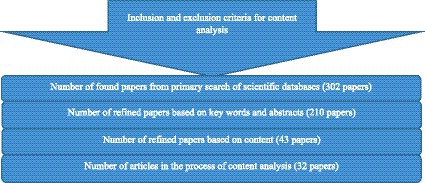
Figure 1 . Steps to selecting articles and inclusion and exclusion criteria for articles in the process of content analysis.
In this part of the study, for data analysis, qualitative content analysis of documents with a deductive approach was used to extract innovation indices. Qualitative content analysis serves as a research method for subjectively interpreting textual data through systematic classification, encoding, and theme development, based on known patterns. These definitions underscore how qualitative content analysis enables researchers to subjectively interpret the authenticity and truthfulness of data while maintaining a scientific approach. The presence of a systematic encoding process ensures the objectivity of the results. Qualitative content analysis delves deeper than the words or objective content of texts, exploring both apparent and hidden themes or patterns within explicit content ( Graneheim et al., 2017 ; Kleinheksel et al., 2020 ).
Qualitative content analysis encompasses two main approaches: inductive and deductive. Inductive content analysis becomes essential when there’s insufficient information about a phenomenon, and the researcher aims to establish necessary background knowledge. Here, the objective of inductive research is to facilitate the emergence of research findings by identifying dominant and common themes within the data. This involves gradually summarizing collected data to ultimately uncover the main concepts and themes pertinent to the research topic. Unlike the deductive approach, which begins with a predetermined theoretical framework and tests hypotheses, inductive content analysis adopts a bottom-up, exploratory, and open approach. In this method, coding initiates without predetermined codes, allowing researchers to identify codes (main categories) through the analysis of the data set ( Krippendorff, 2018 ; Kleinheksel et al., 2020 ).
Deductive content analysis, unlike inductive content analysis, relies on pre-existing research or theories to analyze data. Researchers begin with a set of predetermined categories or codes and then apply them to the data in a top-down approach for the sake of meaning-making. The use of this approach becomes necessary when the research is to test previous theories or expand them in a different context. Existing theories and literature in a field can help predict variables and the relationships between them. Hence, it is possible to guide the study process in a more structured way by taking advantage of previous views. The existing theories help us achieve the operational definition of the desired concepts. This operational definition provides the required categories of research. The operational definition is composed of implicit attributes in each variable, and these attributes must be comprehensive. The main categories representing the subject under investigation are extracted from the operational definition. While conducting qualitative content analysis with a deductive approach, the research starts with theory and theoretical framework. Defining the codes is done before and during the analysis, and extracting the codes is done from the theory or research findings. Coding in this approach is top-down, where researchers start with a set of predetermined codes (categories) and then find excerpts that fit those codes ( Krippendorff, 2018 ; Kibiswa, 2019 ; Kleinheksel et al., 2020 ). The reason why we used this approach in the current study was to expand the theory related to global innovation indicators in the field of agriculture and at the farm level, and the coding was carried out with a set of predetermined codes (main categories) which are considered to be the global indicators of innovation (human capital and research, market sophistication, business sophistication, infrastructure, knowledge and technology outputs, creative outputs, and innovative outputs), and then related excerpts (concepts) found by reviewing previous studies were placed in the main categories ( Table 1 ).
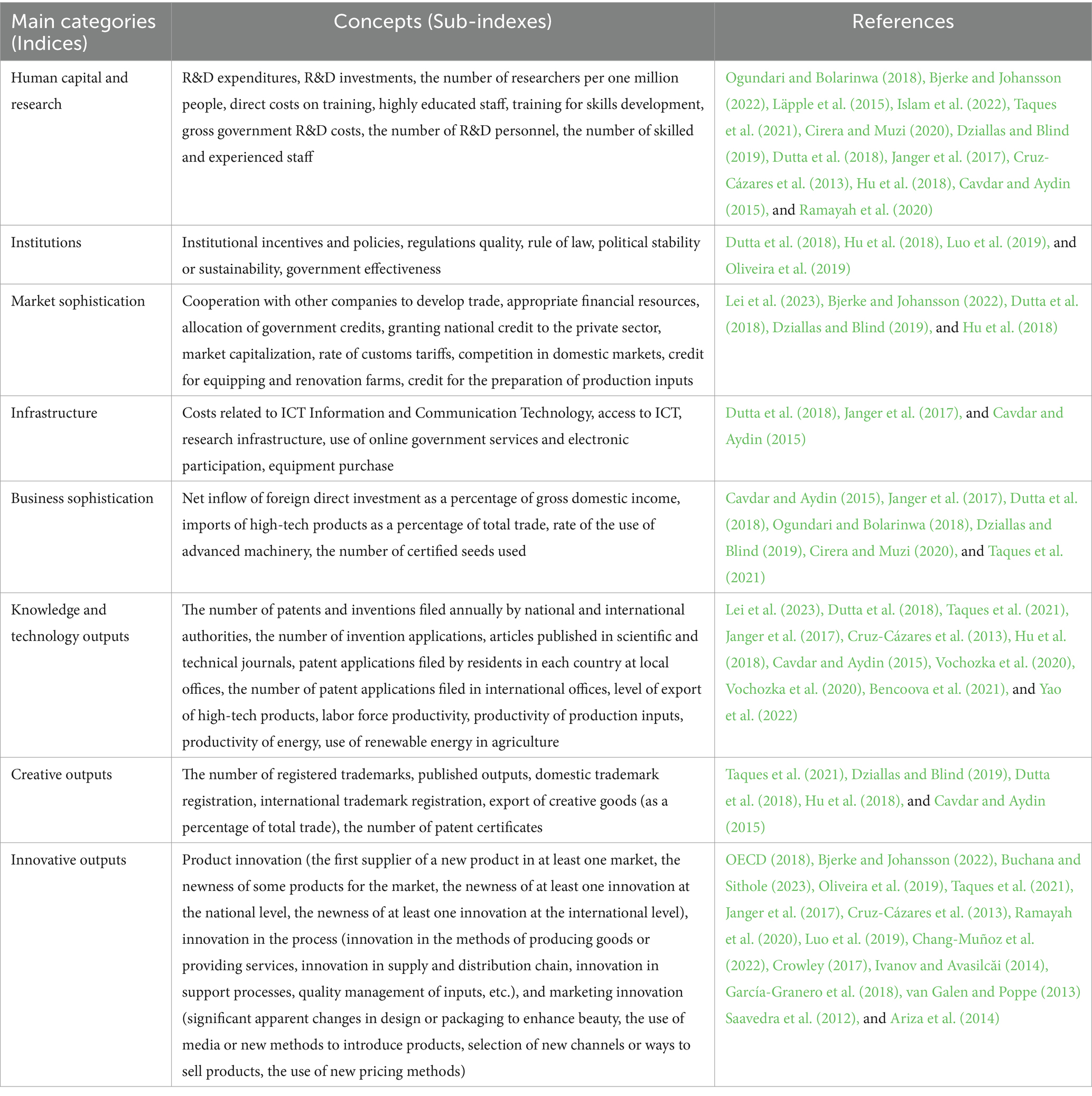
Table 1 . Main categories and concepts related to innovation and innovation in agriculture.
2.2 The second step
The second step consisted of localization of the extracted innovation indices according to the farm level and then designing primary questionnaires. This questionnaire was designed by the researcher. To design a researcher-made questionnaire, first, the global innovation indices and indices related to the innovation model of the OECD were used, then these indices were localized according to the farm level, and valid sources were used to localize the indices ( Dutta et al., 2018 ; OECD, 2018 ; Lei et al., 2023 ). These dimensions and indices are:
1. Education (Farmers’ education status): This indicator has 16 items measured by a 5-point Likert scale and an interval scale.
2. Infrastructure: This dimension has three general indices (familiarity with the application of ICT, access to ICT, and application of ICT by farmers) and 24 items designed as a 5-point Likert scale.
3. Business sophistication: This dimension was localized at the farm level with the title of the type of inputs used and had 8 items and redesigned as a question format.
4. Market sophistication: This dimension was localized at the farm level with the title of the credit indicator for the renovation of farms and the number of credits for the preparation of new inputs and had 10 items that were designed as open question and interval scale.
5. Knowledge and Technology Outputs: This dimension was localized at the farm level with the title of production factors productivity indicator and had 12 items that were designed as open question and interval scale.
6. Creative outputs: This dimension was designed at the farm level, with 2 items (trademarks and patents) as a nominal scale.
7. Innovative outputs: This dimension was localized at the farm level with the title of product innovation indicator, process innovation, and marketing innovation and had 18 items that were designed as a nominal scale, a five-point Likert scale, and an interval scale.
2.3 The third step
At this step, the compiled indices were sent to the subject-matter experts in Iran for quantitative and qualitative validation. Surveys of subject-matter experts were conducted in two stages. In the first stage, the face validity of the questionnaire was tested. To do the initial assessment, the extracted indices were sent to 10 subject-matter experts, and after getting feedback and applying their opinions, several cases were removed and some of them were corrected. At this stage, the face validity of the questionnaire was approved. In this stage, the experts were asked whether the appearance of the questionnaire was properly designed to evaluate the researcher’s goal (identification and localization of innovation indices at the farm level). In this stage, subject-matter experts were asked about the suitability, attractiveness, and logical sequence of questions as well as the abbrevity and comprehensiveness of the questionnaire ( Dehhaghi et al., 2022 ). After approving face validity, to determine the qualitative and quantitative content validity, the questionnaire was sent to the subject-matter experts. Subject-matter experts included university professors and subject-matter experts in the field of innovation and innovation in the agricultural sector in Iran. Criterion-based sampling method was used to select these subjects. In the criterion-based sampling method, several criteria are identified, and based on the criteria the statistical population is limited and more limited to achieve the desired sample ( Creswell and Creswell, 2017 ). In this research, participants were included based on the following criteria: (a) holding a doctoral degree in the field of study (innovation or entrepreneurship in agriculture), (b) having published an article on the topic under investigation, (c) demonstrating accountability, and (d) possessing over 10 years of agricultural experience. A total of 24 individuals were selected as research participants to evaluate both the qualitative and quantitative content validity.
3 Content validity
Content validity refers to a process that determines to what extent the dimensions and elements of a concept can be successfully defined ( Ghazali et al., 2017 ). The content validity indicates how much a scale or questionnaire measures all aspects of the desired construct. To determine the content validity of the questionnaire, experts’ judgment and the assessment of the coverage extent and appropriateness of the questions with the objectives of the research were used. In this study, this indicator was used to ensure whether the items related to the questionnaires were designed in the best possible way or not. One of the most widely used methods for measuring content validity was created by Lawshe in 1975. It is essentially a method of measuring agreement between assessors or referees (inter-rater agreement) about the importance of a particular item ( Obilor and Miwari, 2022 ). In this study, to quantitatively confirm the content validity of questionnaires, Lawshe’s (1975) method was used. In Lawshe’s (1975) method, CVR and CVI were determined. To calculate this ratio, the members of the expert board judge each item in terms of the necessity and relevance of the item.
3.1 Determining content validity ratio (CVR)
To determine this coefficient, the questions were given to experts in the form of a questionnaire, and they were asked to determine the appropriateness of each of the items of the questionnaire based on a three-point range of “necessary”, “useful but not necessary” and “not necessary”. After collecting expert opinions, the CVR for each item was determined using the following formula.
In this formula:
N: The total number of experts.
n: The number of experts who have chosen the “necessary” option
In the Lawshe method, the minimum acceptable CVR is determined based on the number of board members. The minimum CVR required for board members of 24 is 0.37 ( Table 2 ) ( Lawshe, 1975 ). Therefore, this coefficient was applied to each of the questions, and questions whose validity was less than this amount were excluded from the questionnaire, but questions that were equal to or bigger than this amount were included in the questionnaire.
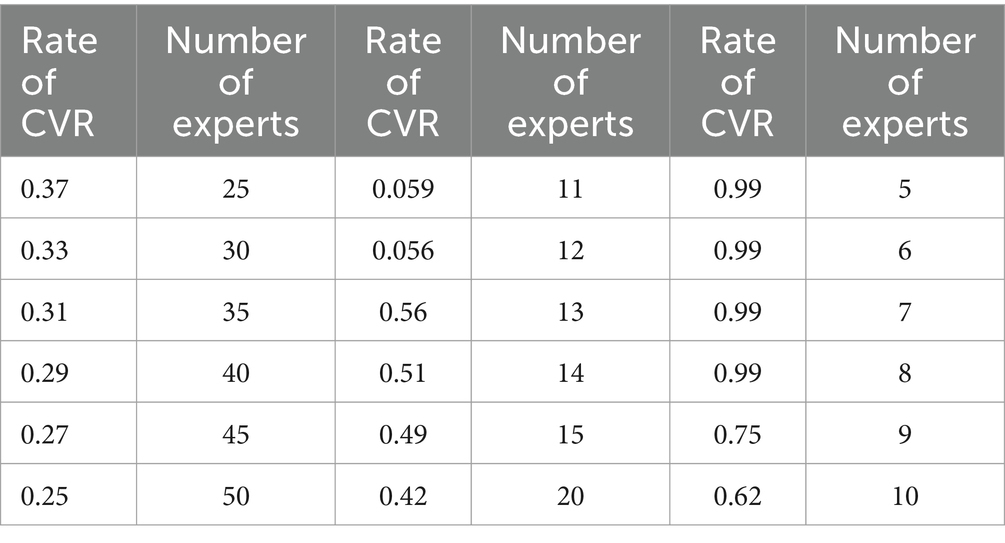
Table 2 . Content validity ratios.
3.2 Determining content validity index (CVI)
To calculate CVI, experts were asked to give their opinion based on the 4-point Likert scale, ‘Fully relevant,’ ‘requiring little change,’ ‘requiring a lot of change,’ and ‘unrelated.’ CVI was calculated for each question, and their mean was also calculated. CVI score for each phrase was calculated by dividing the number of experts agreeing to the 4 and 3 (highly relevant and requiring little change) by the total number of experts ( Haghjoo et al., 2022 ).
The questions whose CVI was lower than 0.7 were excluded. Questionnaires whose CVI was between 0.7 and 0.79 were reviewed and corrected, and they were included in the questionnaire with a slight change, and the questions whose CVI was higher than 0.79 were confirmed ( Obilor and Miwari, 2022 ). Finally, the questionnaire was examined in several stages in terms of the validity of the questions and their content, and necessary corrections were made.
To measure farm-level innovation, 90 items in 7 dimensions (education, infrastructure, market sophistication, business sophistication, knowledge and technology outputs, creative outputs, and innovative outputs) were extracted in the first stage. At this stage of the study, after investigating the face validity, CVR was evaluated. The minimum acceptable coefficient based on the number of experts in this study (24 people) is 0.37. According to the coefficients, the questions with validity less than this number were excluded from the questionnaire, and cases equal to or bigger than 0.37 were included in the questionnaire. The results are visible in Table 3 . According to the results, 11 items were excluded from the questionnaire based on this coefficient. In addition, the results indicated that the average of CVR of all dimensions (education, infrastructure, market sophistication, business sophistication, knowledge and technology outputs, creative outputs, and innovative outputs) and indices related to them are more than 0.37. This shows that all dimensions and indices related to them have good content validity to measure the status of innovation at the farm level. After investigating the CVR and removing some items, CVI was also used to determine the content validity of the questionnaire. As stated in the research method, if the value of this coefficient is less than 0.7, the item is removed, if it is between 0.7 and 0.79, it should be reviewed, and if it is bigger than 0.79, it is acceptable. According to the results of Table 3 , the CVI of three items of the remaining items was less than 0.7 and was excluded from the questionnaire. The coefficient of 26 items ranged from 0.7 to 0.79, so they were reviewed and the rest of the items were acceptable. Also, according to the results of CVI in Table 3 , dimensions of education, infrastructure, market sophistication, knowledge and technology outputs, creative outputs, and innovative outputs and indices related to them (education status, familiarity with the application of ICT, access to ICT, application of ICT, credit for equipping and renovating farms, credit for the preparation of new inputs, productivity of production factors, trademarks and patents, product innovation, process innovation, and marketing innovation) were more than 0.79. However, some of the items related to the dimension of business sophistication needed to be revisited. In general, based on this coefficient, dimensions and indices had good content validity to measure the status of innovation at the farm level. According to the results presented in Table 4 and Chart 1 , among the dimensions associated with measuring the status of innovation at the farm level, innovative outputs (product innovation, process innovation, and marketing innovation), education (farmers’ education status in technology and innovation), and infrastructure (familiarity, access, and application of ICT) exhibit high validity, as indicated by their average CVR and CVI scores. Overall, considering the total average derived from both CVI and CVR, the questionnaire demonstrates excellent validity in assessing the status of innovation at the farm level. Therefore, these indices have face and content validity for measuring the status of innovation at the farm level.

Table 3 . Questionnaire for measuring innovation status at farm level and calculating CVR & CVI.
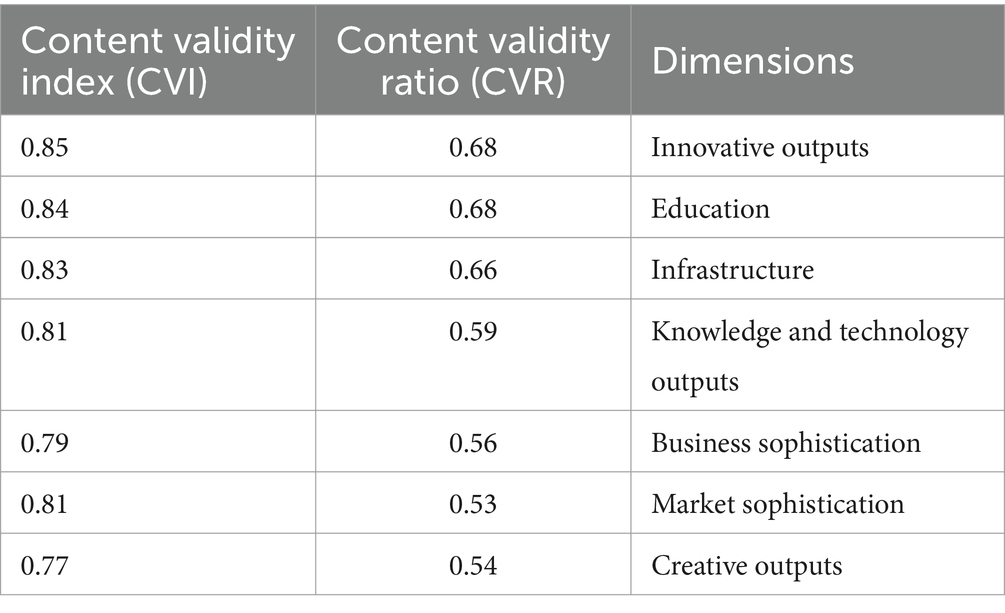
Table 4 . The average CVR and CVI for dimensions of the questionnaire to assess the status of innovation at the farm level.
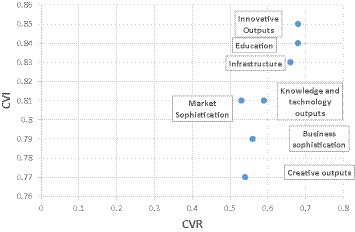
CHART 1 . The average CVR and CVI for dimensions of the questionnaire to assess the status of innovation at the farm level.
5 Discussion and conclusion
Based on the results, the validity of indices measuring the innovation status at the farm level, the indices of innovative outputs (product innovation, process innovation, and marketing innovation), education (the status of farmers’ education in the field of innovation and technology), and the infrastructure indicator (familiarity, access, and application of ICT) had the highest CVR and CVI among the extracted indices. In other words, from the viewpoint of experts, these indices are the most essential and most relevant indices for measuring the status of innovation at the farm level. These findings are consistent with the findings of Dutta et al. and Buchana and Sithole, which indicate the importance of these indices in measuring the status of innovation at the farm level ( Van Rijn et al., 2012 ; Dutta et al., 2018 ; Buchana and Sithole, 2023 ). Regarding the importance of the education indicator in measuring the status of innovation in the farm, it can be said that the development of innovation in the agricultural sector requires knowledge and expertise appropriate to such activities. The issue of lack of expertise is even concerned with the ability to use and work with smart hardware in the agricultural sector. Therefore, to improve farmers’ skills and increase their awareness, it is necessary to hold educational courses in the field of innovation and new technologies. Regarding the importance of the indicator of familiarity, access, and application of ICT infrastructures, it can be said that ICT plays a role in the development of new products and are key enabler of innovation. These infrastructures facilitate the exchange of information about innovations and new technologies and transfer them to farmers, eliminate barriers to access to new knowledge, supply new inputs, access to national and international markets to sell innovative products, and establish close relationships between businesses, suppliers, customers, and competitors, which are known as important sources of ideas for innovation. ICT generally facilitates innovation through diffusion processes, usage practices, and commercial success, and helps to solve techno-economic issues ( Dvorský et al., 2023 ; Kliestik et al., 2023 ). Indices of innovative outputs (product, process, marketing, and organization) are also important indices for measuring innovation. In other words, indices of production of a new product, new or improved modes of production, new marketing or new sales methods to increase the attractiveness of agricultural goods and services, and entry into new markets are among the important indices considered for measuring innovation at the farm level. Also, in the farmers’ education status indicator, three items (technical-educational consultations for farm participatory courses, inviting international professors to train, and sending the farmers abroad for education) were excluded because their CVR and CVI were low. The reason for the low score of these items in their view is that the experts believed that these items are not very appropriate to the conditions of education of Iranian farmers and are not implemented. Therefore, no necessity and importance lie behind the measurement of these items. In the infrastructure dimension, six items (familiarity with remote sensing systems in agricultural activities, familiarity with the application of radio wave identification systems, access to remote sensing systems, access to radio wave identification systems, application of remote sensing systems, application of radio wave identification systems in agricultural activities) were eliminated due to lack of necessity or lack of tight relation with the desired dimension. According to experts, these items also had low scores for measuring the status of innovation at the farm level, so they were excluded from the questionnaire, and the reason for the low score of these items in their views was that these facilities and infrastructure are used in a very limited level or not used at all at the level of agricultural farms in Iran. Therefore, there is no need to measure these items. In the innovative output dimension, five items (turnover due to the introduction of new product for the market, turnover due to the introduction of new crops for the farm, turnover of non-new crops and products with little change, newness of at least one innovation in the Middle East, and newness of at least one innovation at the world level) were eliminated due to lack of necessity or lack of tight relation with the desired dimension. The reason for the low score of these items in the opinion of experts and consequently the elimination of the items has been that in their opinion, these items are not suitable for measuring the status of innovation because farmers do not answer financial questions accurately. The two items “newness of at least one innovation in the Middle East” and “newness of at least one innovation at the world level” were also excluded because they are not very related to the state of farm-level innovation.
Overall, this research has addressed fundamental questions related to its objectives, resulting in the identification, localization, and validation of key indices concerning the innovation status at the farm level. It is important to note that the identified indices are deemed valid based on the analyses and calculations conducted. They can be utilized at regional, national, and international levels to assess innovation status on farms and inform planning and policy-making processes. The results indicate that these indices possess both content and face validity, making them suitable for measuring innovation status at the farm level. Indeed, the dimensions and indices introduced facilitate accurate and comprehensive measurement of farm innovation, providing farmers with valuable insights for innovation development, thereby enhancing outputs and economic productivity. Furthermore, this research has consolidated scattered and fragmented knowledge and tools for measuring farm innovation in an integrated manner. Additionally, the qualitative nature of the indices and their ease of assessment contribute to the questionnaire’s strengths, making it suitable and understandable for farmers. Moreover, these indices can be adapted by other researchers to examine innovation in other agricultural sectors, such as greenhouses. It is also likely that the dimensions and indices provided in this research can be generalized for measuring farm-level innovation in countries beyond Iran, although further validation by future researchers will be necessary. Given that one of the objectives of this research phase was to assess farm innovation status using the developed indices, utilizing the results of this questionnaire can help mitigate challenges in reviewing current innovation status and its development. Therefore, it is recommended that experts, planners, and decision-makers in the agriculture sector utilize these indices, which have been endorsed by subject-matter experts.
Data availability statement
The original contributions presented in the study are included in the article/ Supplementary material , further inquiries can be directed to the corresponding author.
Ethics statement
Ethical review and approval was not required for the study on human participants in accordance with the local legislation and institutional requirements. Written informed consent from the [patients/participants OR patients/participants legal guardian/next of kin] was not required to participate in this study in accordance with the national legislation and the institutional requirements.
Author contributions
EF: Conceptualization, Data curation, Formal analysis, Investigation, Methodology, Project administration, Resources, Software, Visualization, Writing – original draft. SC: Conceptualization, Methodology, Supervision, Validation, Writing – review & editing. MN: Conceptualization, Data curation, Resources, Validation, Visualization, Writing – review & editing.
The author(s) declare that no financial support was received for the research, authorship, and/or publication of this article.
Conflict of interest
The authors declare that the research was conducted in the absence of any commercial or financial relationships that could be construed as a potential conflict of interest.
Publisher’s note
All claims expressed in this article are solely those of the authors and do not necessarily represent those of their affiliated organizations, or those of the publisher, the editors and the reviewers. Any product that may be evaluated in this article, or claim that may be made by its manufacturer, is not guaranteed or endorsed by the publisher.
Supplementary material
The Supplementary material for this article can be found online at: https://www.frontiersin.org/articles/10.3389/fsufs.2024.1365687/full#supplementary-material
Akbari, M., Loganathan, N., Tavakolian, H., Mardani, A., and Štreimikienė, D. (2021). The dynamic effect of micro-structural shocks on private investment behavior. Acta Montan. Slovaca 26, 1–7. doi: 10.46544/ams.v26i1.01
Crossref Full Text | Google Scholar
Andrade, D., Pasini, F., and Scarano, F. R. (2020). Syntropy and innovation in agriculture. Curr. Opin. Environ. Sustain. 45, 20–24. doi: 10.1016/j.cosust.2020.08.003
Ariza, C., Rugeles, L., Saavedra, D., and Guaitero, B. (2014). Measuring innovation in agricultural firms: a methodological approach. Electron. J. Knowl. Manag . 11, 185–198.
Google Scholar
Azimi, N. A., Samandar Ali Eshtehardi, M., and Fakhremoosavi, E. (2021). The efficiency of the National Innovation System of Iran and selected countries. QJER 21, 117–149.
Bakhshayesh, M., Keshavarz, A., and Shariatmadar, M. H. Agricultural Economics Report. National Center for Agricultural and Water Strategic Studies (2020). Available at: http://awnrc.com
Bencoova, B., Grosos, R., Gomory, M., Bacova, K., and Michalkova, S. (2021). Use of biogas plants on a national and international scale. Acta Montan. Slovaca 26, 139–148. doi: 10.46544/AMS.v26i1.12
Bjerke, L., and Johansson, S. (2022). Innovation in agriculture: an analysis of Swedish agricultural and non-agricultural firms. Food Policy 109:102269. doi: 10.1016/j.foodpol.2022.102269
Buchana, Y., and Sithole, M. M. (2023). Towards a conceptual framework for measuring innovation in the agricultural sector in sub-Saharan developing countries. Afr. J. Sci. Technol. Innov. Dev. 15, 272–282. doi: 10.1080/20421338.2022.2072794
Cavdar, S. C., and Aydin, A. D. (2015). An empirical analysis of technological development and innovation indicators. Procedia Soc. Behav. Sci. 195, 1486–1495. doi: 10.1016/j.sbspro.2015.06.449
Chang-Muñoz, E., Mercado-Caruso, N., Gazabon, D. O., Segarra-Oña, M., and Osorio, S. N. (2022). Product or process innovation? The dilemma for exporting SMEs in emerging economies: the case of the Colombian Caribbean. Procedia Comput. Sci. 198, 620–625. doi: 10.1016/j.procs.2021.12.296
Cirera, X., and Muzi, S. (2020). Measuring innovation using firm-level surveys: evidence from developing countries. Res. Policy 49:103912. doi: 10.1016/j.respol.2019.103912
Creswell, J. W., and Creswell, J. D. (2017). Research design: Qualitative, quantitative, and mixed methods approaches . 4th Edition, California: Sage publications.
Crowley, F. (2017). Product and service innovation and discontinuation in manufacturing and service firms in Europe. Eur. J. Innov. Manag. 20, 250–268. doi: 10.1108/EJIM-03-2016-0027
Cruz-Cázares, C., Bayona-Sáez, C., and García-Marco, T. (2013). You can’t manage right what you can’t measure well: technological innovation efficiency. Res. Policy 42, 1239–1250. doi: 10.1016/j.respol.2013.03.012
Dehhaghi, S., Choobchian, S., Ghobadian, B., and Farhadian, H. (2022). Policy model of renewable energy development in Iran’s agriculture sector. J. Renew. Energy Environ. 9, 93–106. doi: 10.30501/jree.2022.311064.1273
Dutta, S., Lanvin, B., and Wunsch-Vincent, S. The Global Innovation Indicator, Measuring Innovation in Agriculture and Food Systems. (2018). Available at: https://www.wipo.int/edocs/pubdocs/en/wipo_pub_gii_2017-annex4.pdf
Dvorský, J., Bednarz, J., and Blajer-Gołębiewska, A. (2023). The impact of corporate reputation and social media engagement on the sustainability of SMEs: perceptions of top managers and the owners. Equilib. Q. J. Econ. Econ. Policy 18, 779–811. doi: 10.24136/eq.2023.025
Dziallas, M., and Blind, K. (2019). Innovation indicators throughout the innovation process: an extensive literature analysis. Technovation 80-81, 3–29. doi: 10.1016/j.technovation.2018.05.005
Fraser, E. D., and Campbell, M. (2019). Agriculture 5.0: reconciling production with planetary health. One Earth 1, 278–280. doi: 10.1016/j.oneear.2019.10.022
Fuglie, K., Gautam, M., Goyal, A., and Maloney, W. F. (2019). Harvesting prosperity: Technology and productivity growth in agriculture . Washington, DC, USA: World Bank Publications.
García-Granero, E. M., Piedra-Muñoz, L., and Galdeano-Gómez, E. (2018). Eco-innovation measurement: a review of firm performance indicators. J. Clean. Prod. 191, 304–317. doi: 10.1016/j.jclepro.2018.04.215
Ghazali, N., Nordin, M. S., Hashim, S., and Hussein, S. Measuring content validity: students’ self-efficacy and meaningful learning in massive open online course (MOOC) scale. In International Conference on Education in Muslim Society (ICEMS 2017) (2017) (pp. 128–133). Banten, Indonesia: Atlantis Press.
Graneheim, U. H., Lindgren, B. M., and Lundman, B. (2017). Methodological challenges in qualitative content analysis: a discussion paper. Nurse Educ. Today 56, 29–34. doi: 10.1016/j.nedt.2017.06.002
PubMed Abstract | Crossref Full Text | Google Scholar
Haghjoo, R., Choobchian, S., Morid, S., and Abbasi, E. (2022). Development and validation of management assessment tools considering water, food, and energy security nexus at the farm level. Environ. Sustain. Ind. 16:100206. doi: 10.1016/j.indic.2022.100206
Hellerstein, D., and Vilorio, D. Agricultural resources and environmental indicators, indices; EIB-208 ; U.S. Department of Agriculture, Economic Research Service: Washington, DC, USA. (2019).
Herrero, M., Thornton, P. K., Mason-D’Croz, D., Palmer, J., Benton, T. G., Bodirsky, B. L., et al. (2020). Innovation can accelerate the transition towards a sustainable food system. Nat. Food 1, 266–272. doi: 10.1038/s43016-020-0074-1
Hu, R., Skea, J., and Hannon, M. J. (2018). Measuring the energy innovation process: an indicator framework and a case study of wind energy in China. Technol. Forecast. Soc. Chang. 127, 227–244. doi: 10.1016/j.techfore.2017.09.025
Islam, N., Wang, Q., Marinakis, Y., and Walsh, S. (2022). Family enterprise and technological innovation. J. Bus. Res. 147, 208–221. doi: 10.1016/j.jbusres.2022.04.004
Ivanov, C. I., and Avasilcăi, S. (2014). Measuring the performance of innovation processes: a balanced scorecard perspective. Procedia Soc. Behav. Sci. 109, 1190–1193. doi: 10.1016/j.sbspro.2013.12.610
Janger, J., Schubert, T., Andries, P., Rammer, C., and Hoskens, M. (2017). The EU 2020 innovation indicator: a step forward in measuring innovation outputs and outcomes? Res. Policy 46, 30–42. doi: 10.1016/j.respol.2016.10.001
Keshavarz, A., Fakari Sardehayi, B., Beiki, A., Khosravi, A., Farsi, M., Malekiyan, R., et al. Challenges of the country's agricultural sector . Tehran: Agricultural Research, Education and Extension Organization, Agricultural Education Publication; (2021).
Kibiswa, N. K. (2019). Directed qualitative content analysis (DQlCA): a tool for conflict analysis. Qual. Rep. 24, 2059–2079. doi: 10.46743/2160-3715/2019.3778
Kleinheksel, A. J., Rockich-Winston, N., Tawfik, H., and Wyatt, T. R. (2020). Demystifying content analysis. Am. J. Pharm. Educ. 84:7113. doi: 10.5688/ajpe7113
Kliestik, T., Nica, E., Durana, P., and Popescu, G. H. (2023). Artificial intelligence-based predictive maintenance, time-sensitive networking, and big data-driven algorithmic decision-making in the economics of the industrial internet of things. Oeconomia Copernicana 14, 1097–1138. doi: 10.24136/oc.2023.033
Krippendorff, K. (2018). Content analysis: an introduction to its methodology (5th ed). California, CA: Sage Publications.
Lainez, M., González, J. M., Aguilar, A., and Vela, C. (2018). Spanish strategy on bioeconomy: towards a knowledge-based sustainable innovation. New Biotechnol. 40, 87–95. doi: 10.1016/j.nbt.2017.05.006
Läpple, D., Renwick, A., and Thorne, F. (2015). Measuring and understanding the drivers of agricultural innovation: evidence from Ireland. Food Policy 51, 1–8. doi: 10.1016/j.foodpol.2014.11.003
Lawshe, C. H. (1975). A quantitative approach to content validity. Pers. Psychol. 28, 563–575. doi: 10.1111/j.1744-6570.1975.tb01393.x
Lei, X., Li, J., Li, H., Yan, J., Li, P., Guo, Y., et al. (2023). Regional assessment at the province level of agricultural science and technology development in China. Agriculture 13:389. doi: 10.3390/agriculture13020389
Lema, R., Kraemer-Mbula, E., and Rakas, M. (2021). Innovation in developing countries: examining two decades of research. Innov. Dev. 11, 189–210. doi: 10.1080/2157930X.2021.1989647
Luo, Q., Miao, C., Sun, L., Meng, X., and Duan, M. (2019). Efficiency evaluation of green technology innovation of China's strategic emerging industries: an empirical analysis based on Malmquist-data envelopment analysis index. J. Clean. Prod. 238:117782. doi: 10.1016/j.jclepro.2019.117782
Maroušek, J. (2013). Use of continuous pressure shockwaves apparatus in rapeseed oil processing. Clean Techn. Environ. Policy 15, 721–725. doi: 10.1007/s10098-012-0549-3
Maroušek, J., Itoh, S., Higa, O., Kondo, Y., Ueno, M., Suwa, R., et al. (2013). Pressure shockwaves to enhance oil extraction from Jatropha curcas L. Biotechnol. Biotechnol. Equip. 27, 3654–3658. doi: 10.5504/BBEQ.2012.0143
Maroušek, J., Maroušková, A., Gavurová, B., and Minofar, B. (2023a). Techno-economic considerations on cement substitute obtained from waste refining. J. Clean. Prod. 412:137326. doi: 10.1016/j.jclepro.2023.137326
Maroušek, J., Maroušková, A., Periakaruppan, R., Gokul, G. M., Anbukumaran, A., Bohatá, A., et al. (2022). Silica nanoparticles from coir pith synthesized by acidic sol-gel method improve germination economics. Polymers 14:266. doi: 10.3390/polym14020266
Maroušek, J., Minofar, B., Maroušková, A., Strunecký, O., and Gavurová, B. (2023b). Environmental and economic advantages of production and application of digestate biochar. Environ. Technol. Innov. 30:103109. doi: 10.1016/j.eti.2023.103109
Maroušek, J., Strunecký, O., and Maroušková, A. (2023c). Insect rearing on biowaste represents a competitive advantage for fish farming. Rev. Aquac. 15, 965–975. doi: 10.1111/raq.12772
Obilor, E. I., and Miwari, G. U. (2022). Content validity in educational assessment. Int. J. Innov. Educ. Res. 10, 57–69.
OECD. OECD science, technology, and innovation outlook 2018 . Paris: OECD Publishing; (2018).
Ogundari, K., and Bolarinwa, O. D. (2018). Agricultural innovations, production, and household welfare in africa, working paper series N° 294. Abidjan, Côte d’Ivoire: African Development Bank.
Oliveira, M. D., Gomes da Silva, F., Ferreira, S., Teixeira, M., Damásio, H., Dinis Ferreira, A., et al. (2019). Innovations in sustainable agriculture: case study of Lis Valley Irrigation District, Portugal. Sustain. For. 11:331. doi: 10.3390/su11020331
Pavolova, H., Bakalár, T., Kyšeľa, K., Klimek, M., Hajduova, Z., and Zawada, M. (2021). The analysis of investment into industries based on portfolio managers. Acta Montan. Slovaca 26, 161–170. doi: 10.46544/AMS.v26i1.14
Ramayah, T., Soto-Acosta, P., Kheng, K. K., and Mahmud, I. (2020). Developing process and product innovation through internal and external knowledge sources in manufacturing Malaysian firms: the role of absorptive capacity. Bus. Process. Manag. J. 26, 1021–1039. doi: 10.1108/BPMJ-11-2019-0453
Saavedra, D., Rugeles, L., and Guaitero, B. How to ask Colombian farmers for innovation: a methodological approach. In 10th Global Network for the Economics of Learning, Innovation, and Competence Building Systems (GLOBELICS) International Conference, Hangzhou, China, November (2012) (pp. 9–11).
Taques, F. H., López, M. G., Basso, L. F., and Areal, N. (2021). Indicators used to measure service innovation and manufacturing innovation. J. Innov. Knowl. 6, 11–26. doi: 10.1016/j.jik.2019.12.001
van Galen, M. A., and Poppe, K. J. (2013). Innovation monitoring in the Agri-food business is in its infancy. EuroChoices 12, 28–29. doi: 10.1111/1746-692X.12016
Van Rijn, F., Bulte, E., and Adekunle, A. (2012). Social capital and agricultural innovation in sub-Saharan Africa. Agric. Syst. 108, 112–122. doi: 10.1016/j.agsy.2011.12.003
Vochozka, M., Horak, J., Krulický, T., and Pardal, P. (2020). Predicting future Brent oil price on global markets. Acta Montan. Slovaca 25, 375–392. doi: 10.46544/AMS.v25i3.10
Vochozka, M., Rowland, Z., Suler, P., and Marousek, J. (2020). The influence of the international Price of oil on the value of the EUR/USD exchange rate. J. Compet. 12, 167–190. doi: 10.7441/joc.2020.02.10
Webb, P., and Forum, W. E. Innovation with a purpose: The role of technology innovation in accelerating food systems transformation . World Economic Forum: Colony, Switzerland. (2018).
Yao, X., Wang, X., Xu, Z., and Skare, M. (2022). Bibliometric analysis of the energy efficiency research. Acta Montan. Slovaca 27, 505–521. doi: 10.46544/AMS.v27i2.17
Keywords: content validity index, content validity ratio, product innovation, process innovation, marketing innovation
Citation: Farsani ED, Choobchian S and Naghani MS (2024) Comprehensive identification, localization, and validation of innovation measurement indices at the farm level in Iran. Front. Sustain. Food Syst . 8:1365687. doi: 10.3389/fsufs.2024.1365687
Received: 04 January 2024; Accepted: 04 March 2024; Published: 18 March 2024.
Reviewed by:
Copyright © 2024 Farsani, Choobchian and Naghani. This is an open-access article distributed under the terms of the Creative Commons Attribution License (CC BY) . The use, distribution or reproduction in other forums is permitted, provided the original author(s) and the copyright owner(s) are credited and that the original publication in this journal is cited, in accordance with accepted academic practice. No use, distribution or reproduction is permitted which does not comply with these terms.
*Correspondence: Shahla Choobchian, [email protected]
Good manufacturing practice
This content applies to human and veterinary medicines.
Any manufacturer of medicines intended for the EU market, no matter where in the world it is located, must comply with GMP.
GMP requires that medicines:
- are of consistent high quality;
- are appropriate for their intended use;
- meet the requirements of the marketing authorisation or clinical trial authorisation.
Also on this topic
- EudraGMDP database
- Guidance on good manufacturing practice and good distribution practice: Questions and answers
GMP/GDP Inspectors Working Group
- Mutual recognition agreements (MRA)
- International collaboration on GMP inspections
- Joint Audit Programme
Regulatory expectations and GMP certificates following the-COVID-19 public health emergency
EMA, the European Commission and Heads of Medicines Agencies (HMA) have phased out the extraordinary regulatory flexibilities for medicines put in place during the COVID-19 pandemic to help address regulatory and supply challenges arising from the pandemic .
This follows the end of the COVID-19 public health emergency declared by WHO in May 2023.
On-site GMP and GDP inspections have restarted after being postponed or carried out remotely during the pandemic.
However, a considerable number of postponed inspections still need to be carried out.
The validity of GMP and GDP certificates was extended until the end of 2023. The GMP/GDP Inspectors Working Group has decided to continue the extension of the validity date until 2024 or the conclusion of the next on-site inspection, whichever comes first, except where clarifying remarks in the document state otherwise.
Meanwhile, competent authorities will perform risk-based supervision of sites, either by on-site inspections or distant assessments , and based on the outcome may continue to issue, withdraw or restrict GMP and GDP certificates, as appropriate.
The inspections will be prioritised based on risk, so that the highest priority manufacturers, such as manufacturers of sterile product and biological products , and wholesale distributors are inspected first. In addition, inspections will be prioritised depending on the date of the last inspection.
Questions about the validity date of a GMP or GDP certificate should be addressed to the competent authority that issued the certificate.
It is incumbent upon manufacturers , importers and distributors to continue complying with GMP and GDP as appropriate.
Supervisory authorities will remain vigilant to ensure the quality of medicines that are made available to patients in the EEA.
Inspections (including distant assessments) may be carried out at any time. In case of serious non-compliance , appropriate regulatory actions will be triggered.
The guidance was agreed by the GMP/GDP Inspectors Working Group coordinated by EMA. It will be updated when there is additional information available.
The Agency has a coordinating role for GMP inspections of manufacturing sites for medicines whose marketing authorisation in the EU is submitted through the centralised procedure or as part of a referral procedure.
The Agency also plays a key role in coordinating and harmonising GMP activities at an EU level. It is involved in:
- coordinating the preparation of new and revised guidance on GMP;
- ensuring common interpretation of EU GMP requirements and related technical issues;
- developing EU-wide procedures on GMP inspections and related activities;
- facilitating cooperation between Member States for inspections of manufacturers in third countries.
Marketing authorisation holders and applicants need to use EMA's IRIS system to communicate with EMA on GMP inspections requested by the Agency’s scientific committees.
Using IRIS for GMP inspections improves efficiency by harmonising and automating processes and re-using master data held by EMA. It also simplifies retrieving and reporting data.
More information on the use of EMA's IRIS system:
- IRIS system
Guidance for applicants/MAHs involved in GMP, GCP and GVP inspections coordinated by EMA
IRIS guide for applicants - How to create and submit scientific applications, for industry and individual applicants
Legal framework and guidance
These legal instruments lay down the principles and guidelines of GMP in the EU:
- Regulation No. 1252/2014 applying to active substances for human use;
- Directive 2001/83/EC and Directive (EU) 2017/1572 , applying to medicines for human use;
- Directive 91/412/EEC and Regulation (EU) 2019/6 applying to medicines for veterinary use.
- Directive 2001/20/EC and Regulation (EU) 536/2014 applying to Investigational medicinal products.
The EU GMP guidelines provide interpretation of these principles and guidelines, supplemented by a series of annexes that modify or augment the detailed guidelines for certain types of product, or provide more specific guidance on a particular topic.
The GMP / Good Distribution Practice (GDP) Inspectors Working Group provides additional interpretation of the EU GMP guidelines in the form of questions and answers (Q&As) .
Annex 1: Manufacture of Sterile Medicinal Products was revised in August 2022. It comes into operation on 25 August 2023 except for point 8.123 which is postponed until 25 August 2024.
Manufacturing authorisation
Manufacturers and importers located in the European Economic Area (EEA) must hold an authorisation issued by the national competent authority of the Member State where they carry out these activities.
They must comply with EU GMP to obtain a manufacturing or import authorisation. They can ensure that they meet all their legal obligations by following the EU GMP guidelines.
Importers are responsible to ensure that the third country manufacturer they are importing from comply with GMP.
Marketing authorisation applicants are responsible to ensure that the proposed manufacturing sites included in the marketing authorisation application comply with GMP. For more information, see section 5.2 Inspections of the Pre-authorisation guidance .
Registration of manufacturers of active substances
Manufacturers of active substances intended for the manufacture of human medicines for the EU market must register with the national competent authority of the Member State where they are located.
Active substance manufacturers must comply with GMP. In addition, the manufacturer of the finished product is obliged to ensure that the active substances they use have been manufactured in compliance with GMP.
Importers of active substances intended for the EU market are also required to register. In addition, each consignment needs to be accompanied by a confirmation by the competent authority of the country where it is produced that it conforms to GMP standards equivalent to those in the EU, unless a waiver applies.
Responsibility for inspections
In the EU, national competent authorities are responsible for inspecting manufacturing sites located within their own territories.
Manufacturing sites outside the EU are inspected by the national competent authority of the Member State where the EU importer is located, unless a mutual recognition agreement (MRA) is in place between the EU and the country concerned. If an MRA applies, the authorities mutually rely on each other's inspections.
If products are imported directly into more than one Member State from a manufacturing site outside the EU, there may be more than one national competent authority responsible for inspecting it. EMA facilitates cooperation between the authorities concerned in supervising the site.
EU competent authorities plan routine inspections following a risk-based approach, or if there is suspicion of non-compliance.
EudraGMDP is a publicly accessible EU database which contains manufacturing and import authorisations, registration of active substance manufacturers, GMP certificates and non-compliance statements.
After inspecting a manufacturing site, EU competent authorities issue a GMP certificate or a non-compliance statement, which is entered in the EudraGMDP database.
EMA chairs and provides the secretariat for the GMP/GDP Inspectors Working Group of senior inspectors appointed by all the EEA competent authorities. It meets at EMA four times a year.
The European Commission and observers from EU accession countries, mutual recognition partner authorities, the European Directorate for the Quality of Medicines and HealthCare and the World Health Organization also attend the working group's meetings.
The group provides a forum for harmonisation and discussion of common issues, such as:
- updates or amendments to the EU GMP guidelines;
- the compilation of Union procedures;
- harmonised interpretation of GMP and related requirements.
Compilation of Union procedures
EMA maintains a compilation of GMP and good distribution practice (GDP) inspection-related procedures and forms agreed by all Member States. This facilitates cooperation between EU Member States and supports harmonisation and exchange of inspection-related information.
It covers the basis for national procedures that form part of the national inspectorates' quality systems:
Compilation of Union procedures on inspections and exchange of information
EMA published the Word and PDF versions of some of the templates for the convenience of inspectorates
The forms and templates should be downloaded and saved first before being completed, using for example “Save target as” function. To report any technical issues with the form, please use the EMA Service Desk portal.
- Rapid alert notification of a quality defect / recall
- Follow-up and non-urgent information for quality defects
- Good-manufacturing-practice inspection report - Community format
Revision of template for serious GMP non-compliance
EMA's GMP/GDP Inspectors Working Group is discussing actions required after an inspection concludes that a manufacturing site does not comply with GMP, specifically where this can lead to a shortage of critical medicines . EMA has held a public consultation on an updated template for GMP non-compliance statement in 2018:
- Public consultation concerning the European Union template for good manufacturing practice (GMP) non-compliance statement
Inspections for pharmaceutical starting materials
Plasma master file (pmf) inspections.
For products derived from blood or blood plasma, EMA is responsible for coordinating inspections of the blood establishments in which collection, testing, processing, storage and distribution is carried out under the PMF certification procedure.
For more information on the PMF certification procedure, see Plasma master files .
Vaccine antigen master file (VAMF) inspections
EMA is responsible for coordinating inspections of vaccine antigen manufacturing sites under the VAMF certification procedure.
For more information on the VAMF certification procedure, see Vaccine antigens .
- Mutual recognition agreements
The EU has signed mutual recognition agreements on GMP inspections with regulatory authorities outside the EU. This allows EU authorities and their counterparts to:
- rely on each other's GMP inspections;
- waive batch testing of products on entry into their territories;
- share information on inspections and quality defects.
- The scope of each agreement differs.
More information
- GMP/GDP inspectors working group
- Questions and answers: Good manufacturing practice
- International collaboration
Related content
- Good distribution practice
- Medicine shortages
Related EU legislation
- Regulation No. 1252/2014
- Directive 2003/94/EC
- Directive 91/412/EEC
Publications
- PDA Journal: GMP oversight of medicines manufacturers in the EU
Contact point
- Regulatory and procedural guidance
Share this page
How useful do you find this page.

COMMENTS
Learn how to validate your product idea and confirm the demand for your product in the target market. Discover popular methods such as customer interviews, surveys, competitive analysis, fake door testing, prototype testing, and beta testing.
Learn how to validate your product idea with real users and avoid big failures. Find out the key steps, methods and tips for conducting market validation research, with insights from product leaders at airfocus and eDreams.
Learn how to test a new product idea for viability and feasibility in your target market using various research methods. This guide covers the definition, importance, and steps of market validation research, as well as the advantages and disadvantages of different methodologies.
Whether doing research for a business plan, start-up, or launching in a new market, the business validation process is used to help: Assess the competitive landscape. Identify customer needs. See if your product or service can meet those needs. Determine if your product is viable and profitable.
Market validation is the process of testing a product concept with its target market to see if it is worth pursuing. Learn why market validation is important, how to conduct one-on-one interviews, and what to look for in the feedback.
Securing qualitative data during your market validation research via e.g. usability testing is essential. Through one-on-one interactions, you can tailor questions to individual participants, leading to personalized insights. This level of customization helps you uncover specific nuances in user behavior and preferences.
Learn how to validate your product, service, or startup idea with 7 steps and strategies. Find out how to use customer interviews, MVPs, prototypes, and business model canvas to verify your demand and value.
June 3, 2021 28 min read. Market research is a process of gathering, analyzing, and interpreting information about a given market. It takes into account geographic, demographic, and psychographic data about past, current, and potential customers, as well as competitive analysis to evaluate the viability of a product offer.
Market validation research common mistakes. Image Source. We understand that founders and entrepreneurs can be quite eager when delving into research for their companies and products. However, it's important to remain vigilant, as this enthusiasm can sometimes lead to a few common mistakes that could throw a wrench in your plans.
3. Focus groups. Focus groups are a popular market validation method. They are done in a controlled environment with a leader guiding roundtable discussions or online surveys. You can hire a market research company to put together a focus group, or do it yourself by recruiting friends, family, or colleagues.
The Power of Prelaunch Market Validation: Outshining Traditional Market Research. Traditionally, research and market validation has been fairly straightforward given the options at hand - surveys, focus groups, user tests, etc. But what differentiates an interested interviewee from someone who will actually make a purchase come launch day?
Conducting market validation research early on in the concept validation stage of any new product will help to prevent this from happening. Find any issues before they cause expensive development errors! We hope this article turned out to be THE ULTIMATE GUIDE on market validation for you. However, if you still need more resources, these may be ...
Learn how to validate the market demand for your product or service using 11 methods, such as Google trends, landing page tests, surveys, and crowdfunding. Avoid common pitfalls and see slide examples to impress investors.
Market validation is testing your idea within real market conditions before releasing the product or service. What differentiates the idea validation process from market research is this: Validation is aimed to provide you with first, paying customers, and lay the foundation for potential growth.
Learn how to determine if there's a need for your product in your target market with market validation. This article from Harvard Business School Online provides a framework of five steps, from writing down goals and assumptions to testing your product or service.
Conducting market validation helps you create relevant products that resolve one or more pain points, satisfy users, and generate ROI. Follow the above steps to build an effective plan and collect the right insights to make intelligent decisions. EpiProdux simplifies and streamlines all aspects of market research, including market validation.
Market validation is, at its core, the process of determining whether the market has room for your idea before investing money and time into it. Market validation entails researching potential users of a new product to determine whether the product or business idea is viable in the target market. Between ideation and development, market ...
The synergy between market research and validation empowers SaaS companies to create products that truly resonate with customers and achieve long-term success in a highly competitive market. By harnessing the power of market research and validation, SaaS companies can unlock growth, profitability, and a sustainable competitive advantage. ...
Custom research: If you are researching a niche area not covered in an "off-the-shelf" market research report, you can also commission a custom market research project to fit your unique specifications. Your task will determine what form of research you need. Full reports, slices and sections, and even custom projects are available.
Use the customer validation data. In my experience, the best place to identify competitors is by asking your target audience. Since the first step of the idea validation process is customer validation, you should already have this data. Go through your interview material and survey results and look for the solutions, brands, and tools your ...
Validating Product-Market Fit in the Real World. by. Heather Myers. and. Zasima Razack. December 22, 2022. SvetaZi/Getty Images. Summary. To test new products, most companies rely on creating ...
In summary, market research and idea validation are crucial for mobile app success because they help you understand your target audience, identify market opportunities, stay up-to-date on industry trends, and understand the competition. By conducting these activities before starting development, you can increase the chances of your app being ...
Market Research and Surveys. Validity is important in market research and survey studies to ensure that the survey questions effectively measure consumer preferences, buying behaviors, or attitudes towards products or services. Validity assessments help researchers determine if the survey instrument is accurately capturing the desired ...
Product validation testing is a process that ensures a product aligns precisely with its intended specifications and meets the real needs of its users. It's a crucial step in transforming ideas into functional solutions that cater to market demands and customer expectations. The product validation process confirms and validates the practicality ...
This validation process was conducted quantitatively and qualitatively through surveys of subject-matter experts in Iran, and by calculating the content validity ratio (CVR) and content validity index (CVI). To measure innovation at the farm level, 90 items across 7 dimensions (education, infrastructure, market sophistication, business ...
The validity of GMP and GDP certificates was extended until the end of 2023. The GMP/GDP Inspectors Working Group has decided to continue the extension of the validity date until 2024 or the conclusion of the next on-site inspection, whichever comes first, except where clarifying remarks in the document state otherwise.